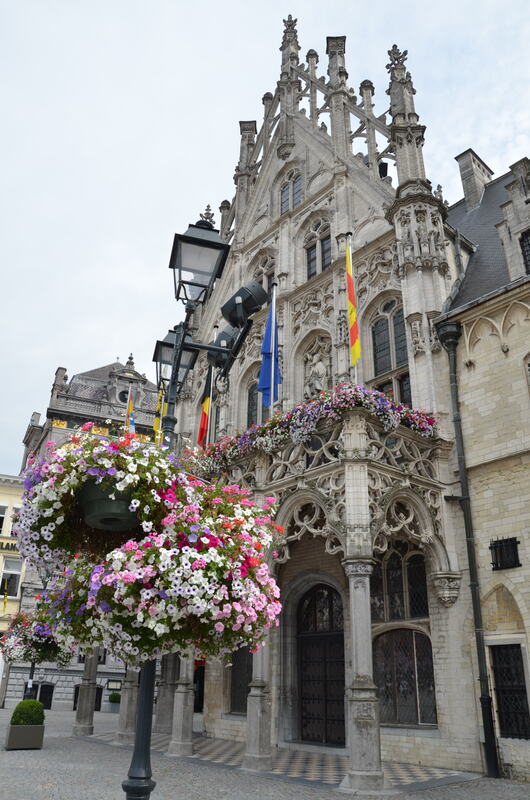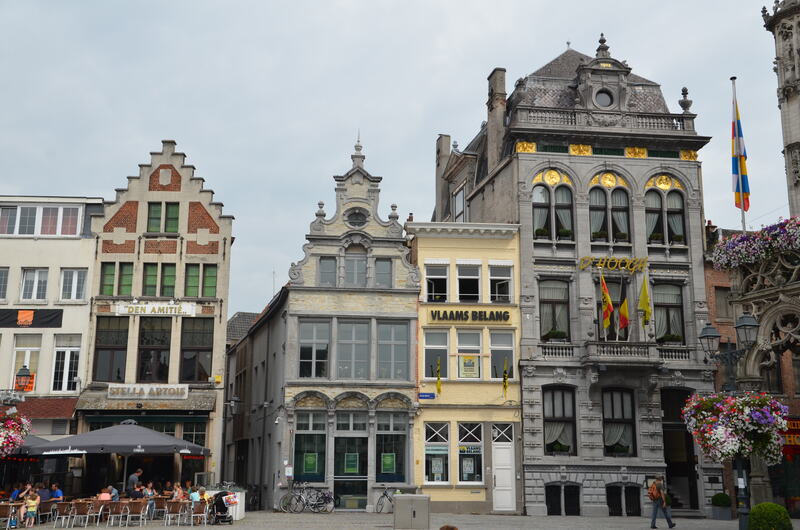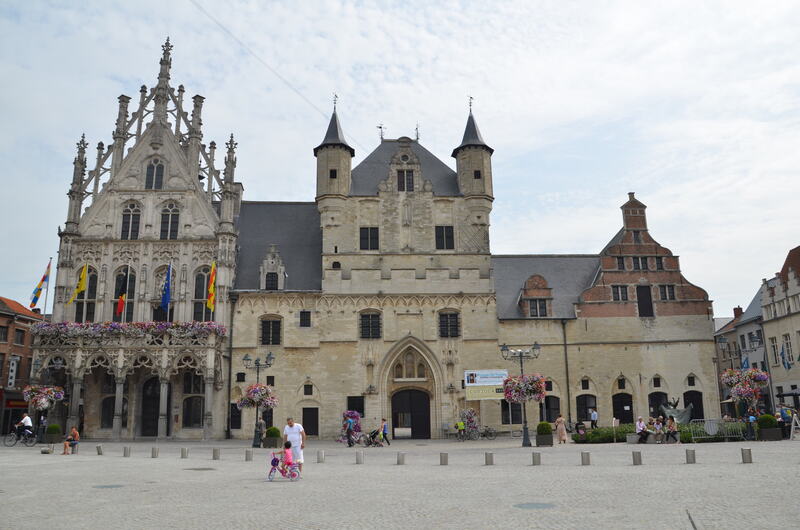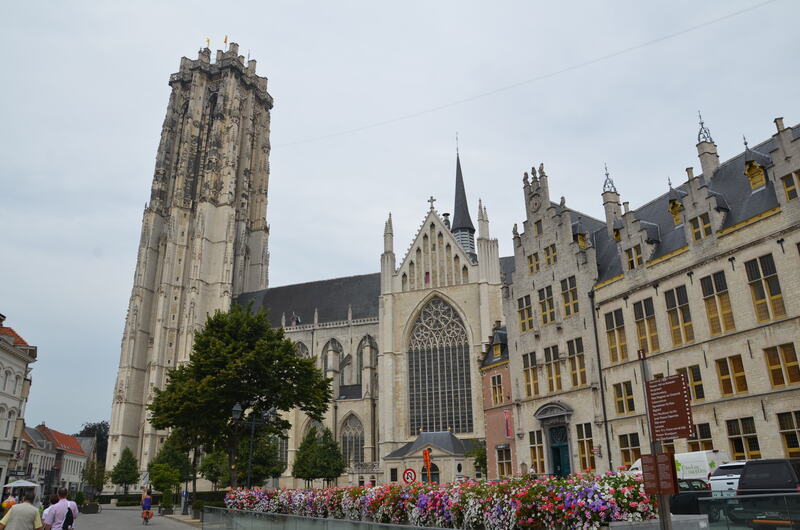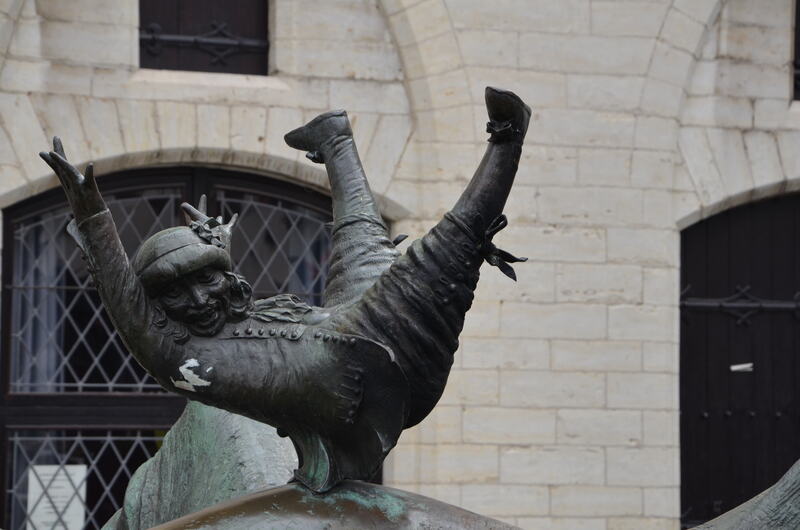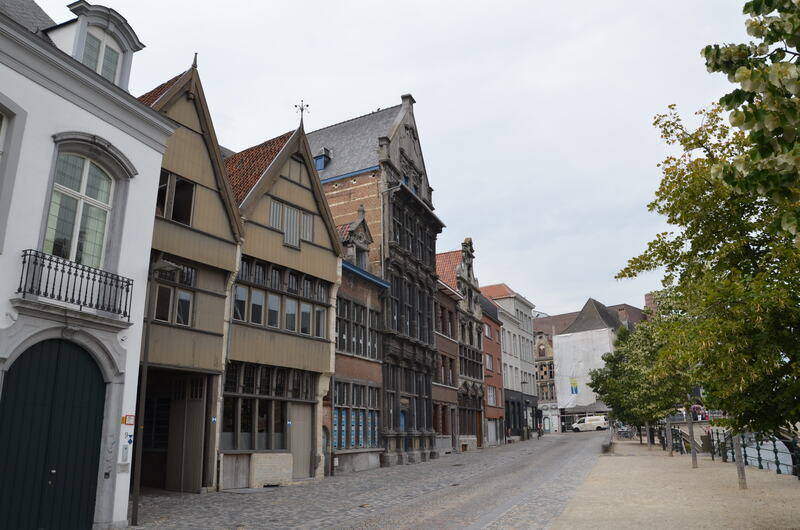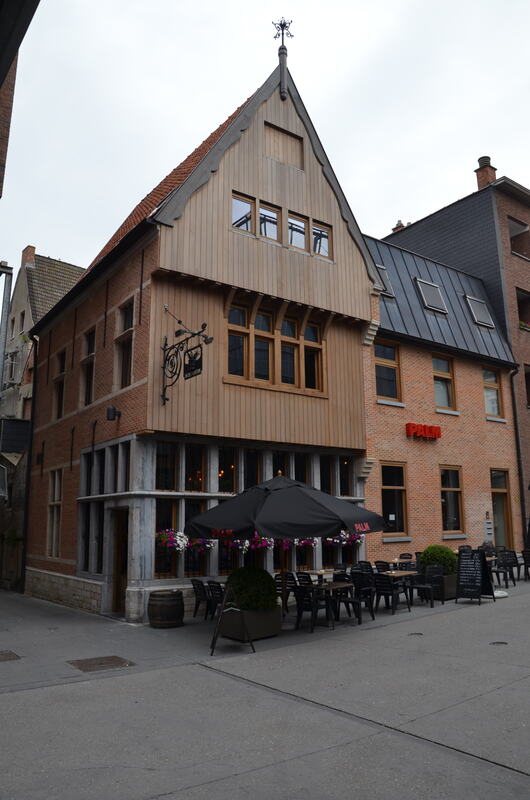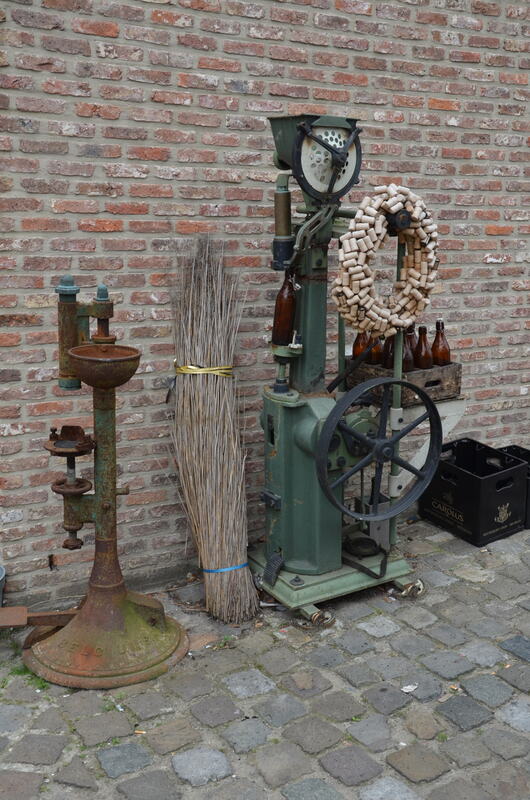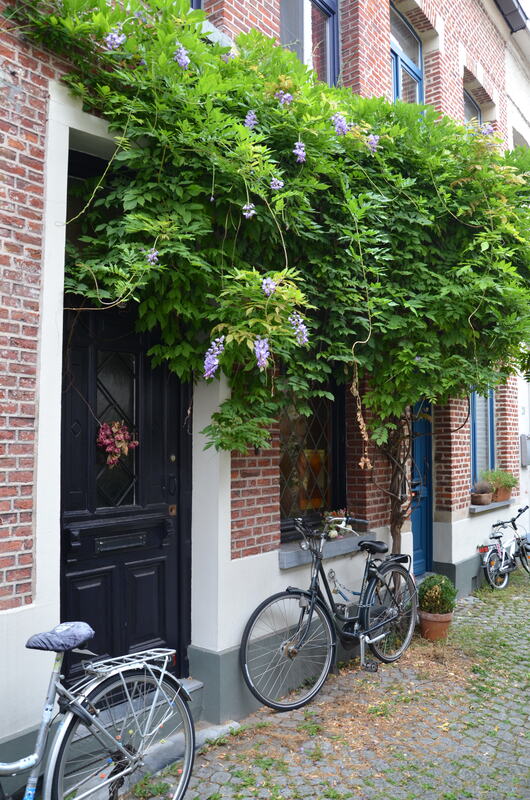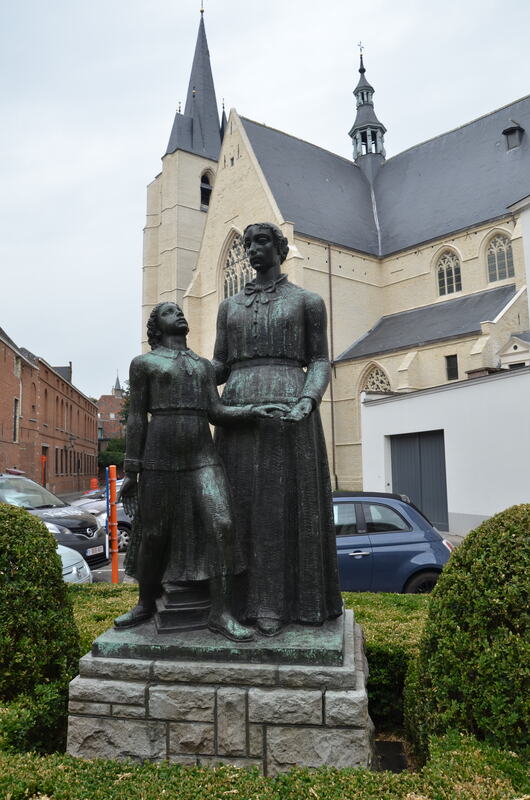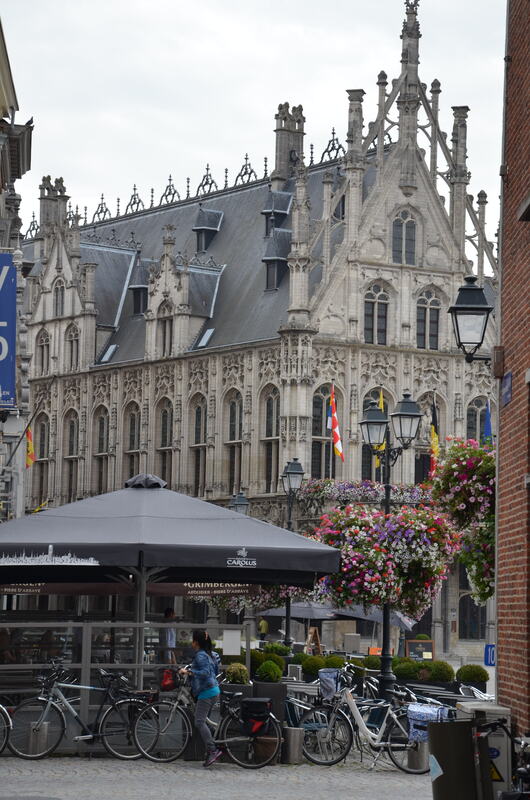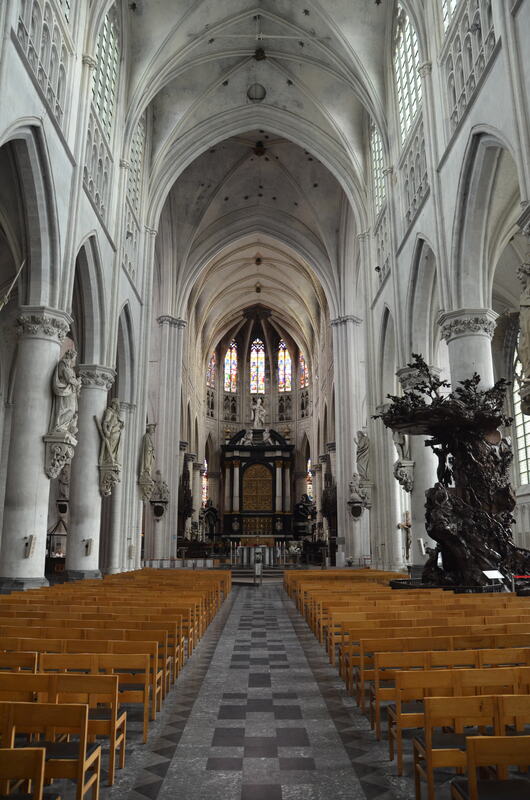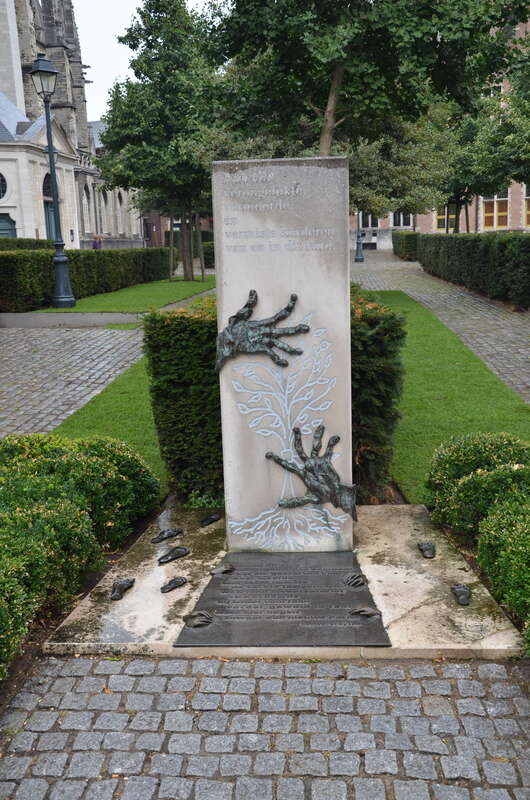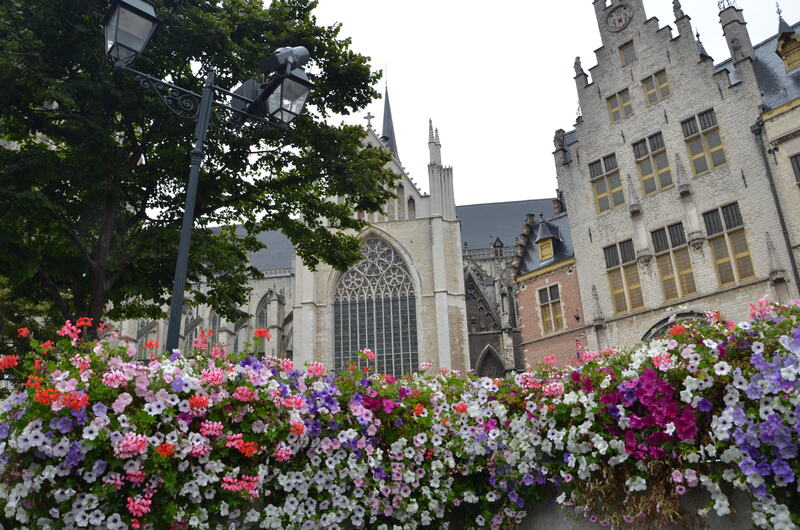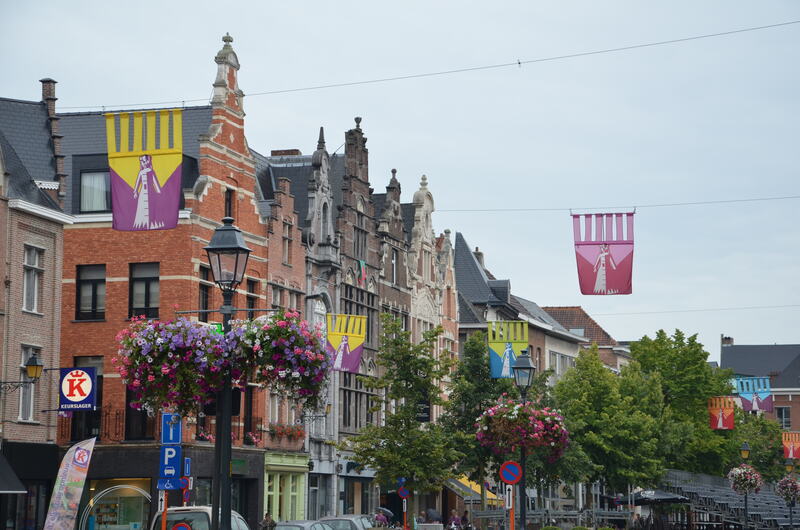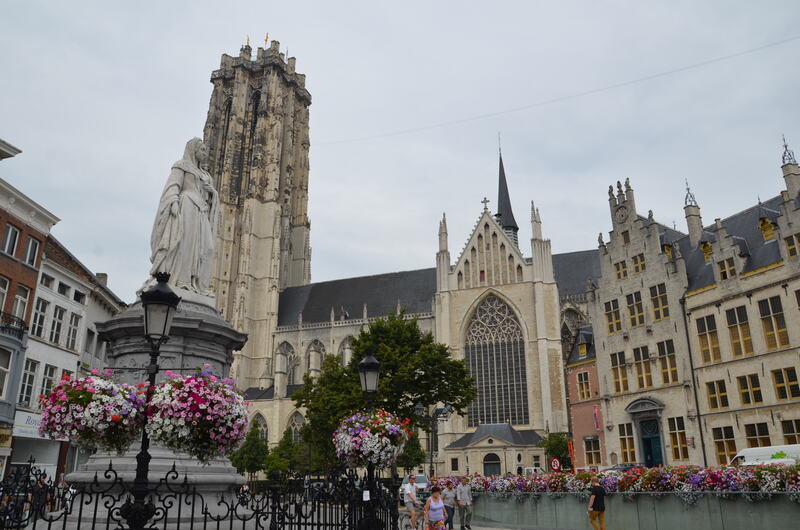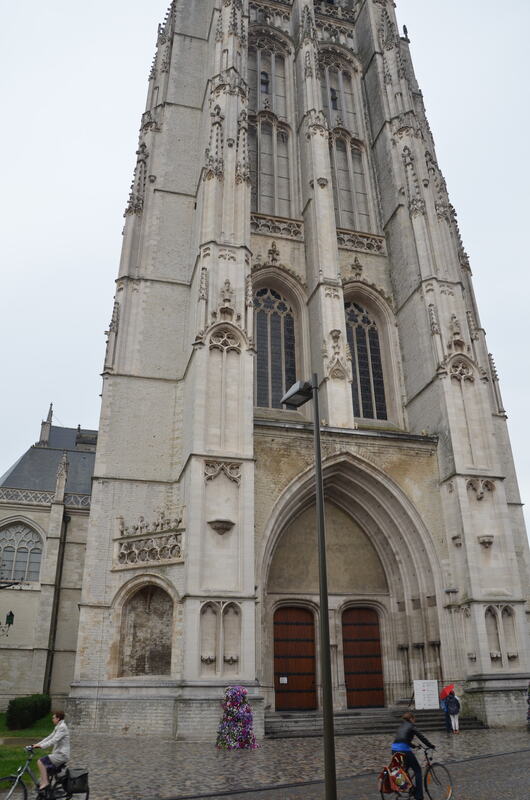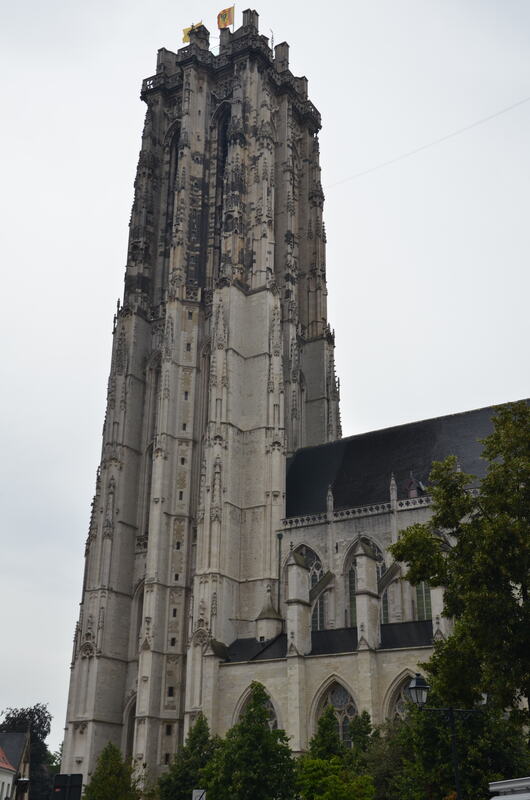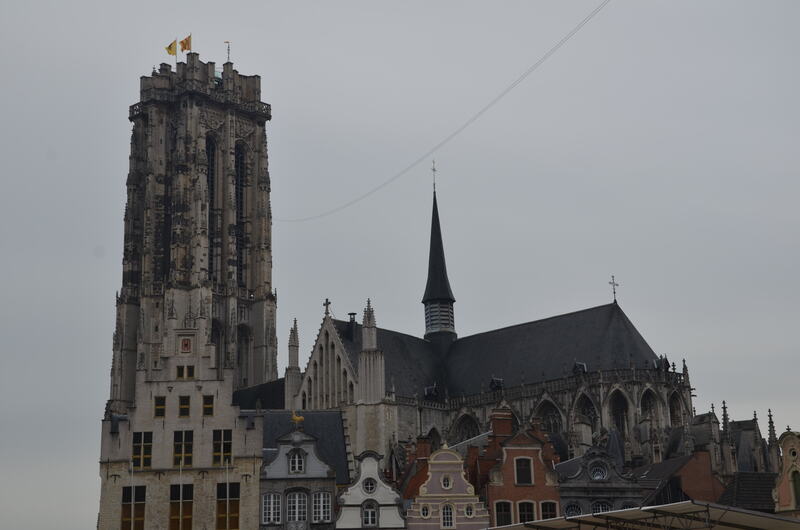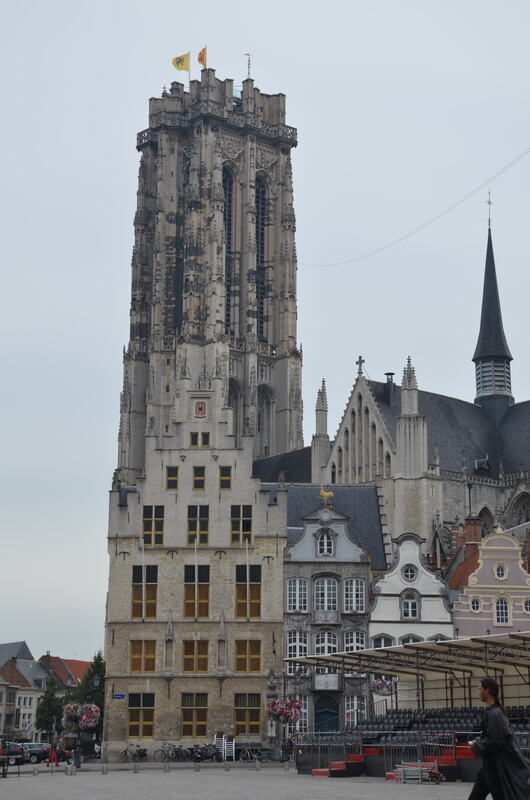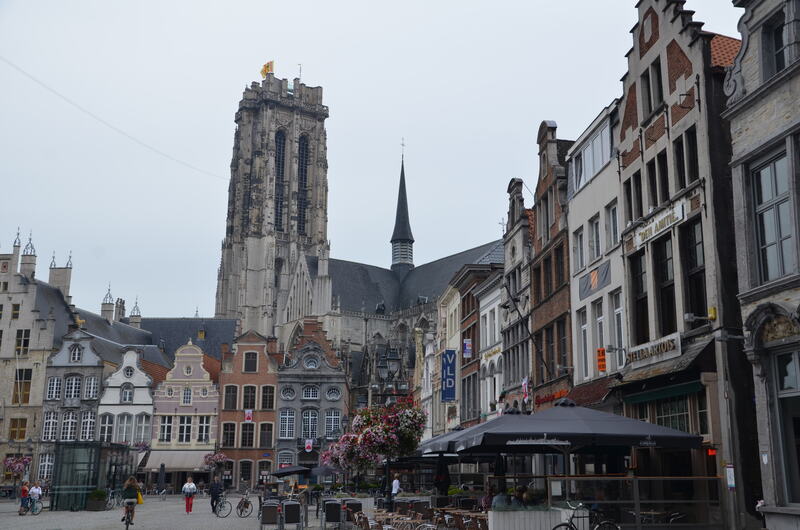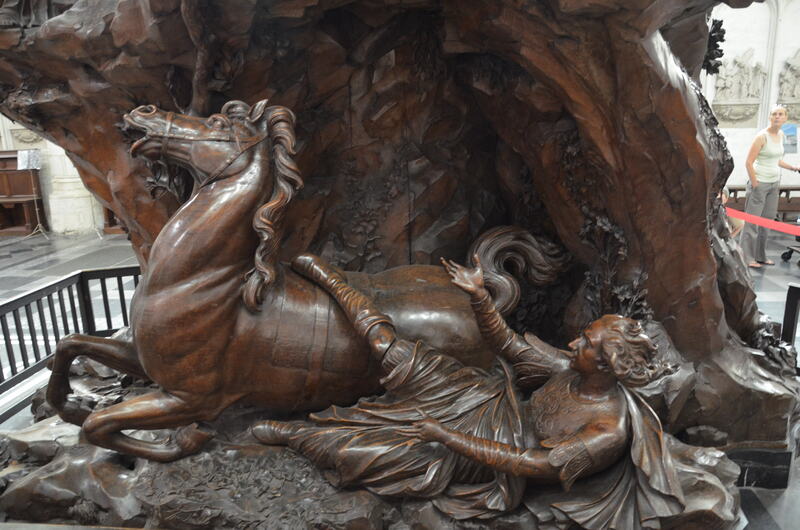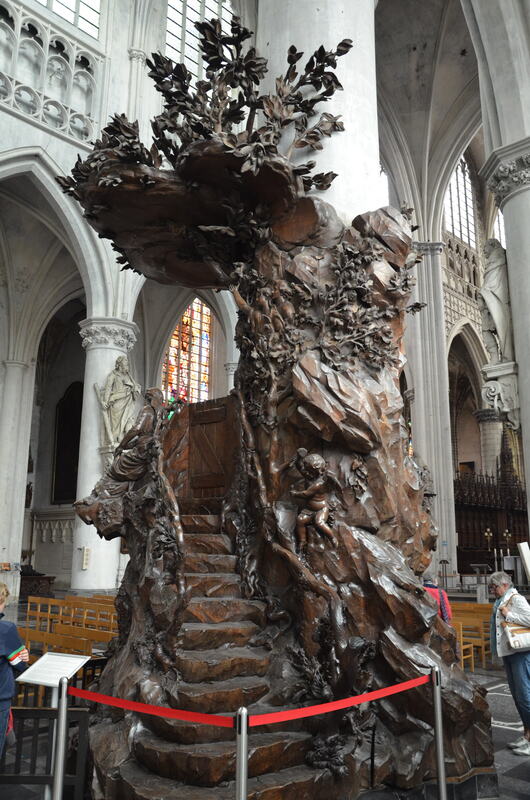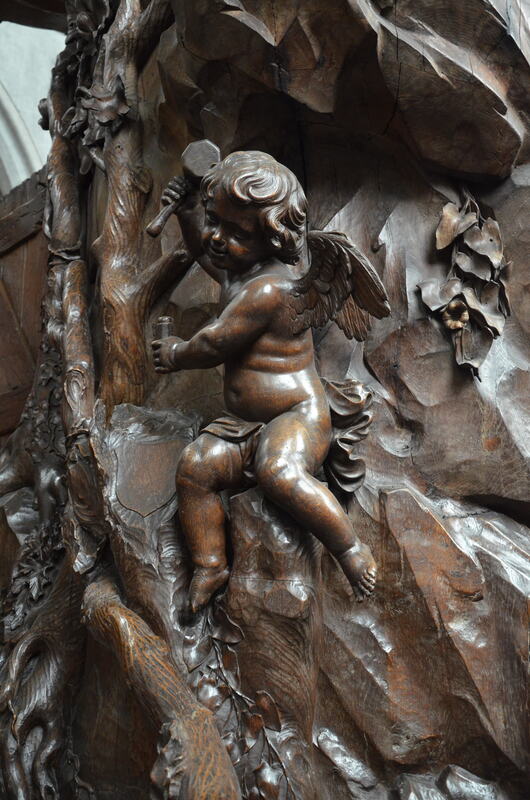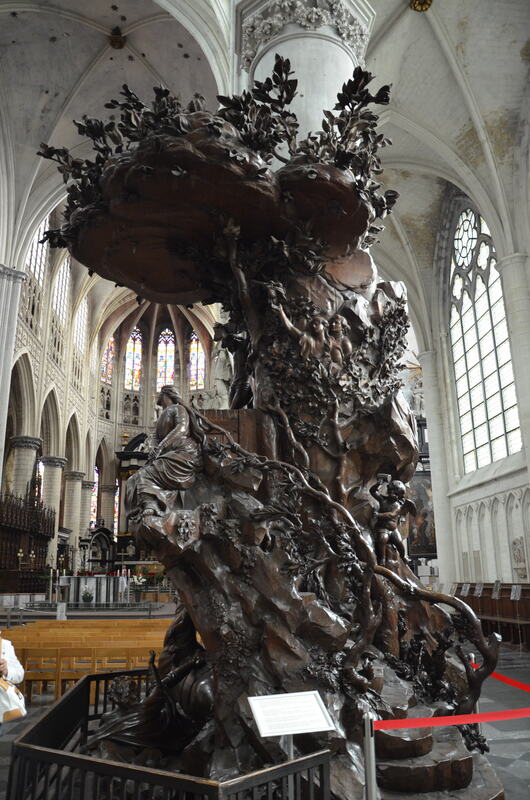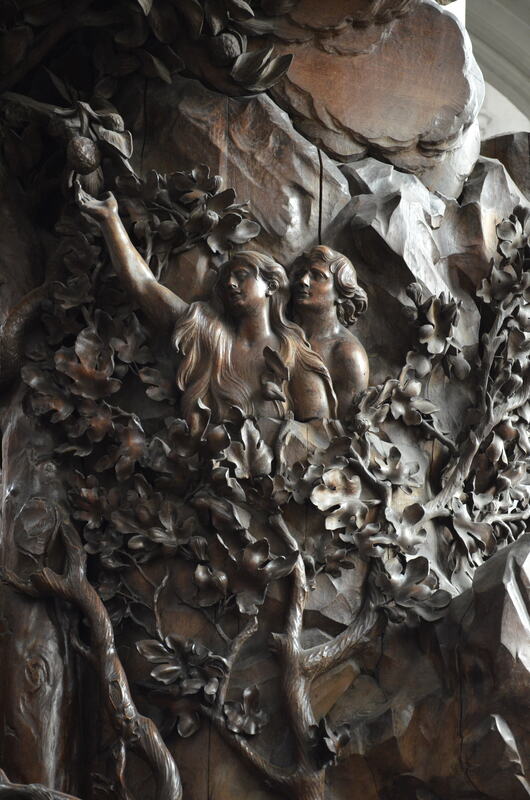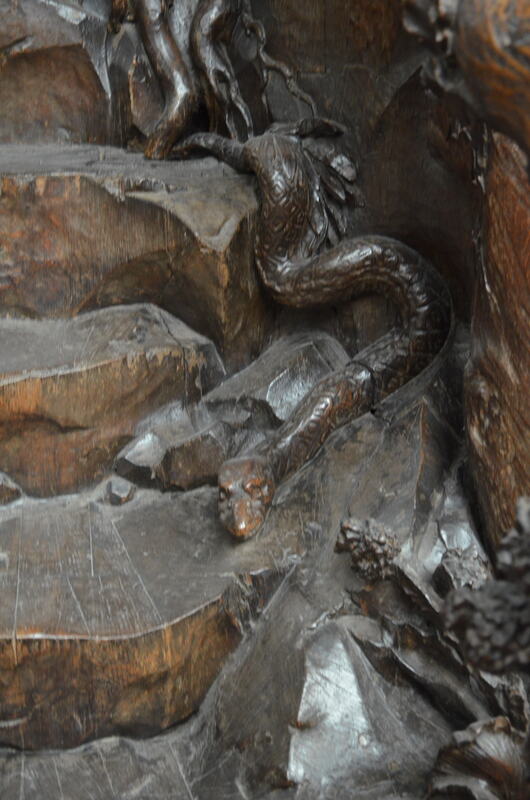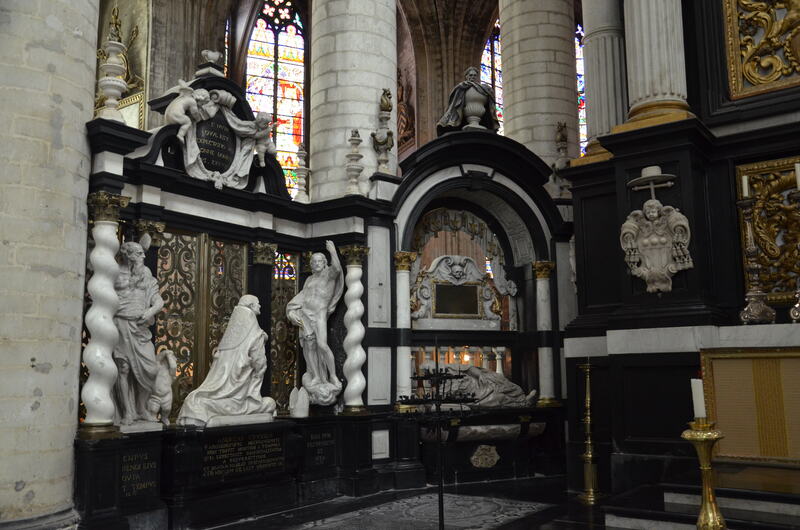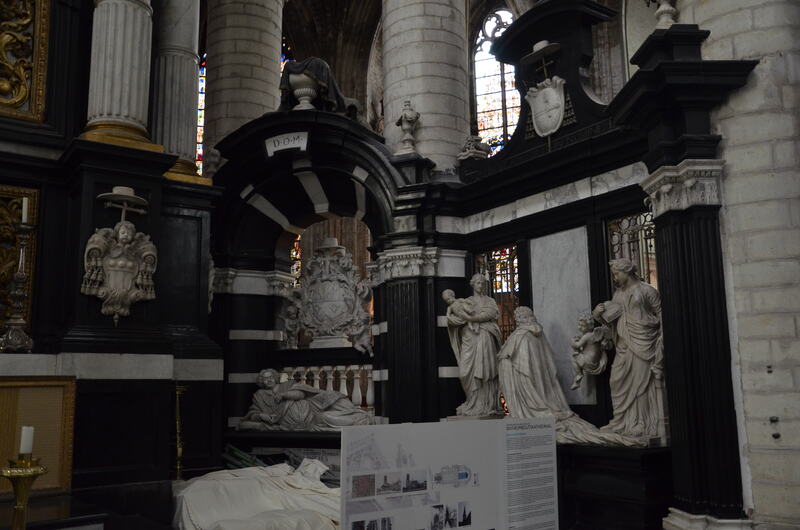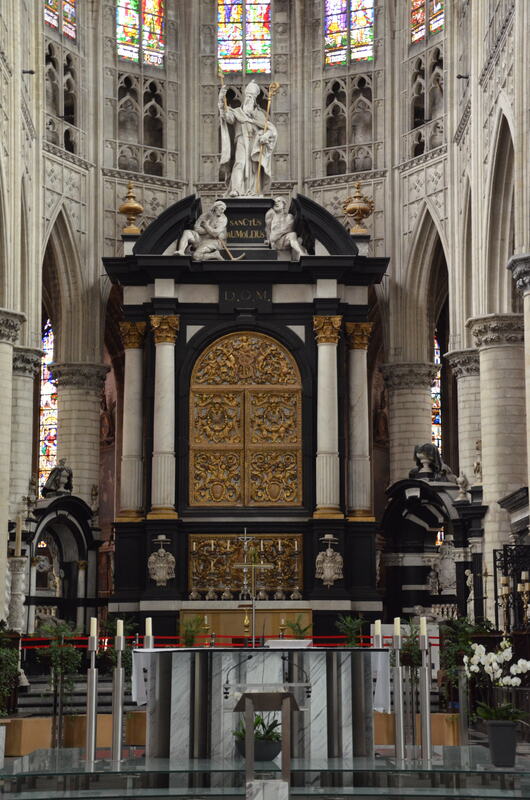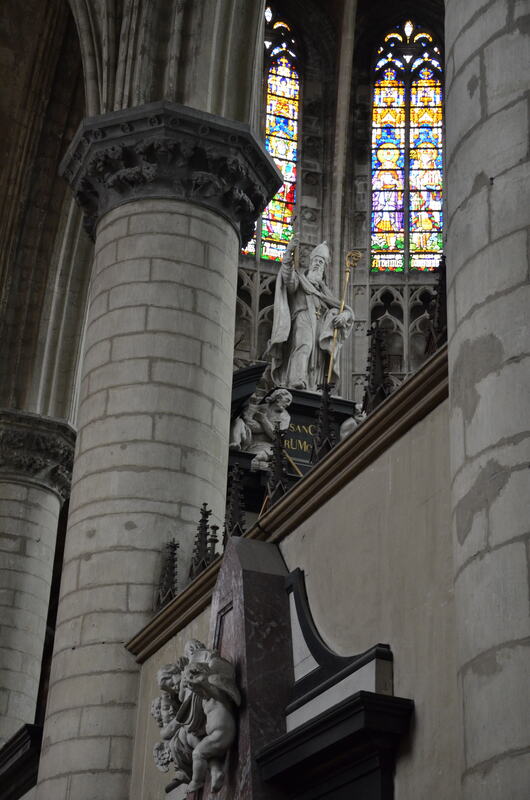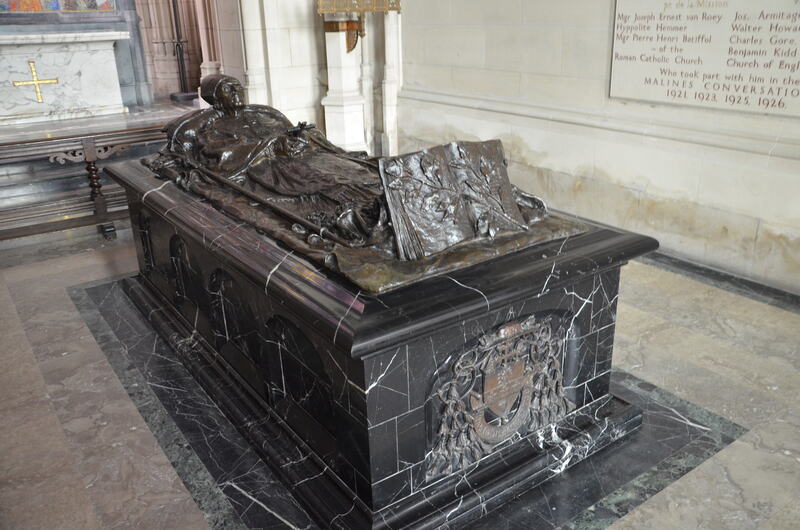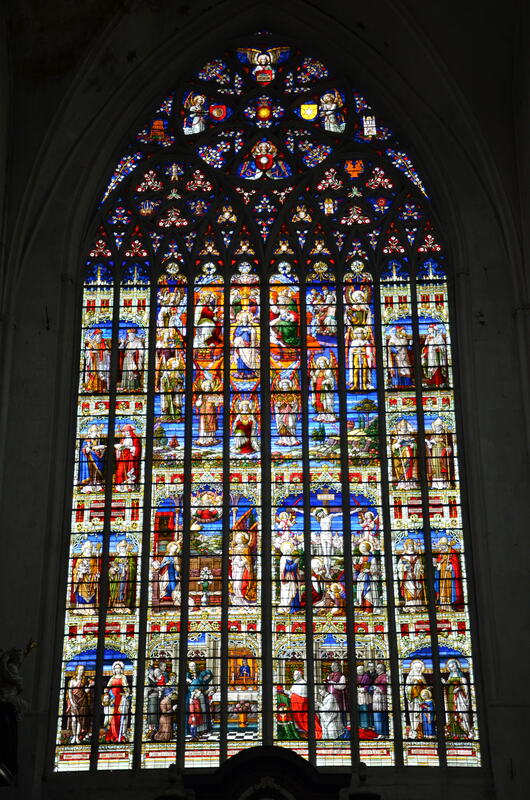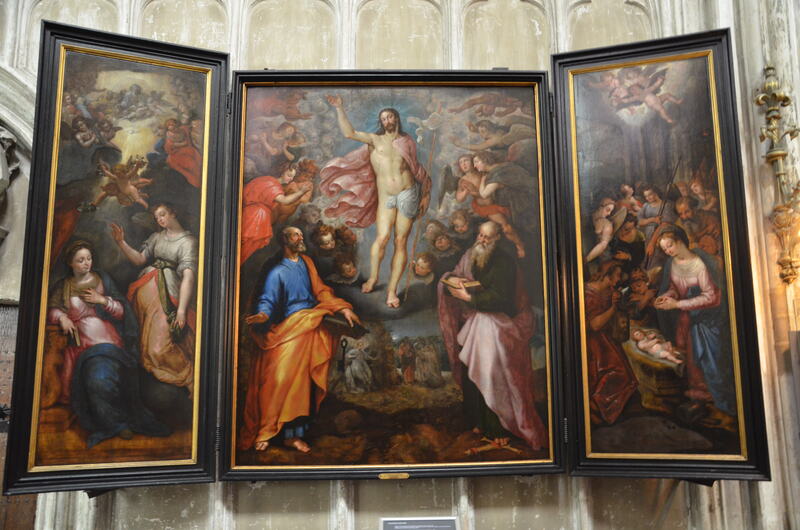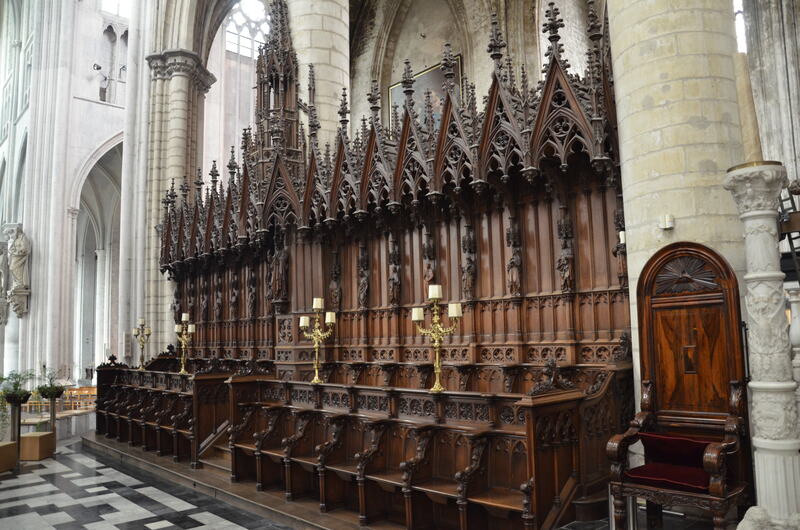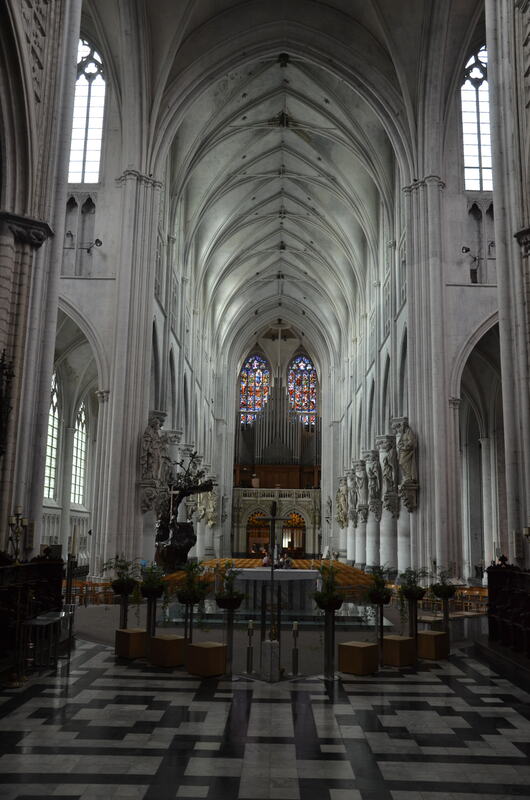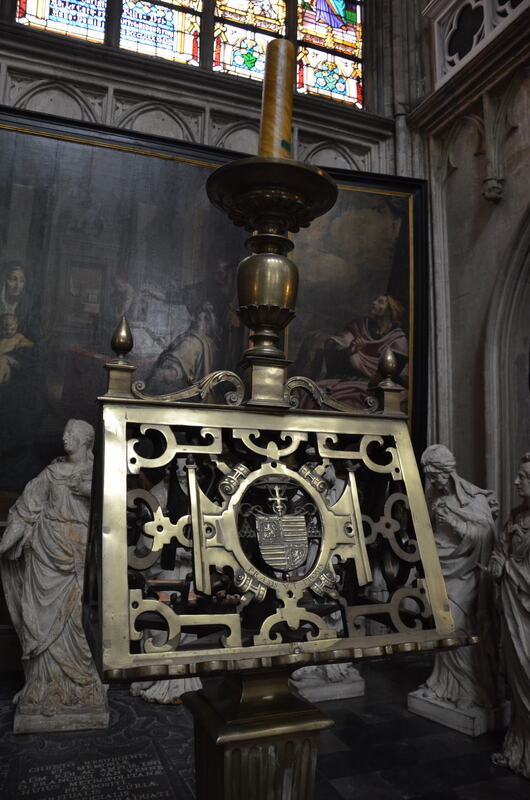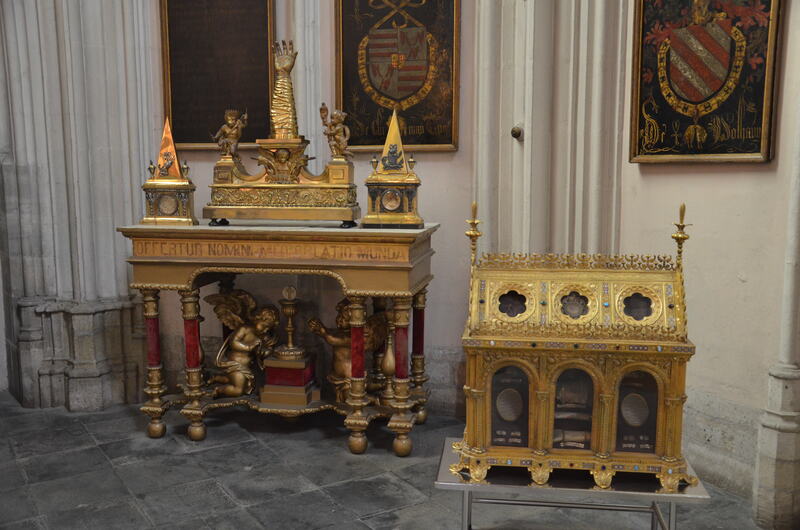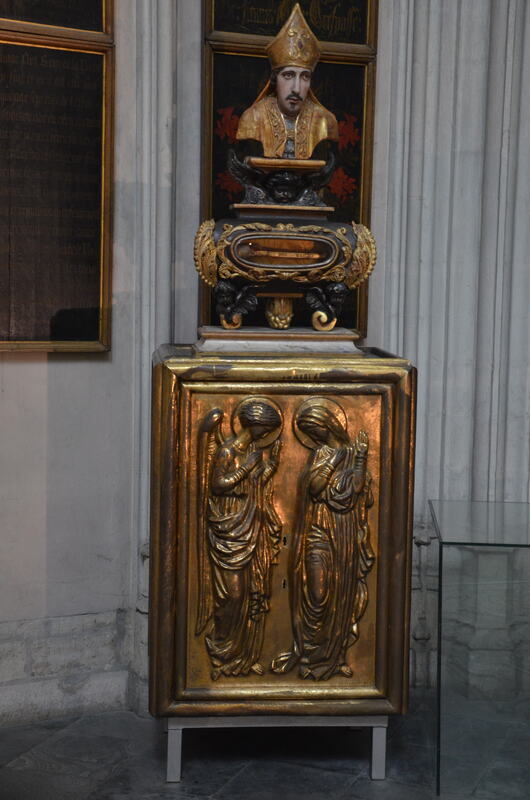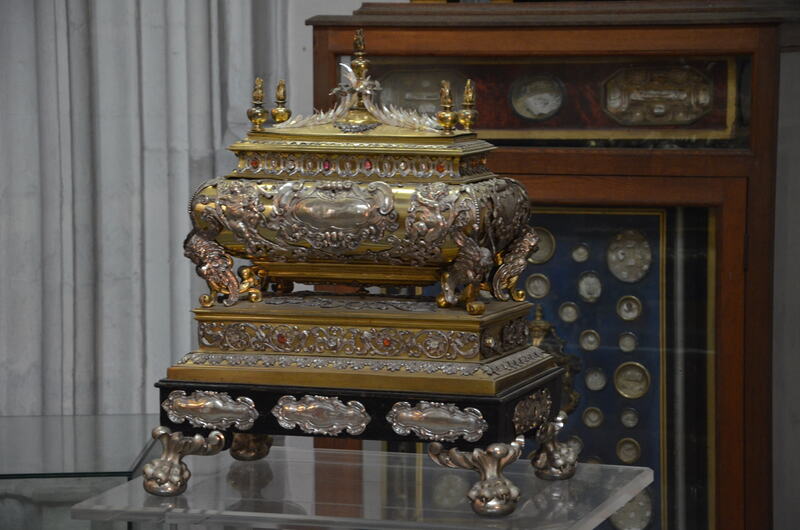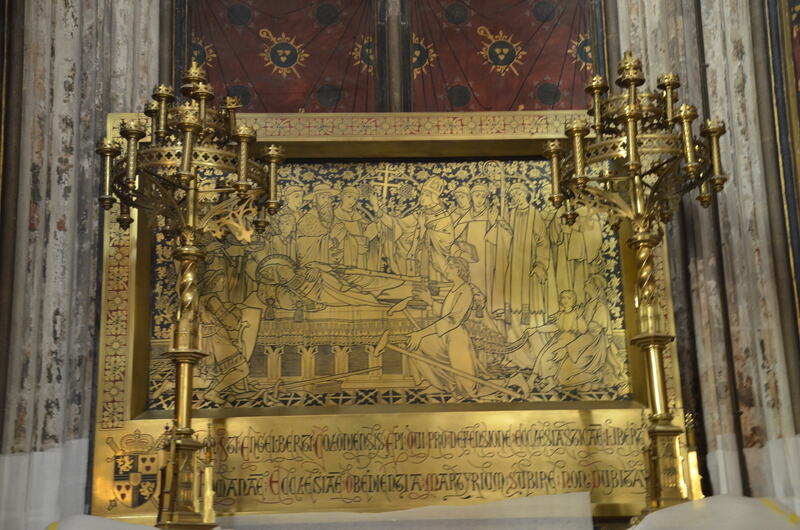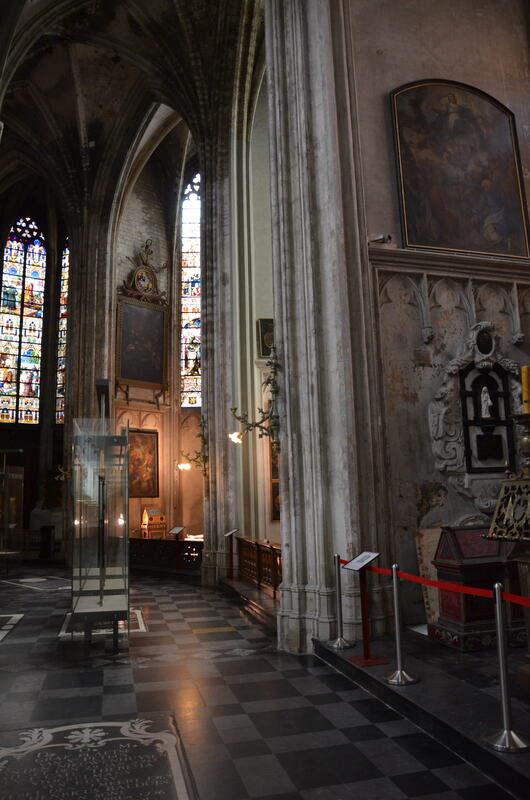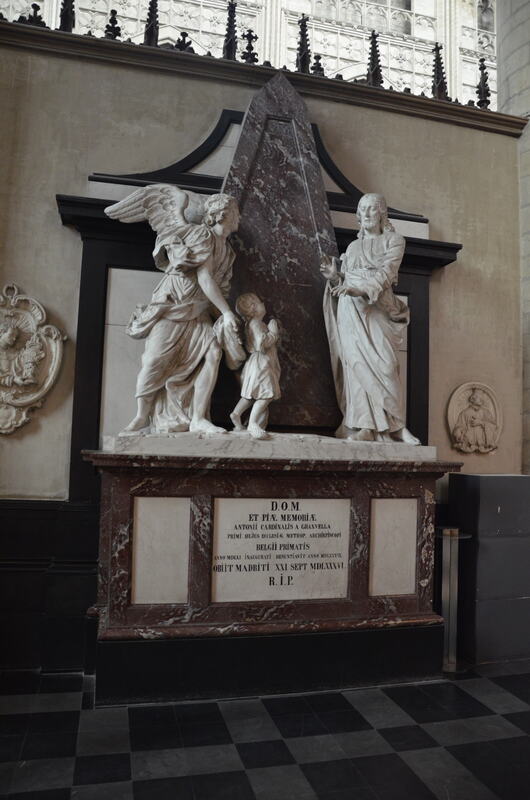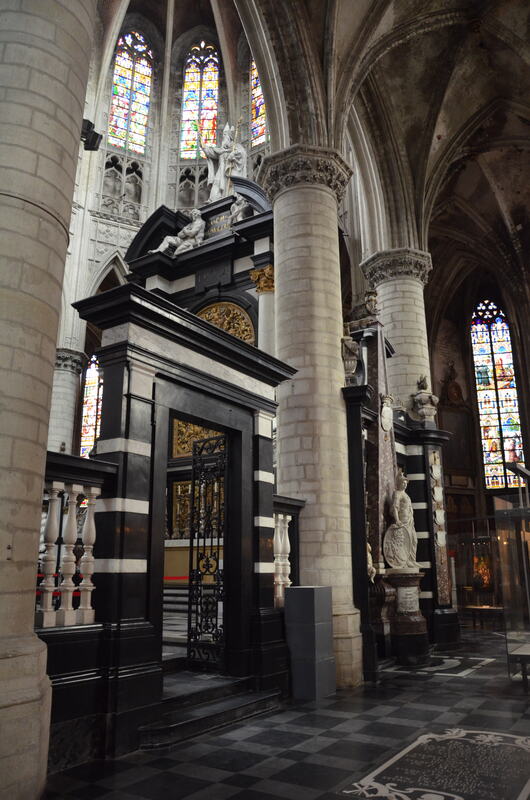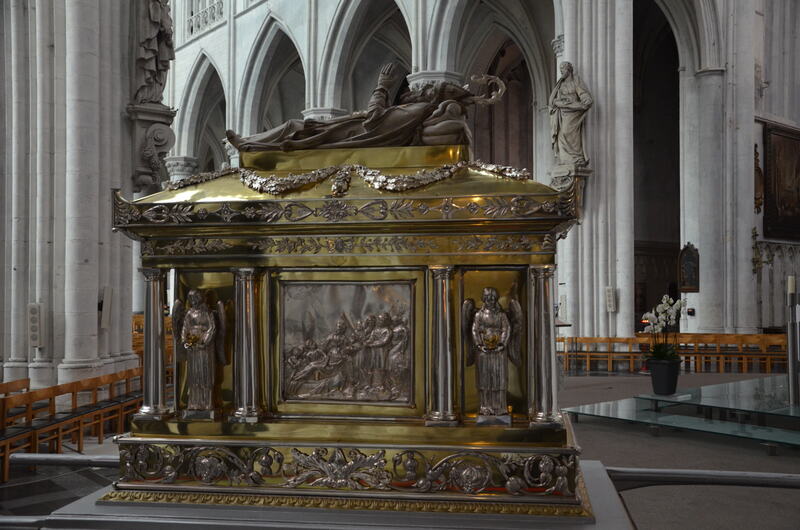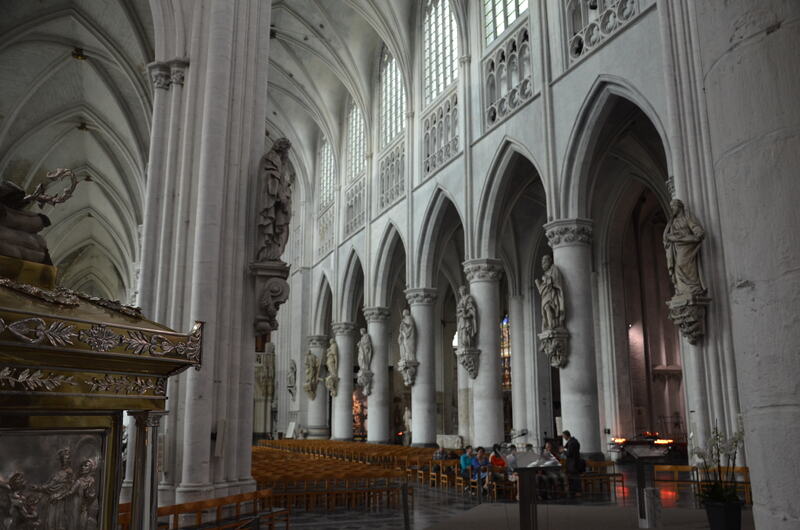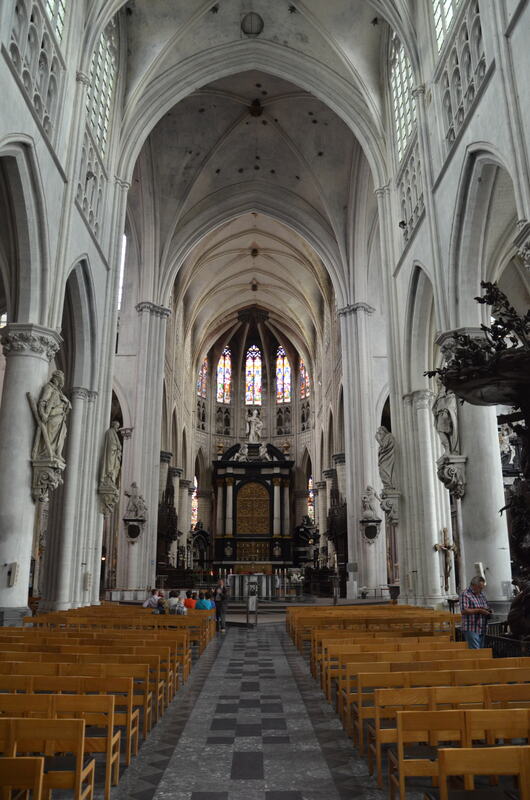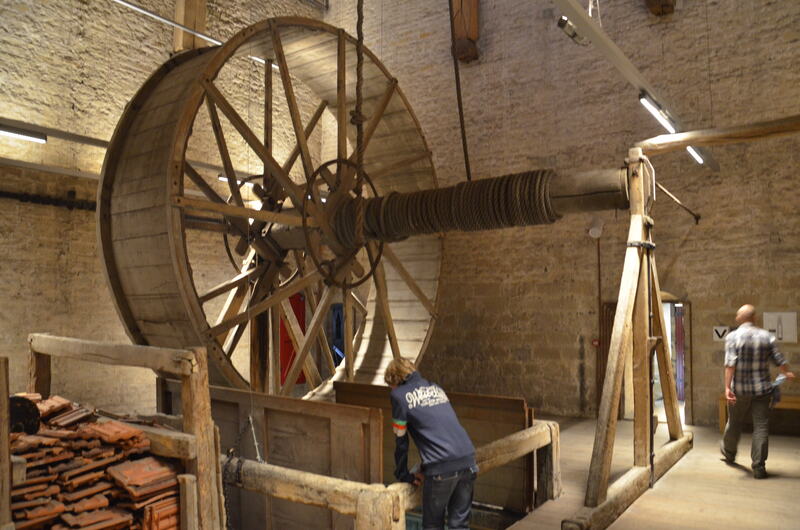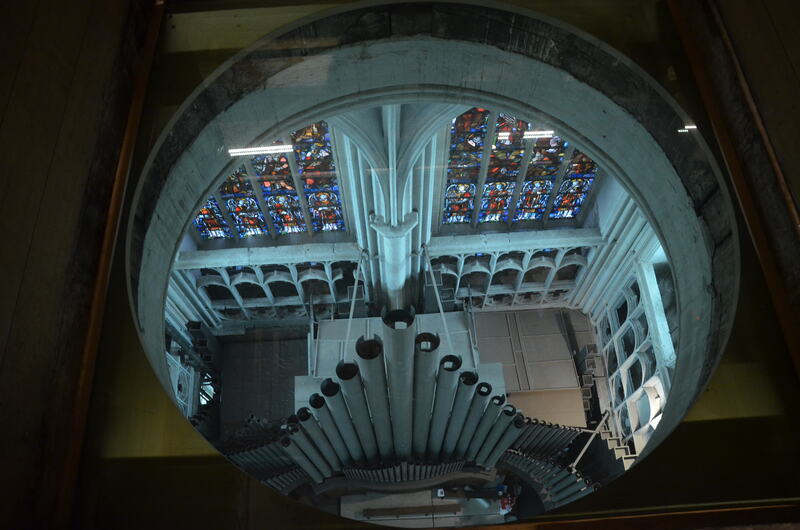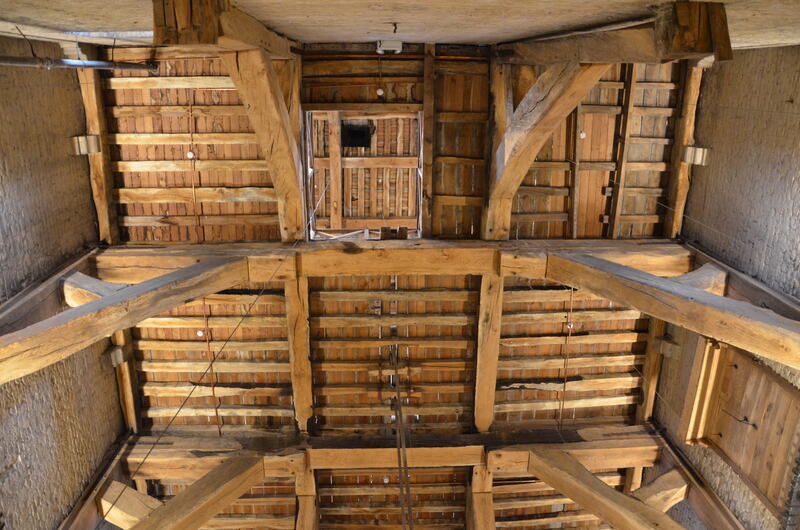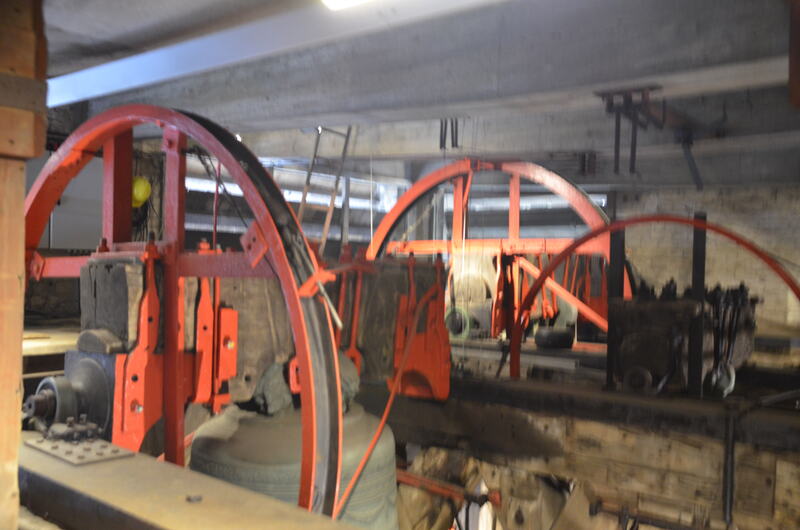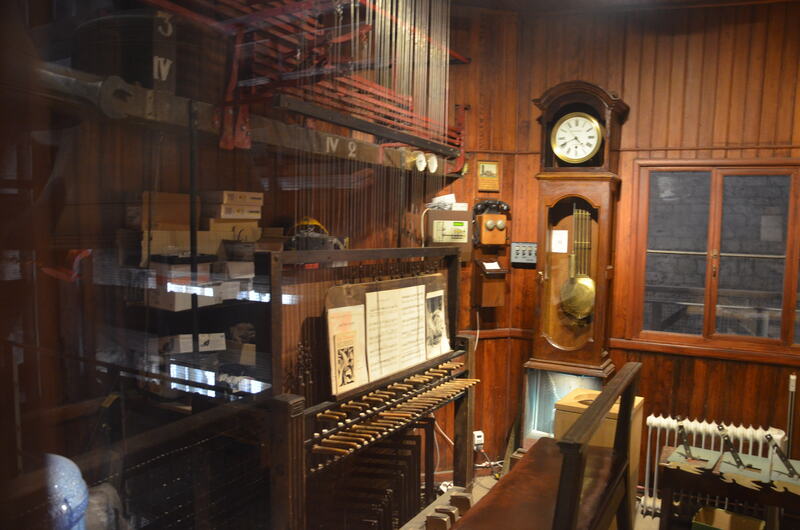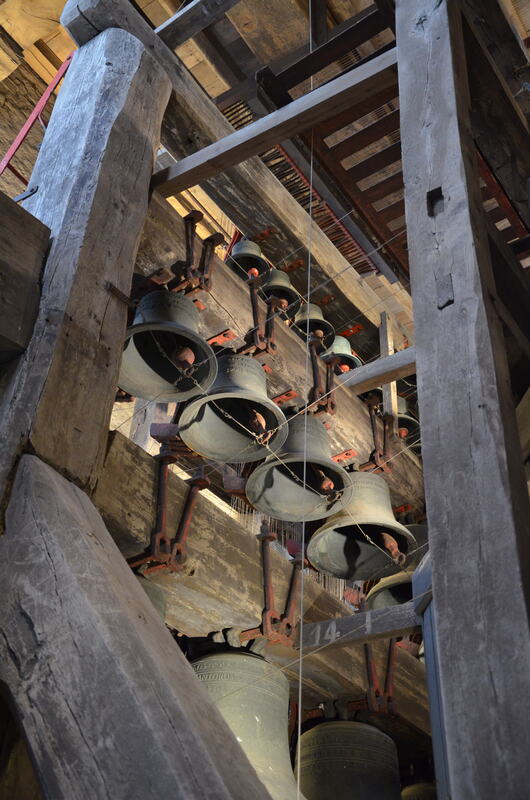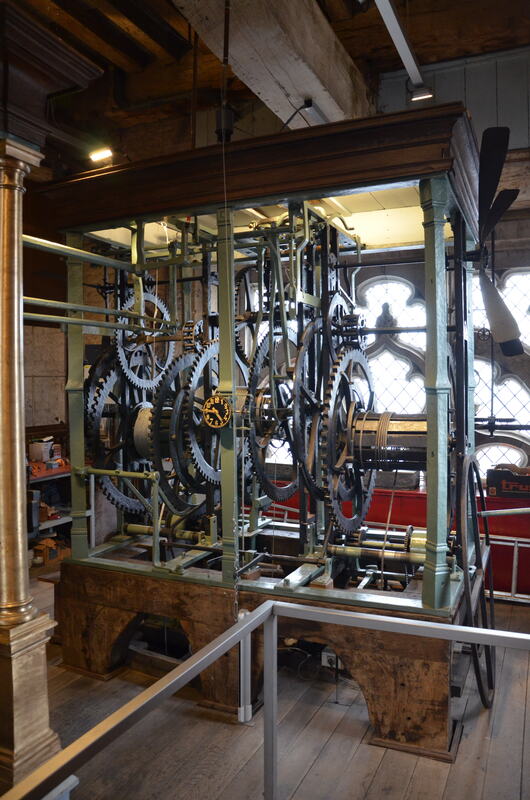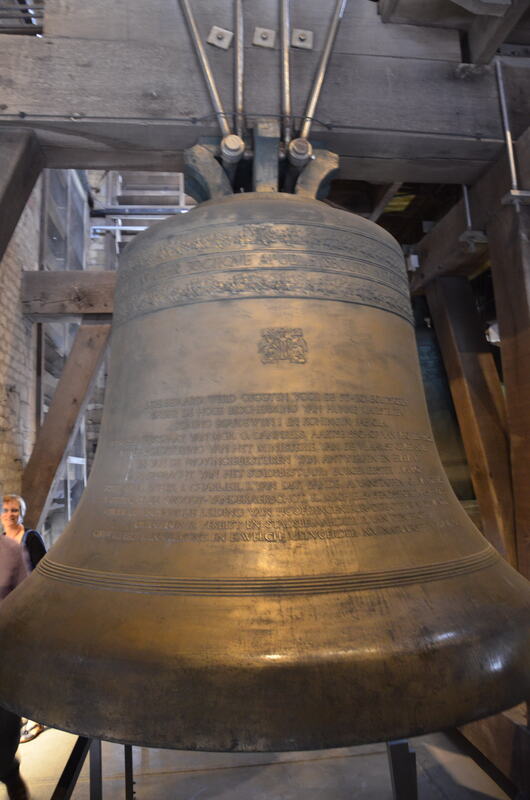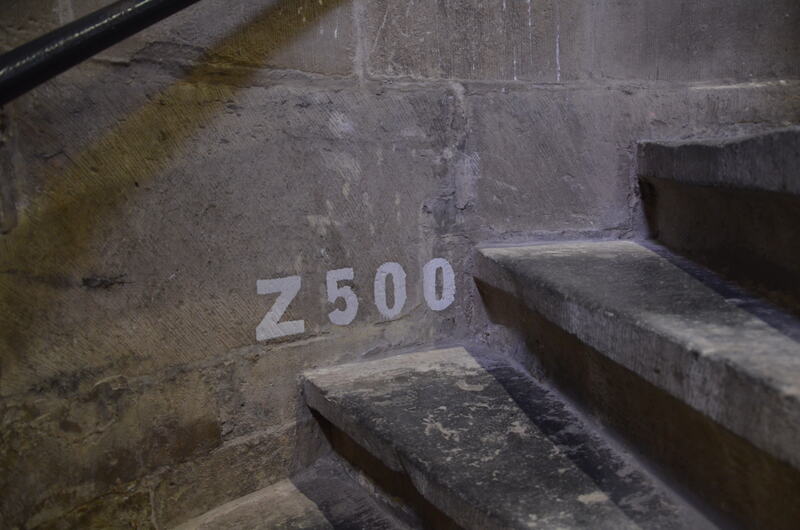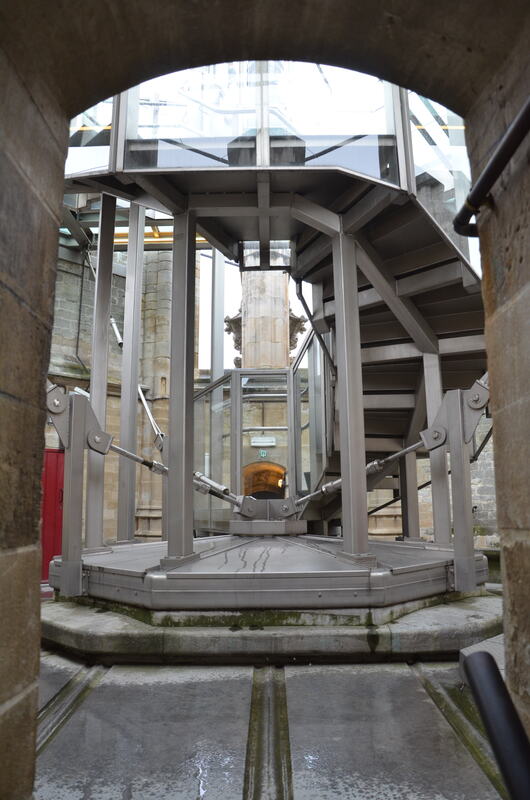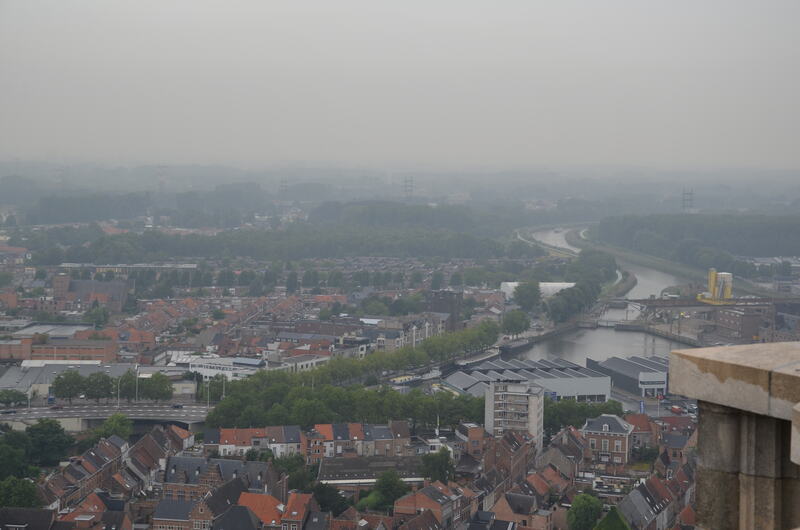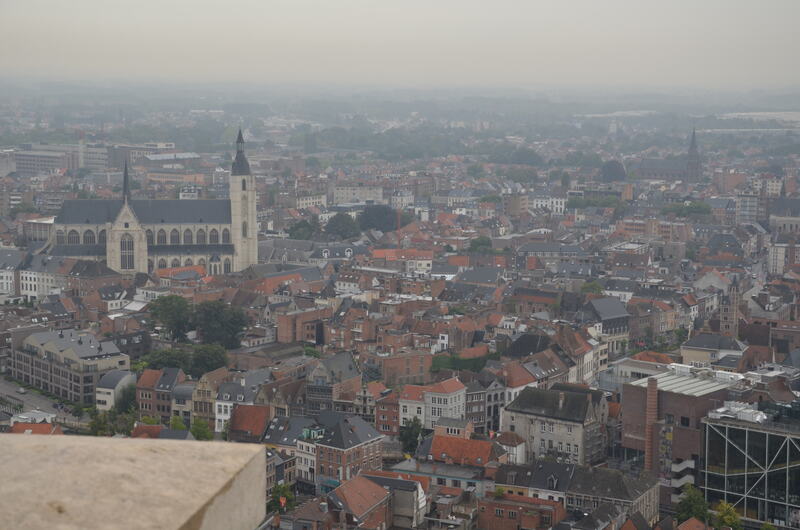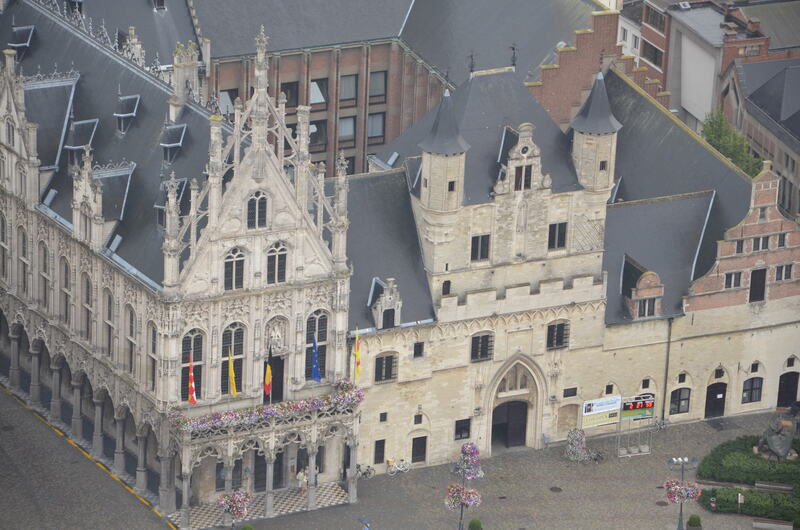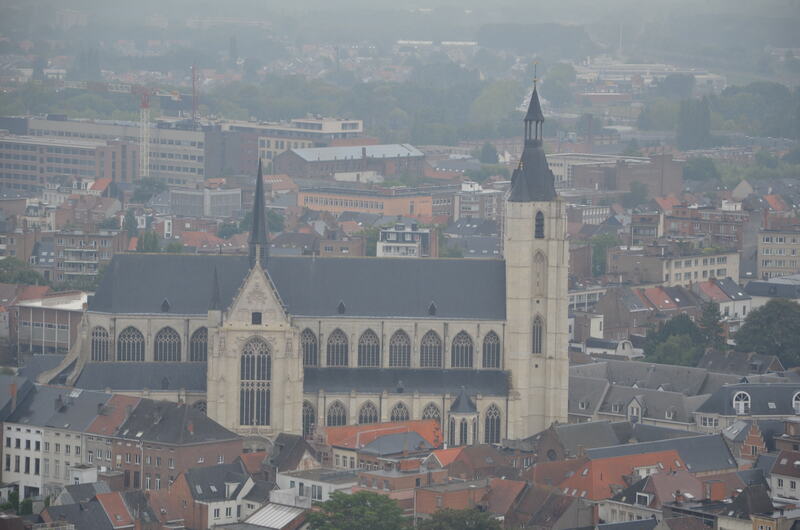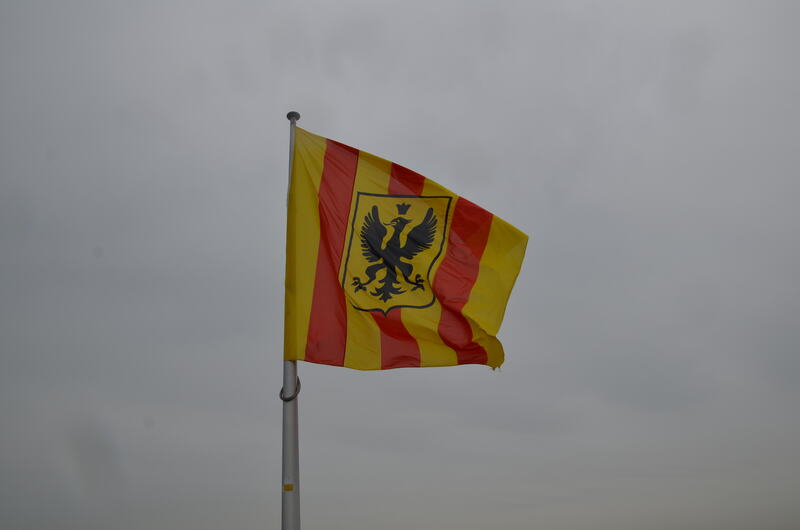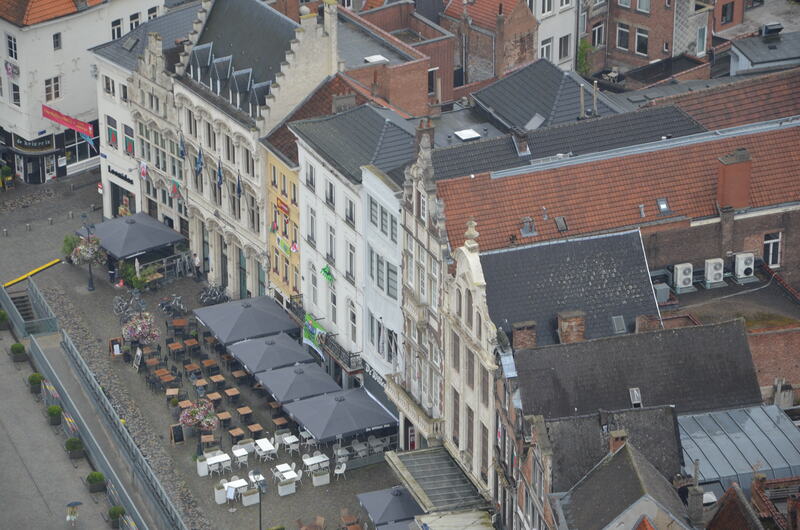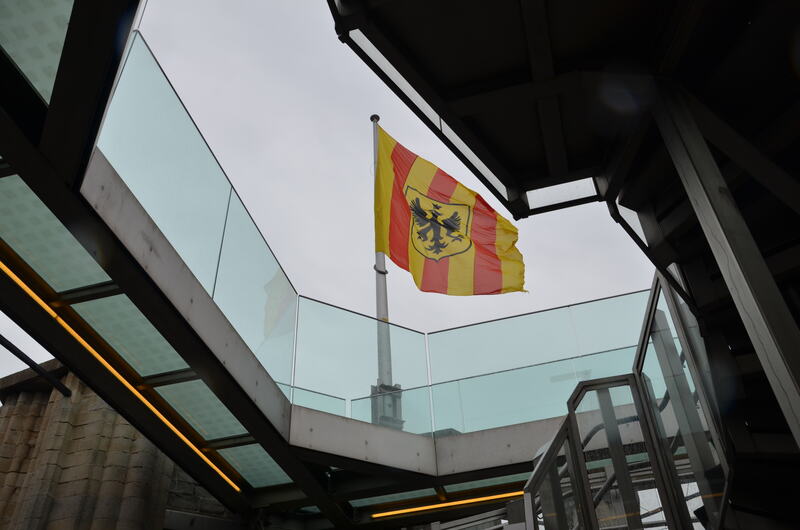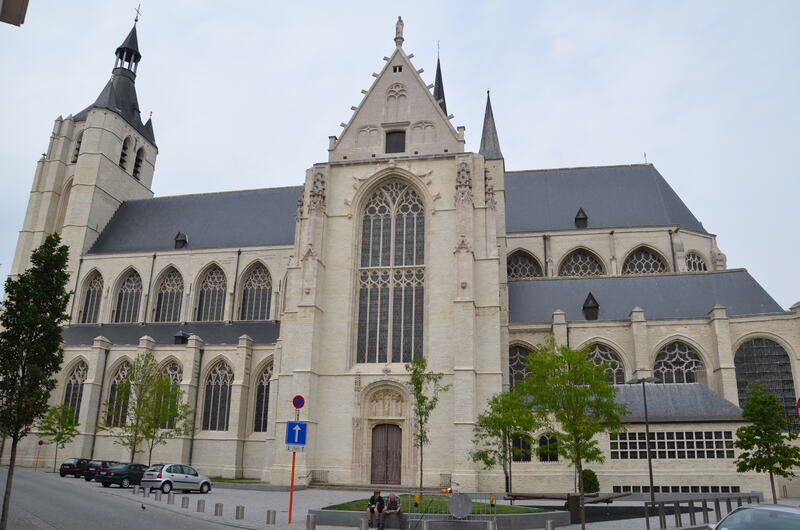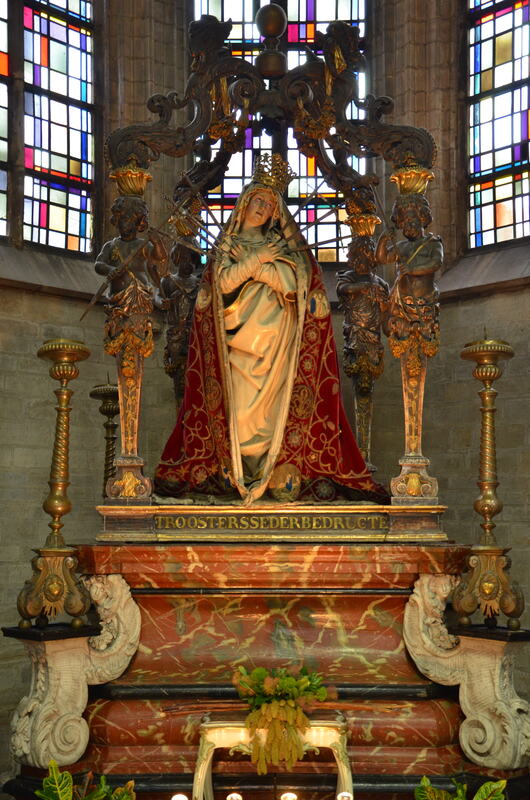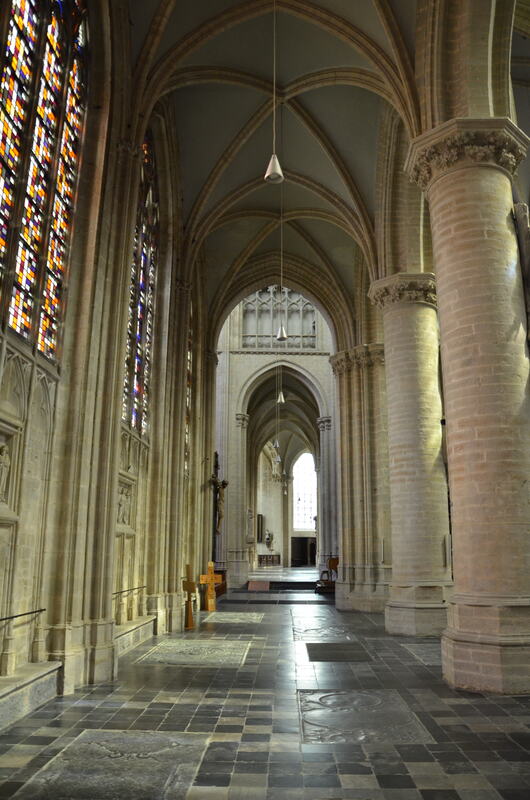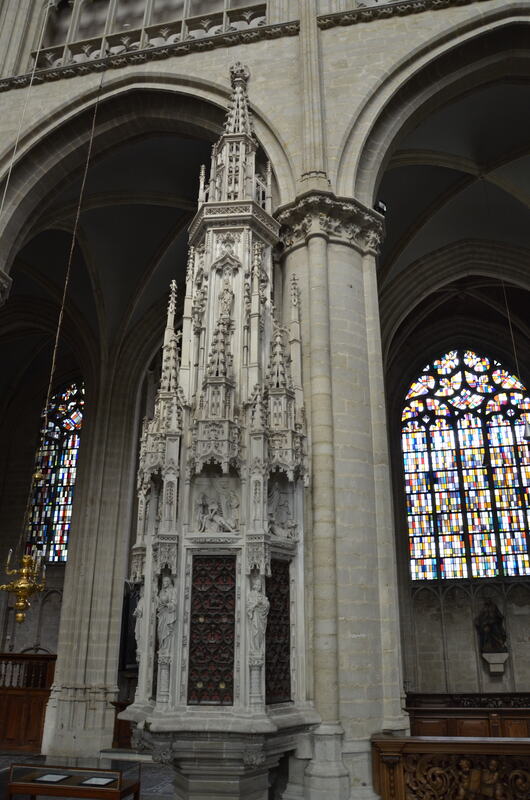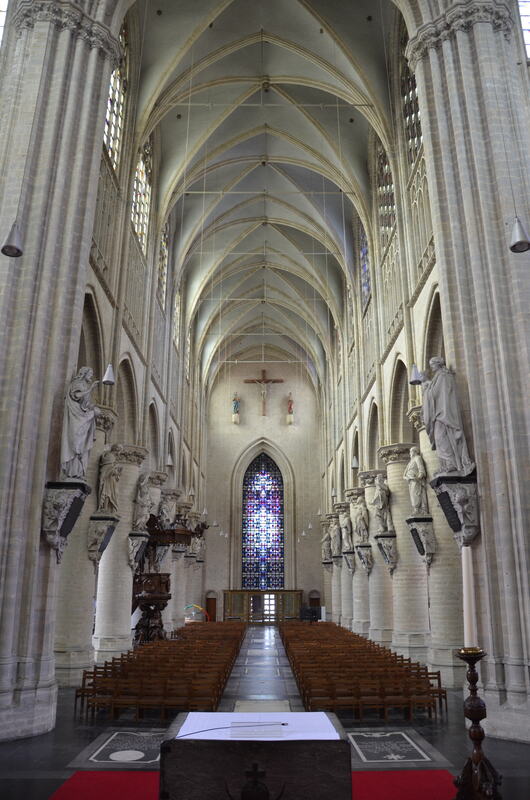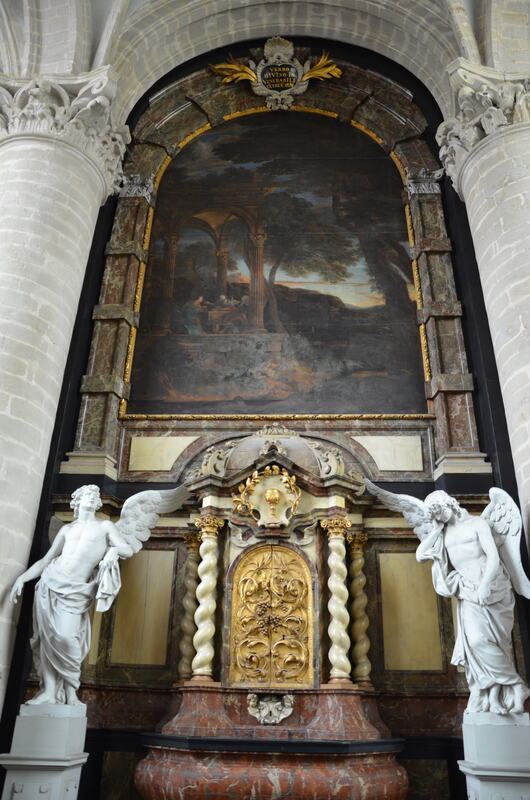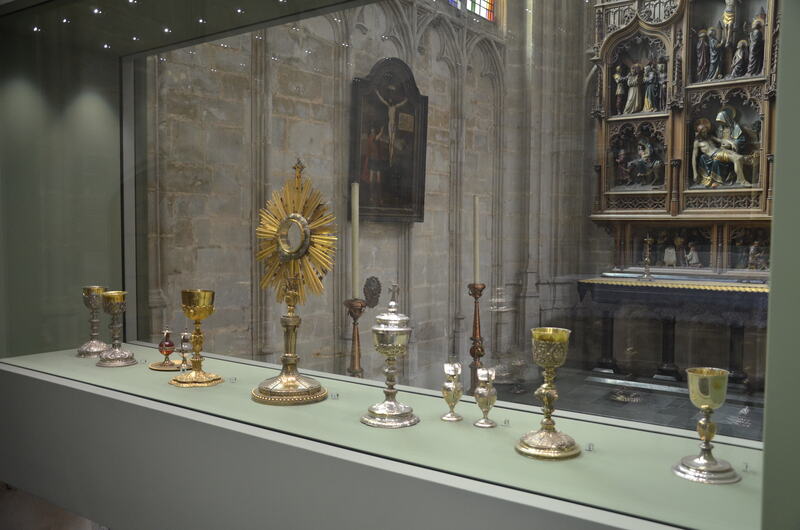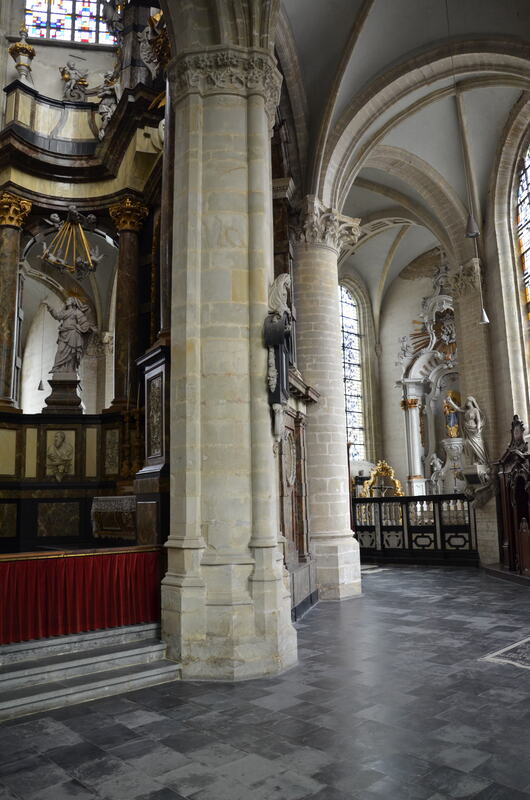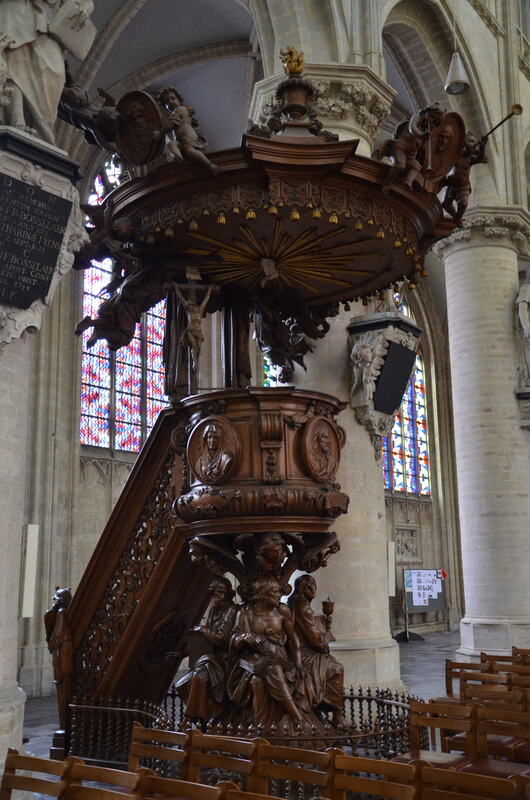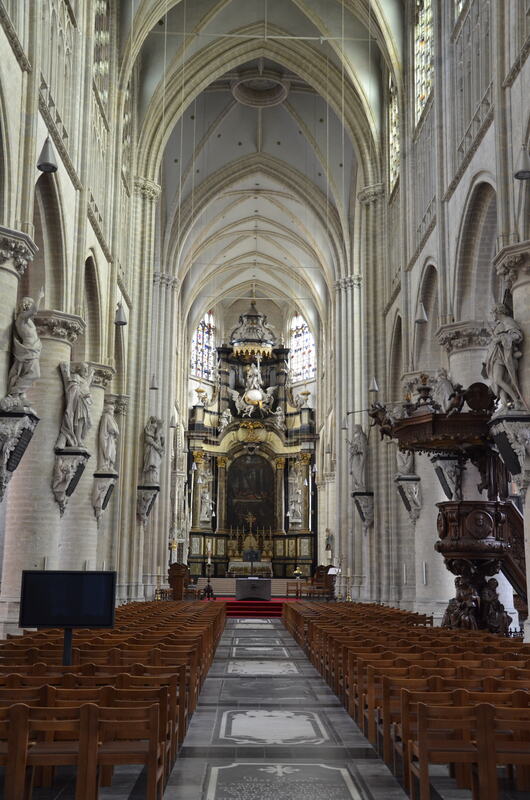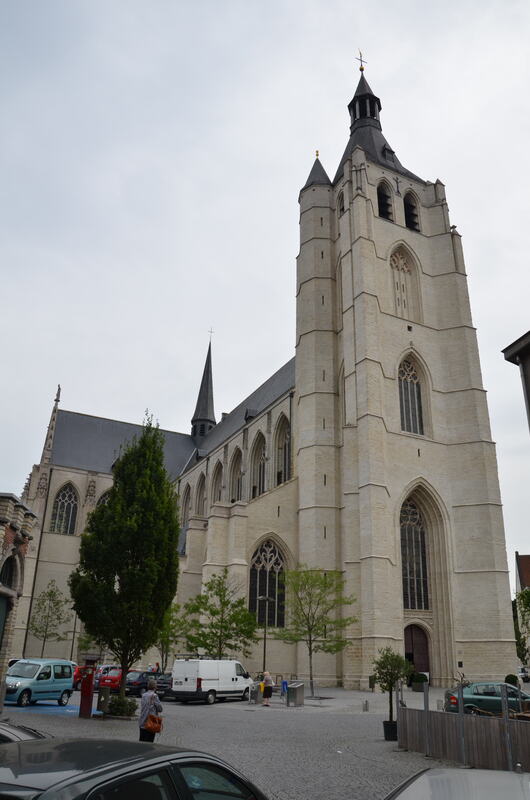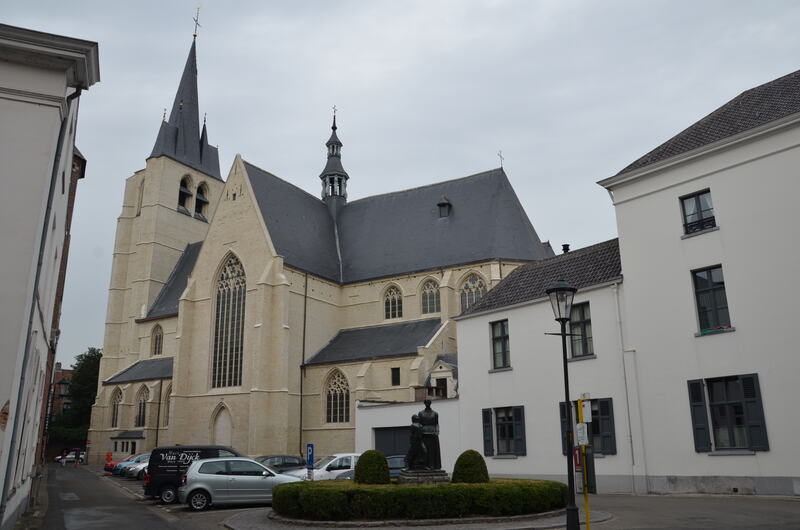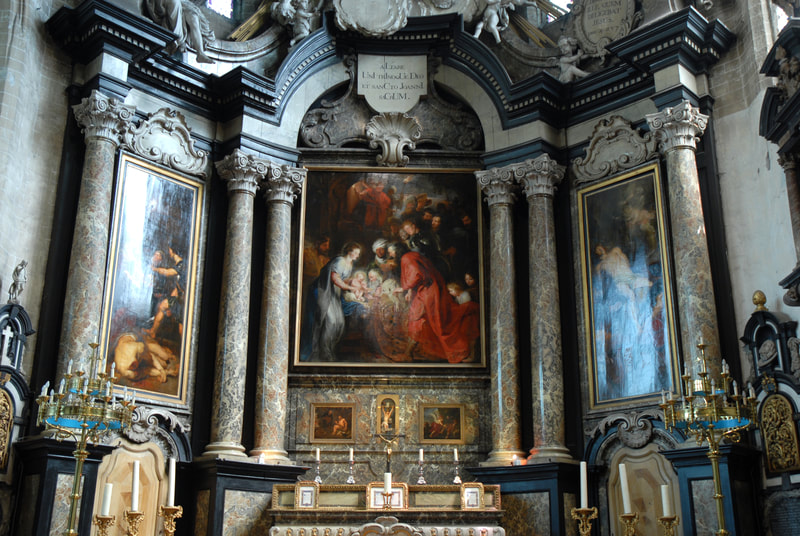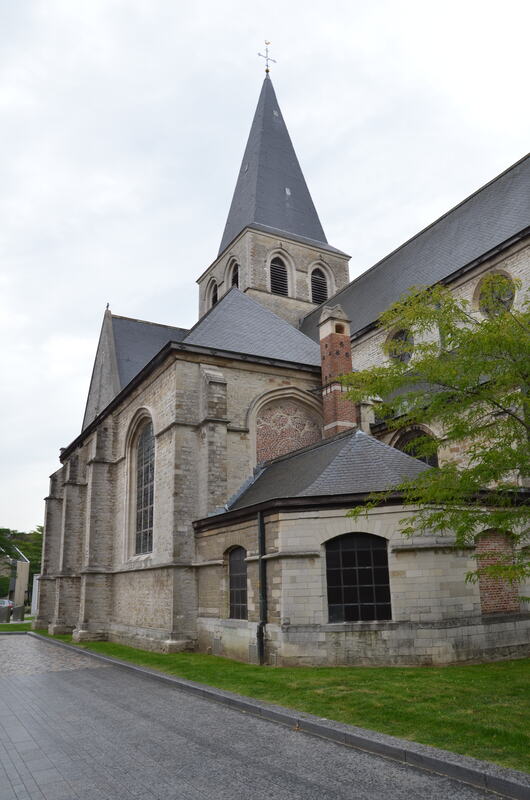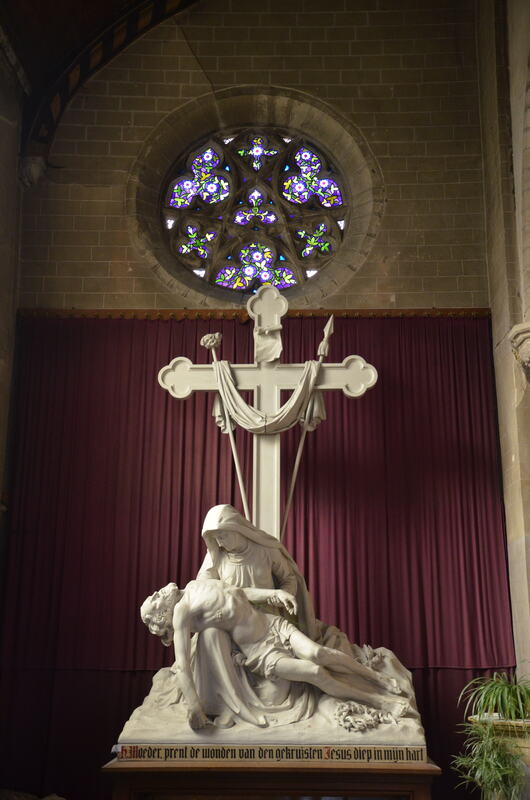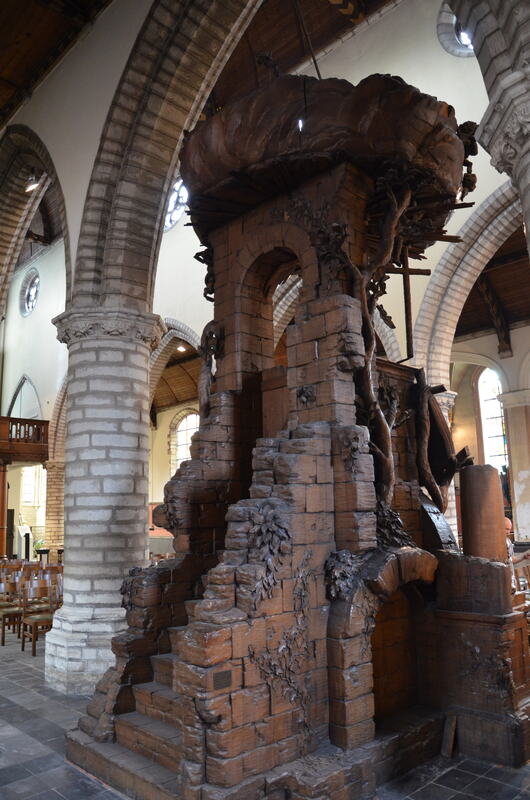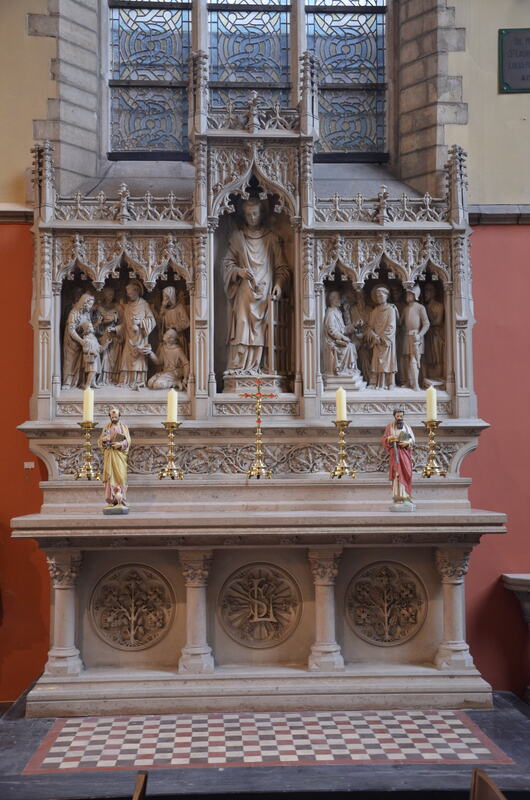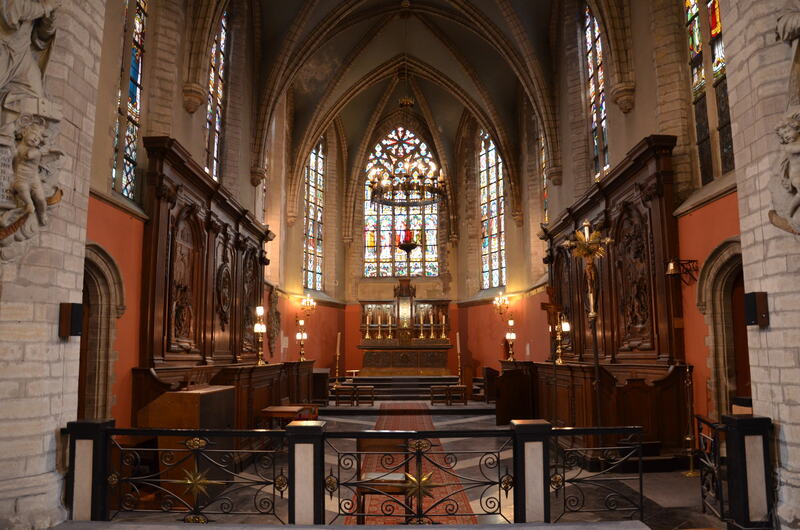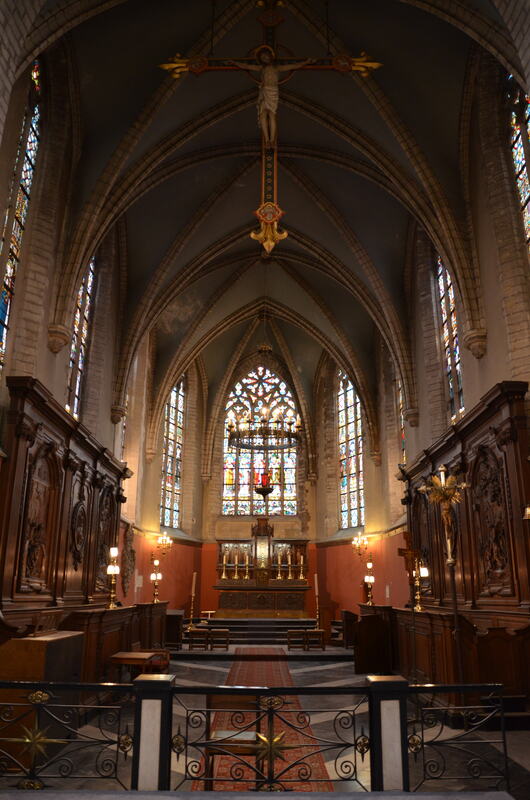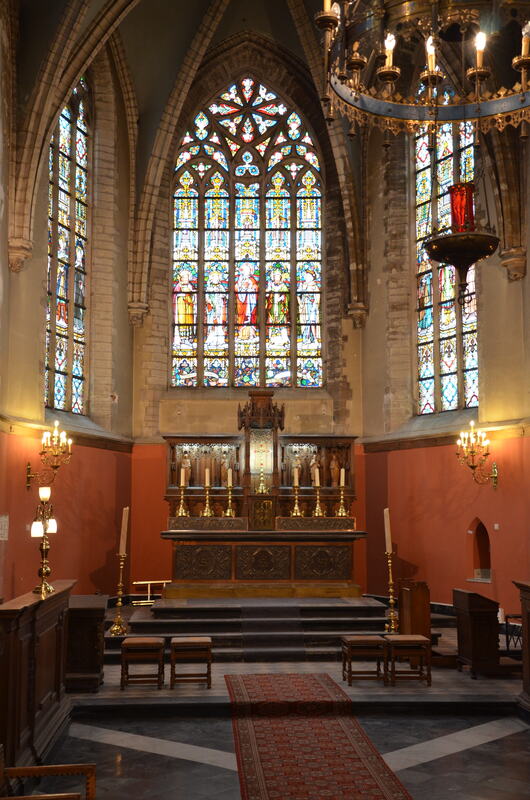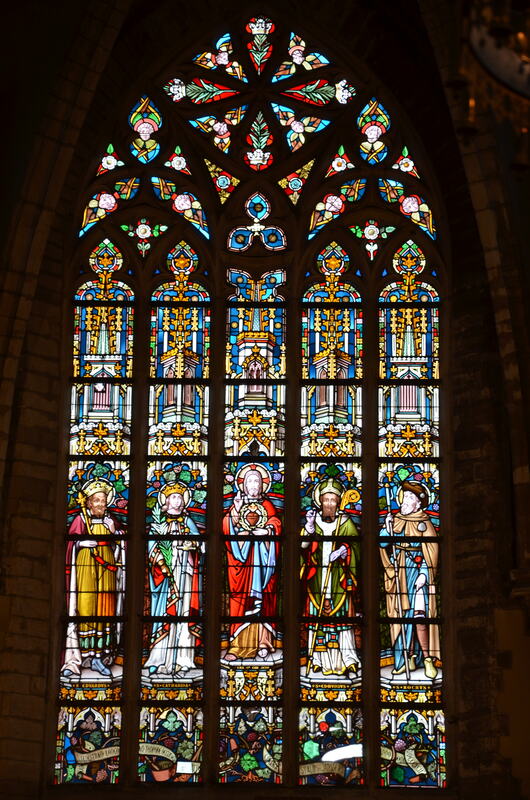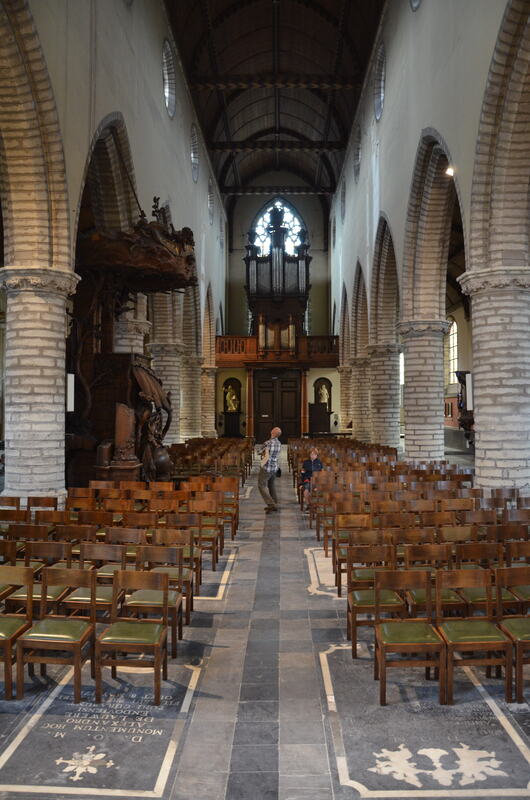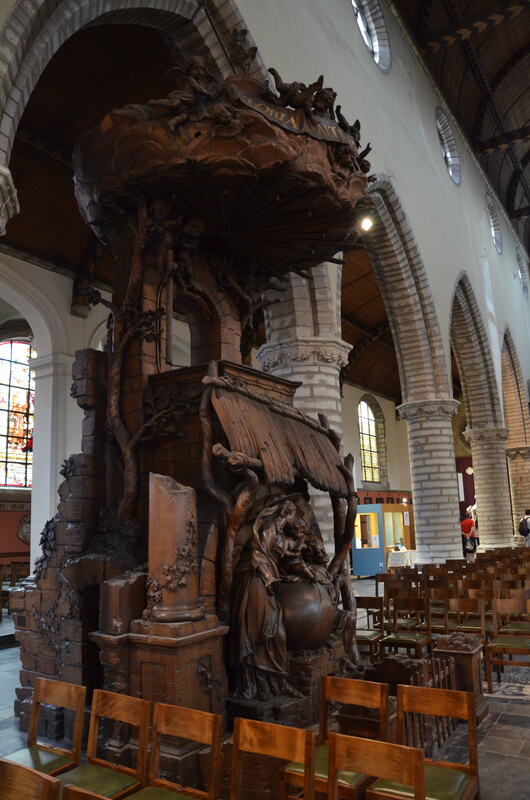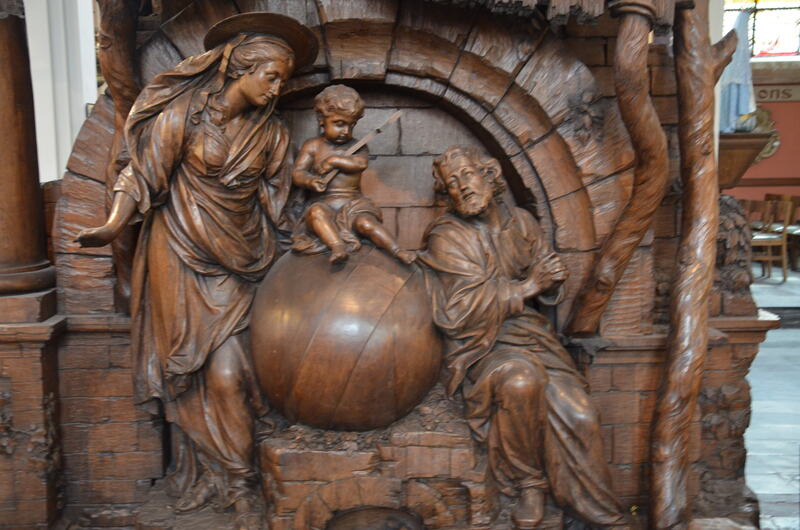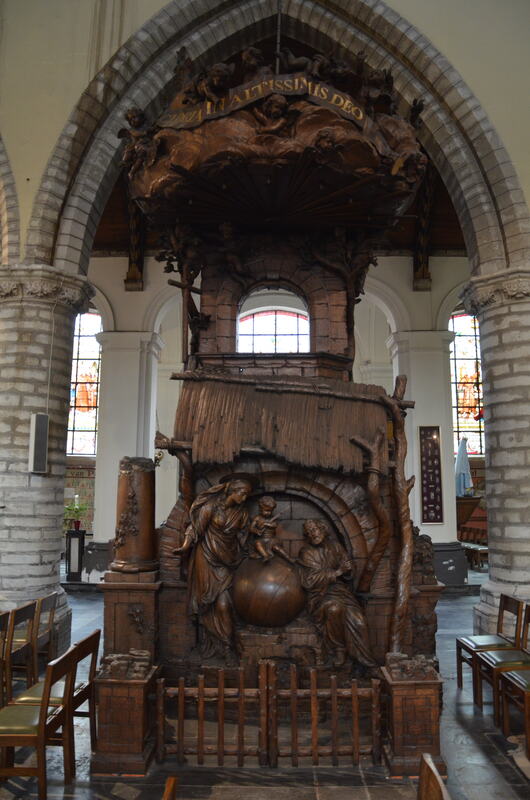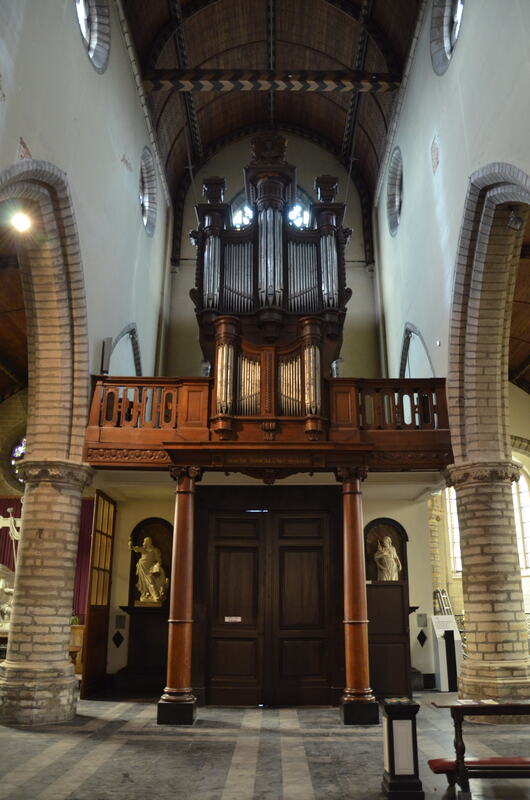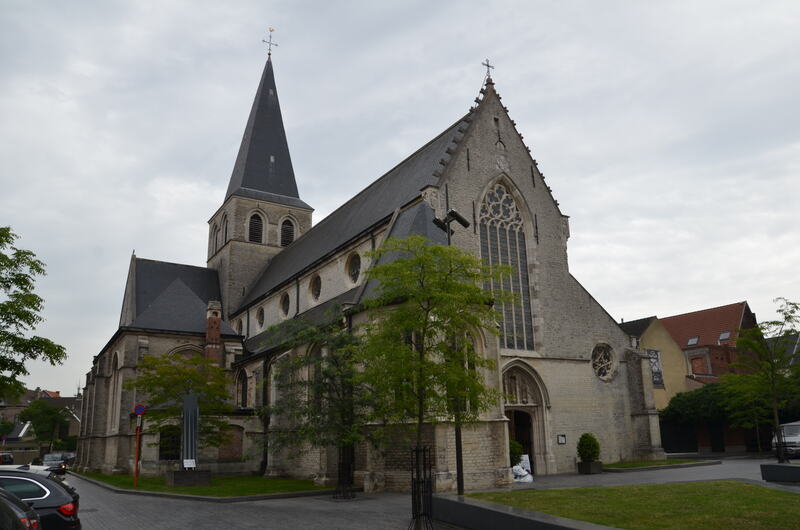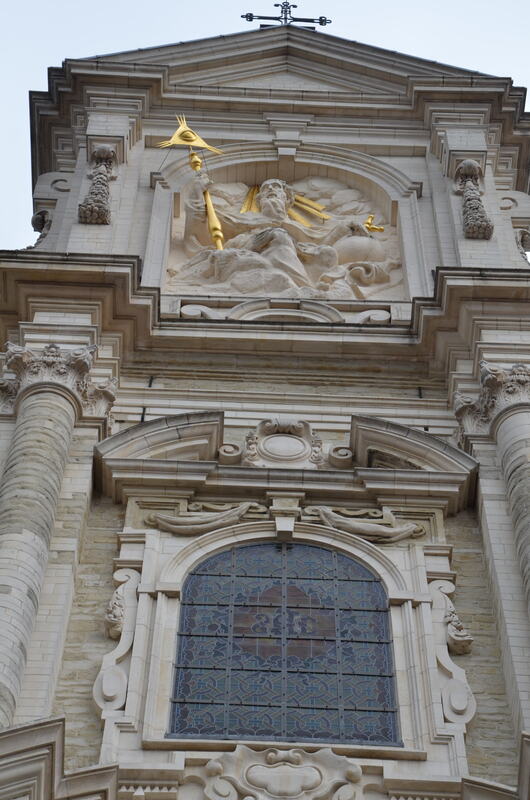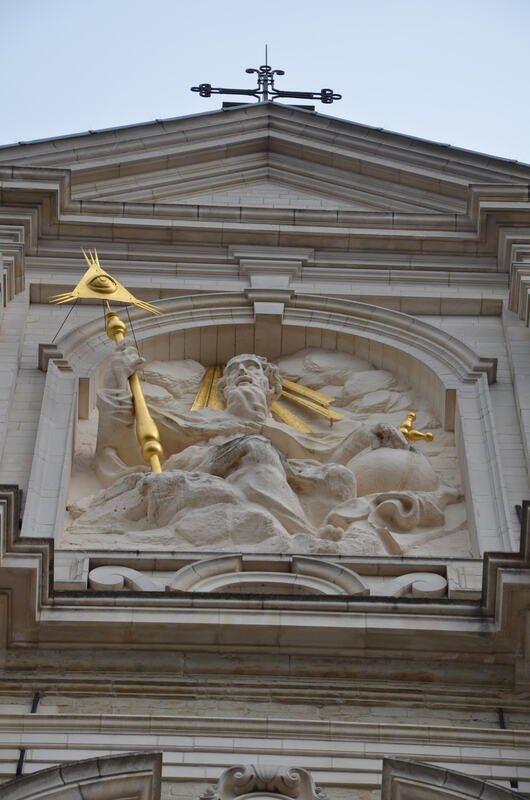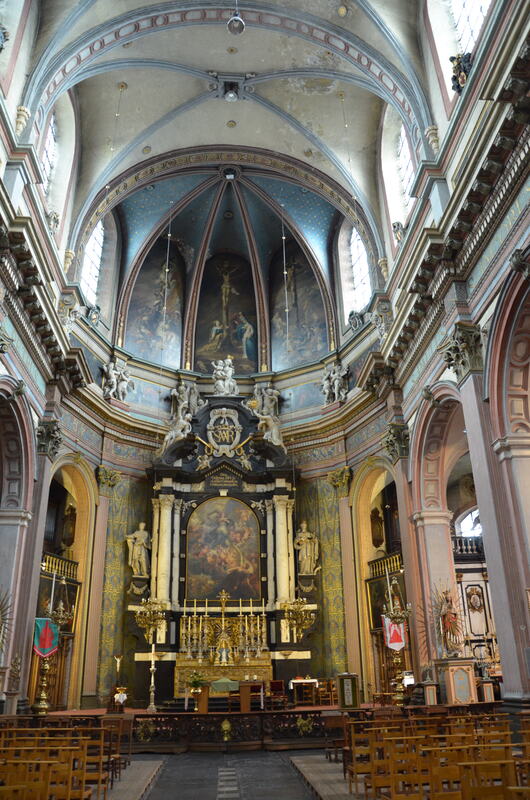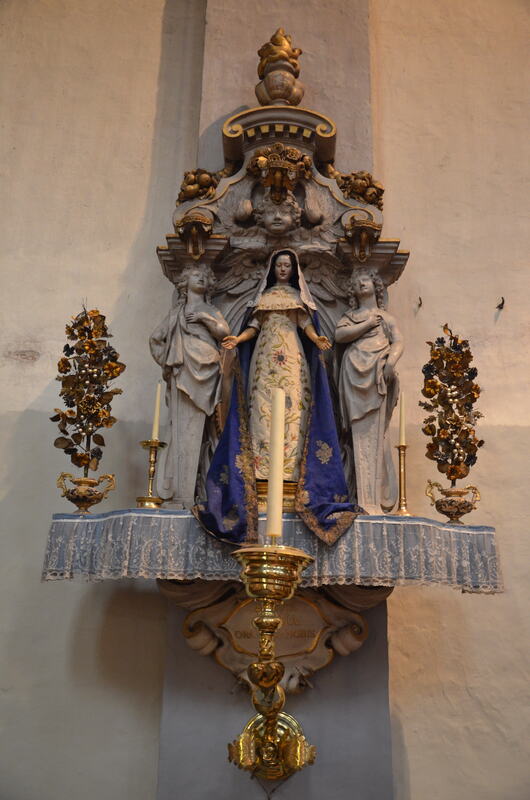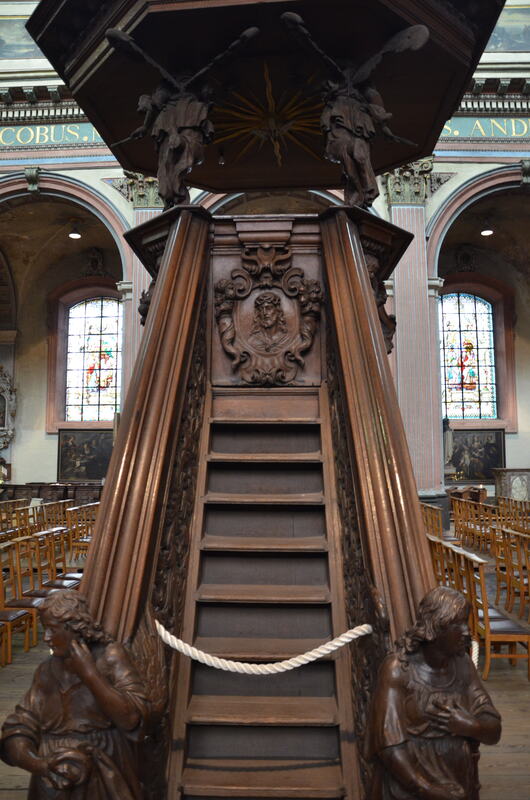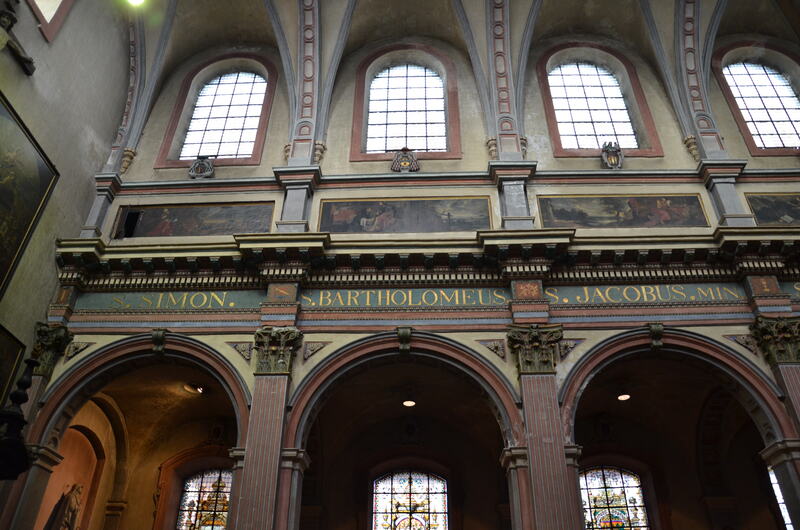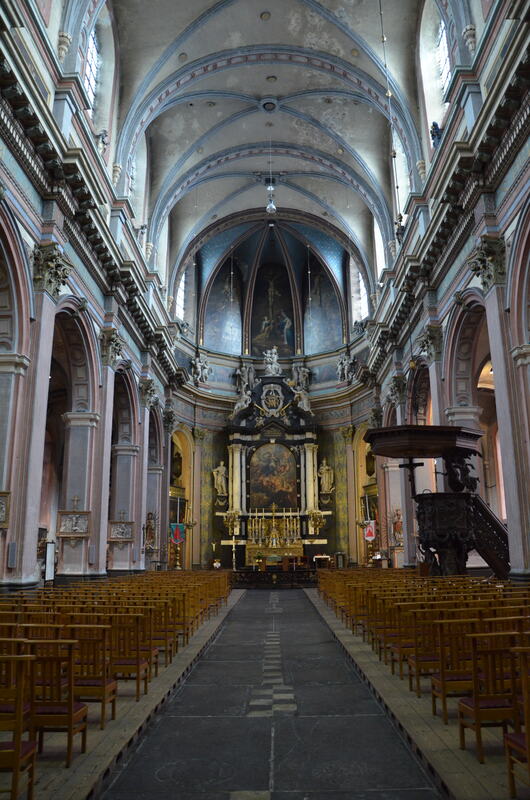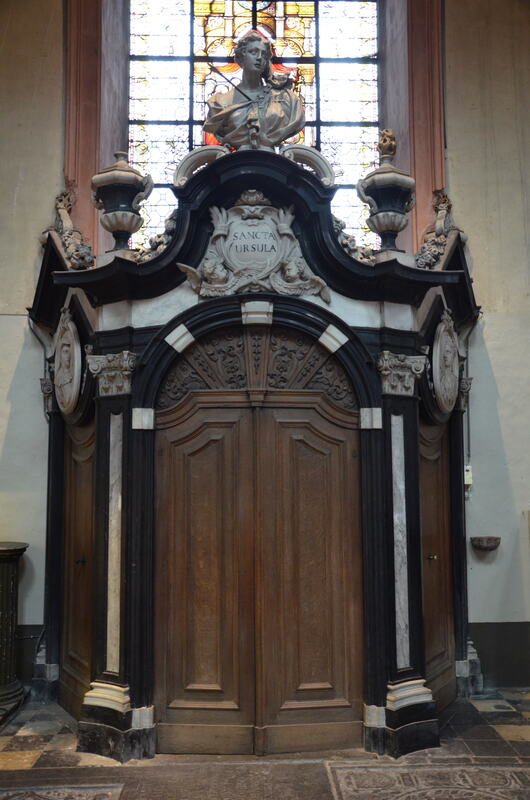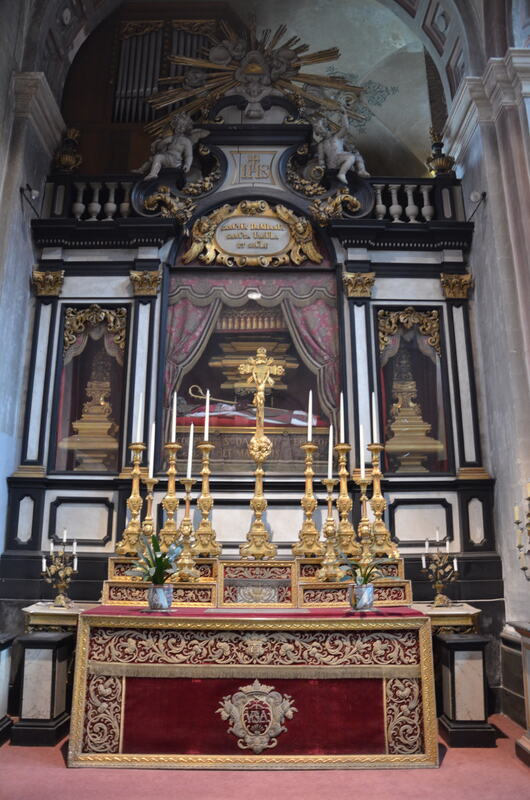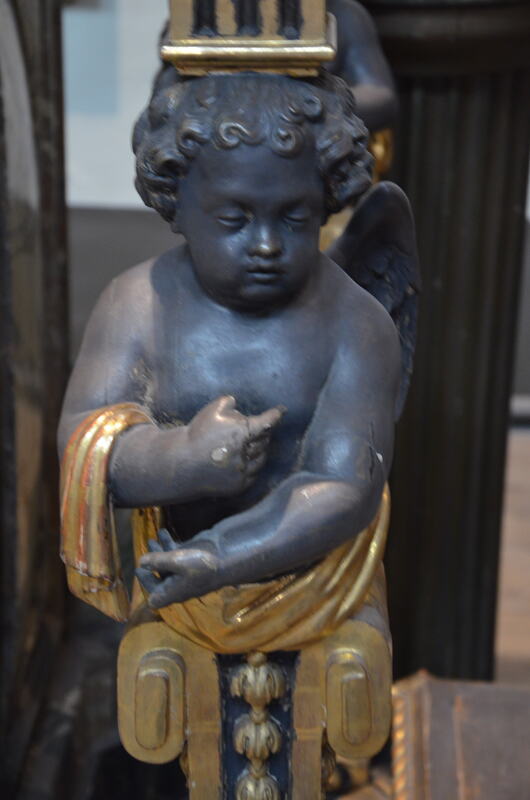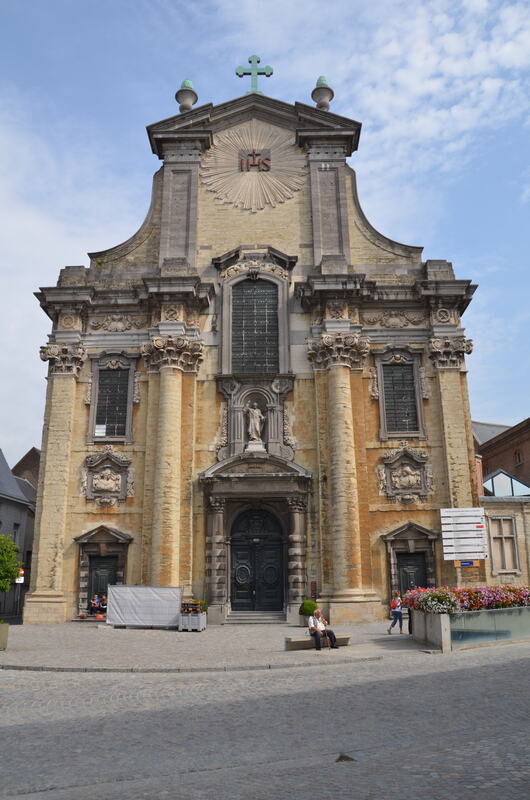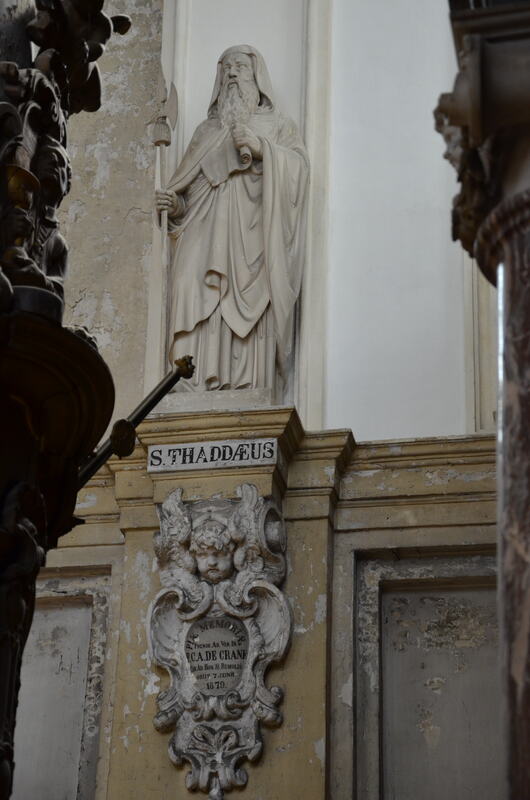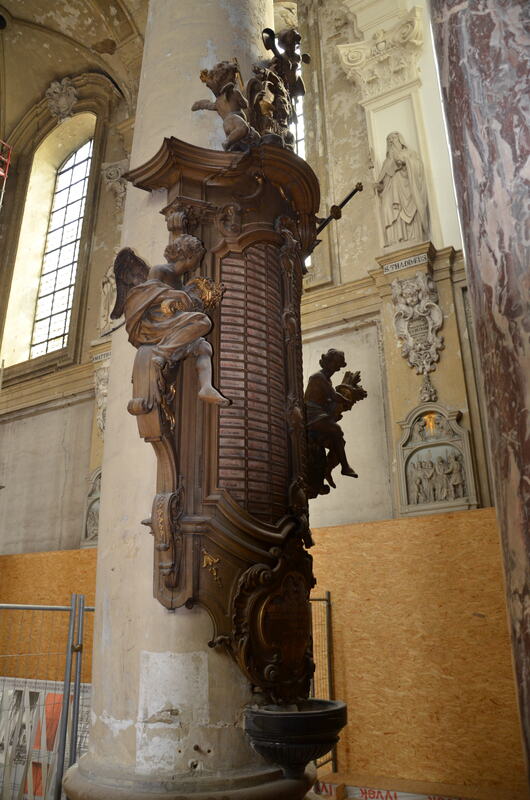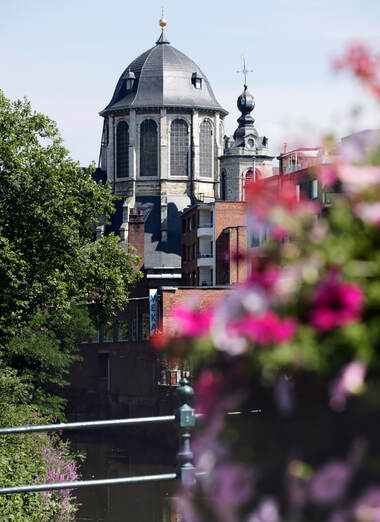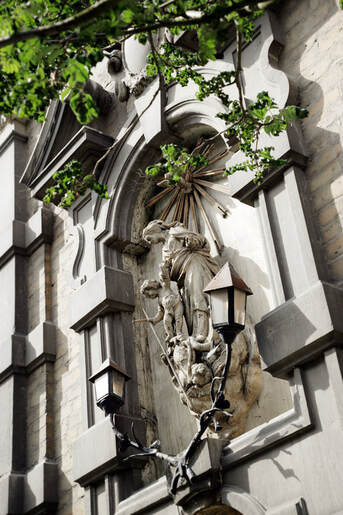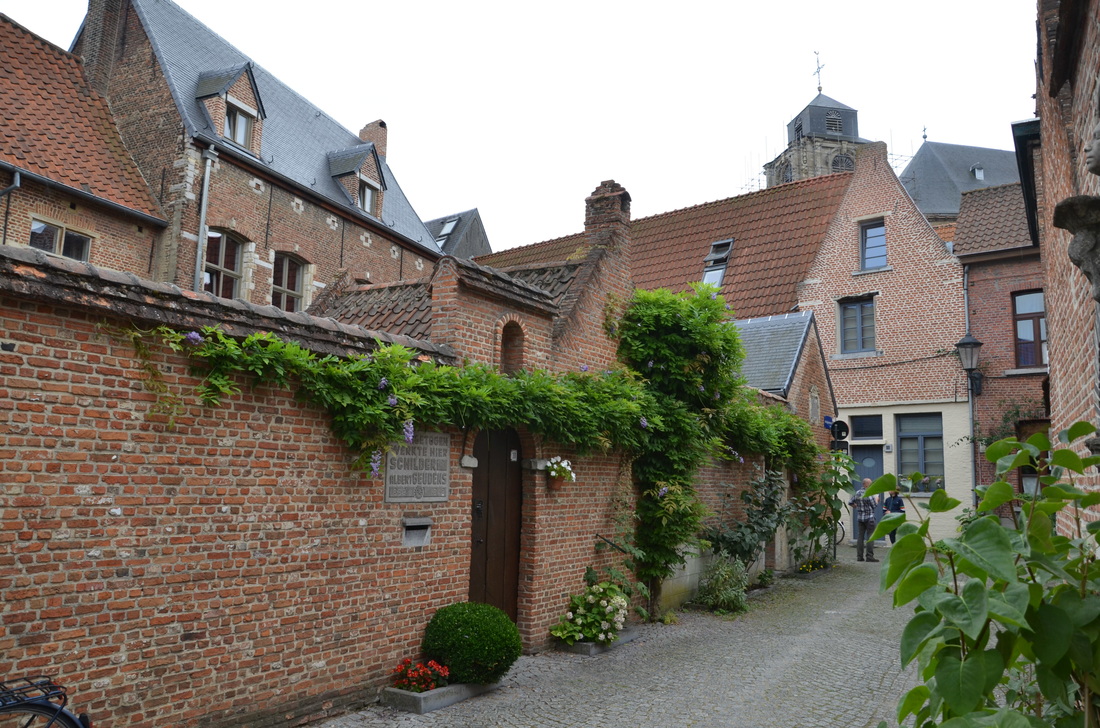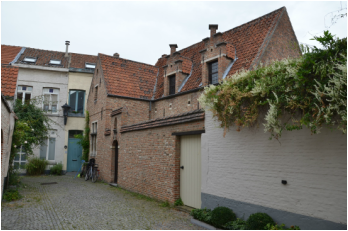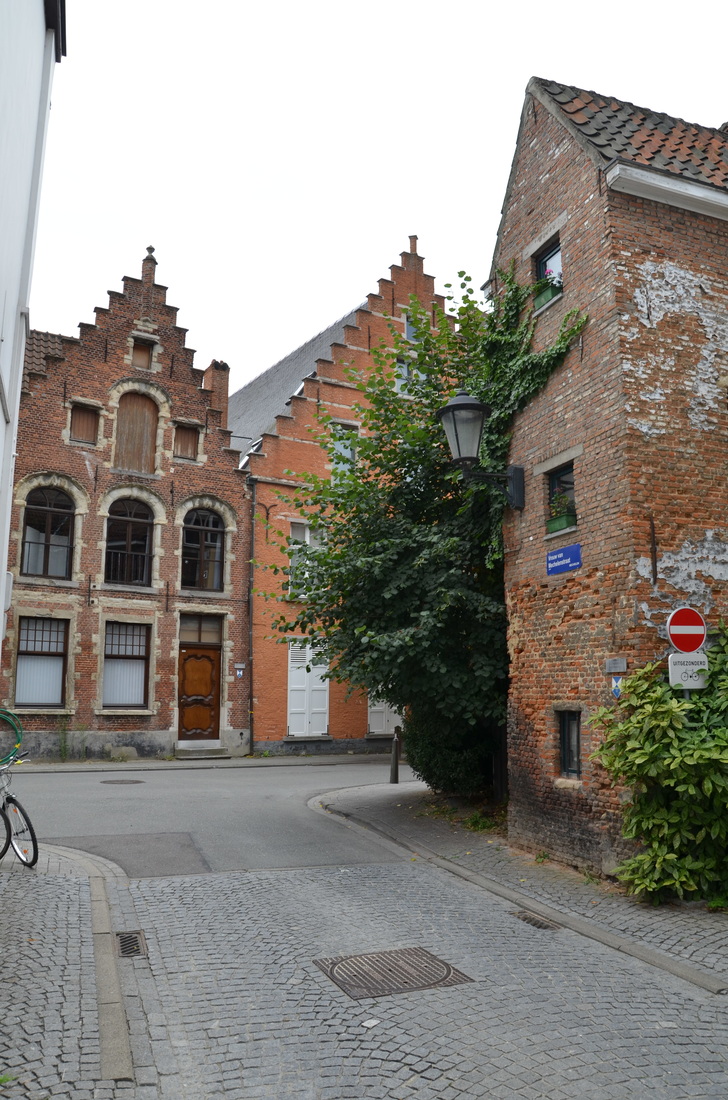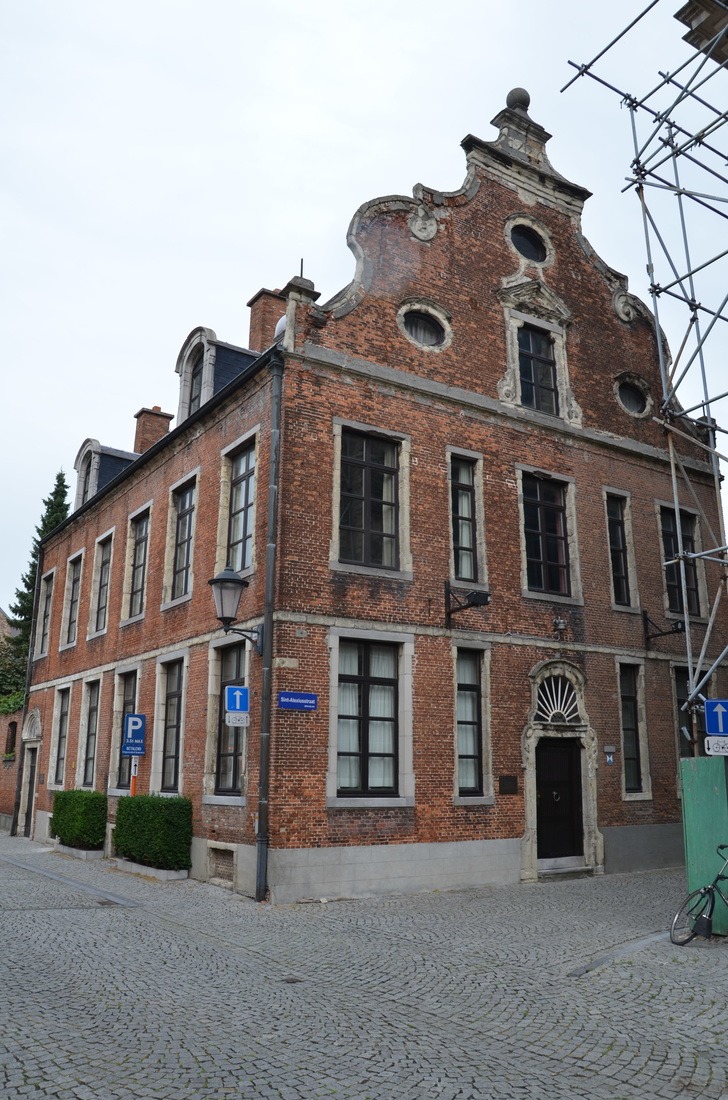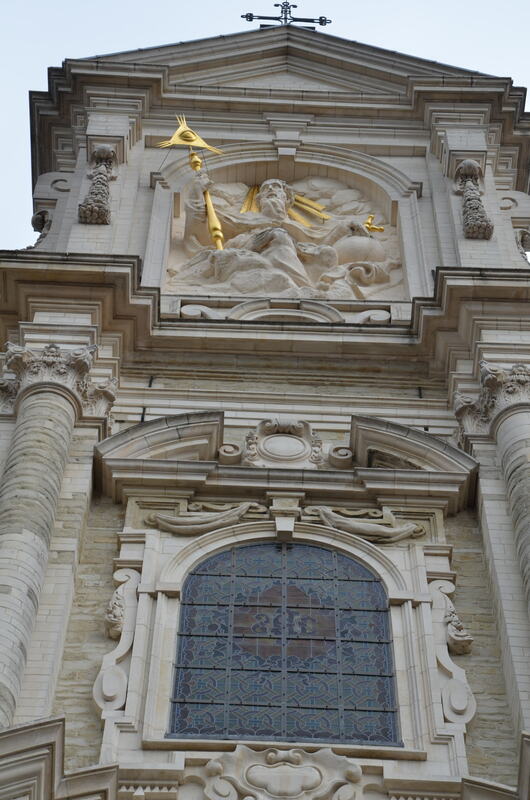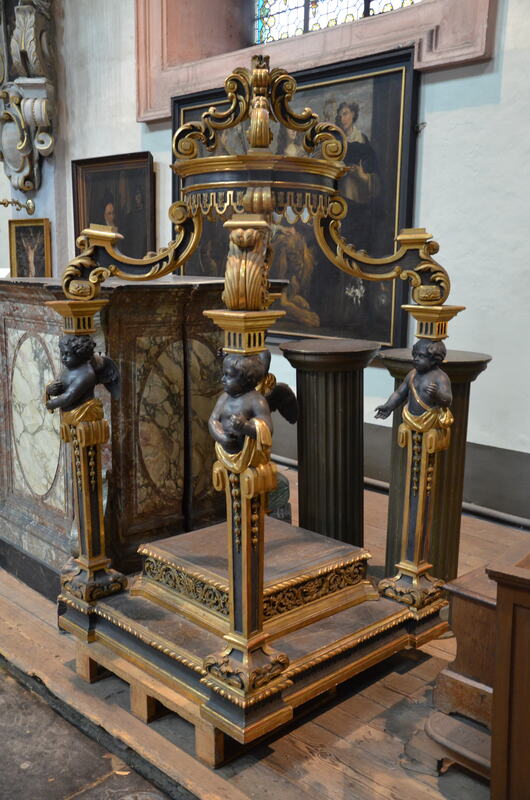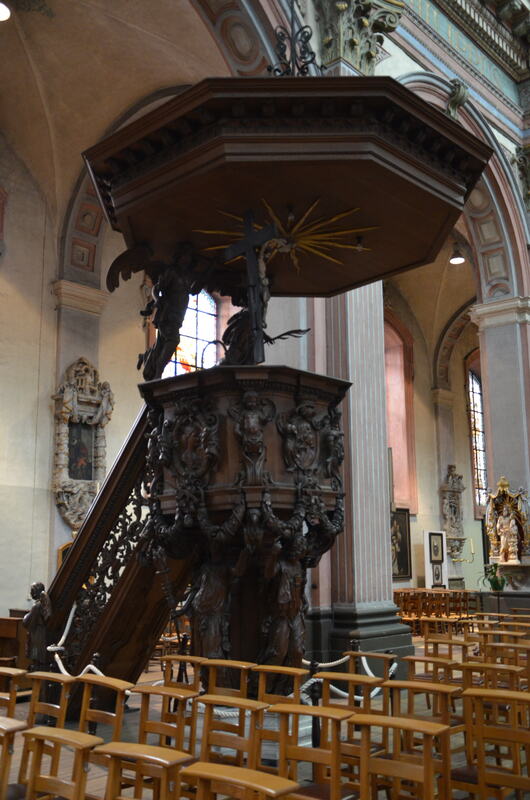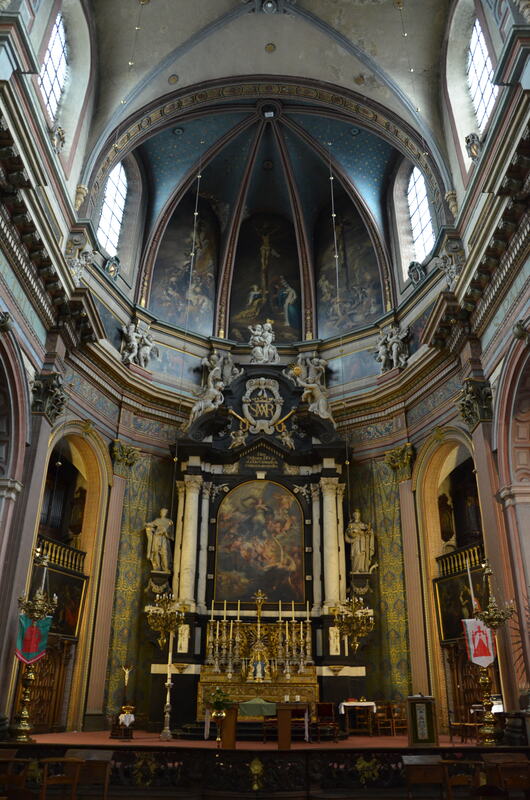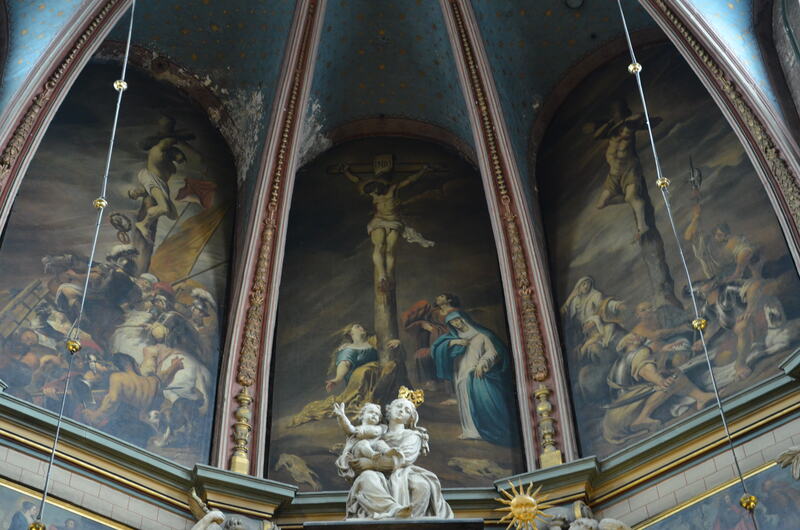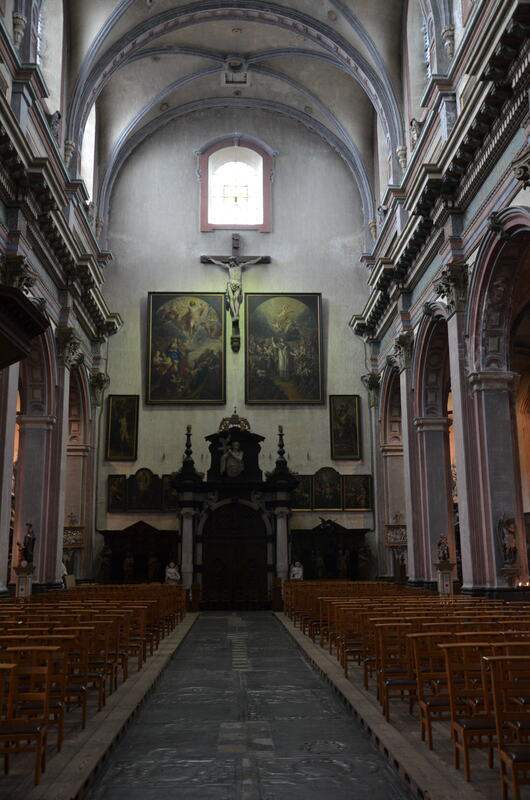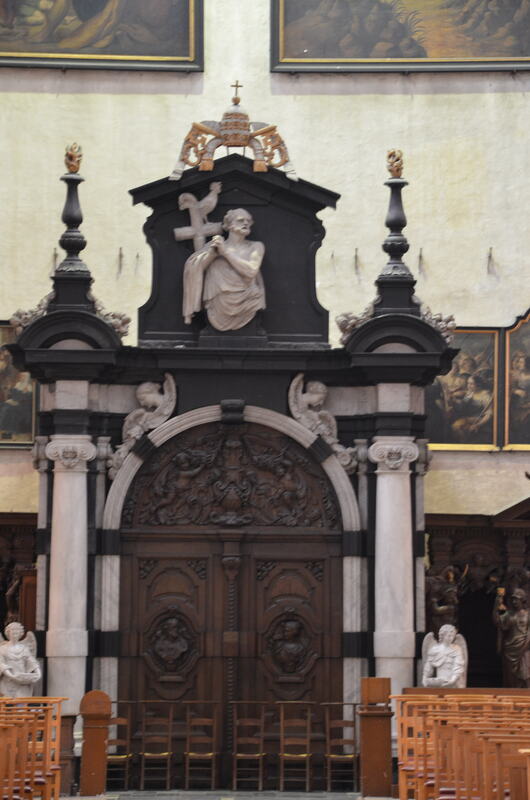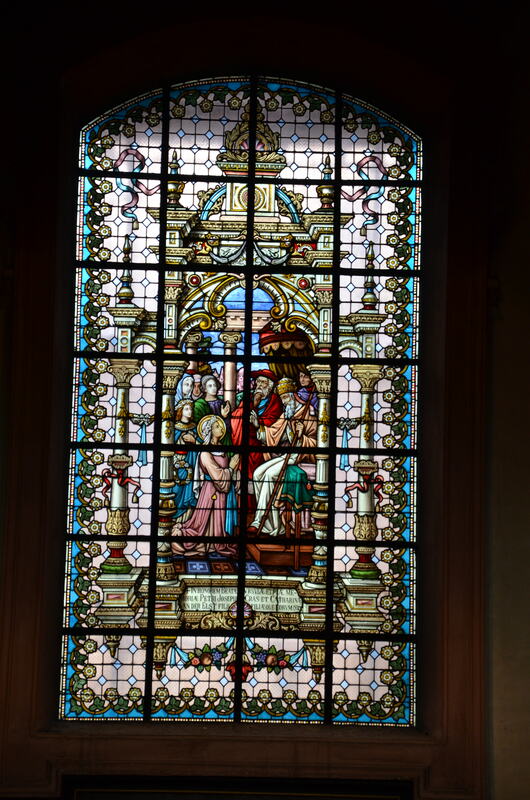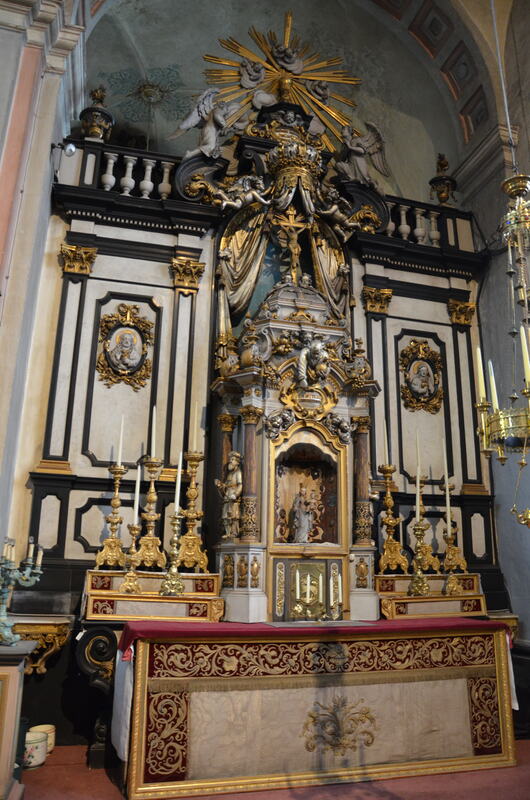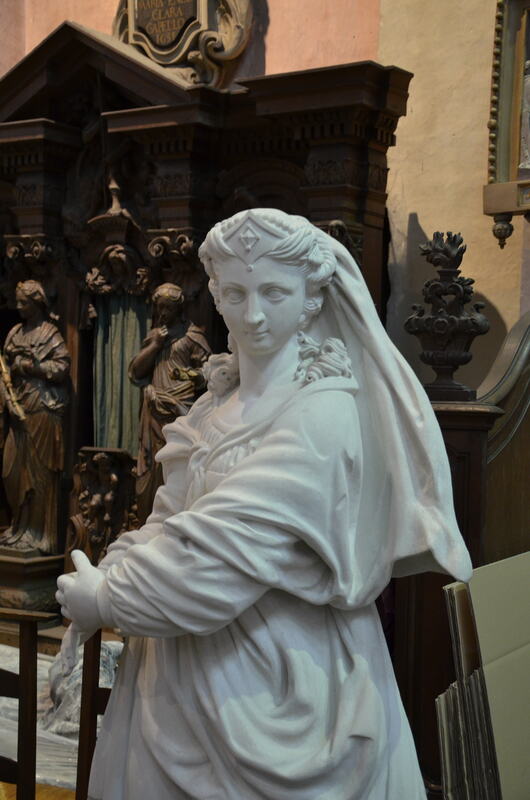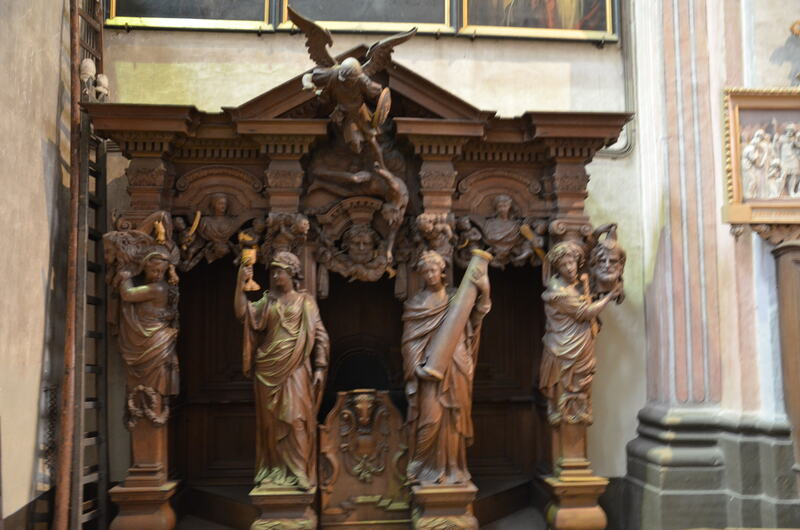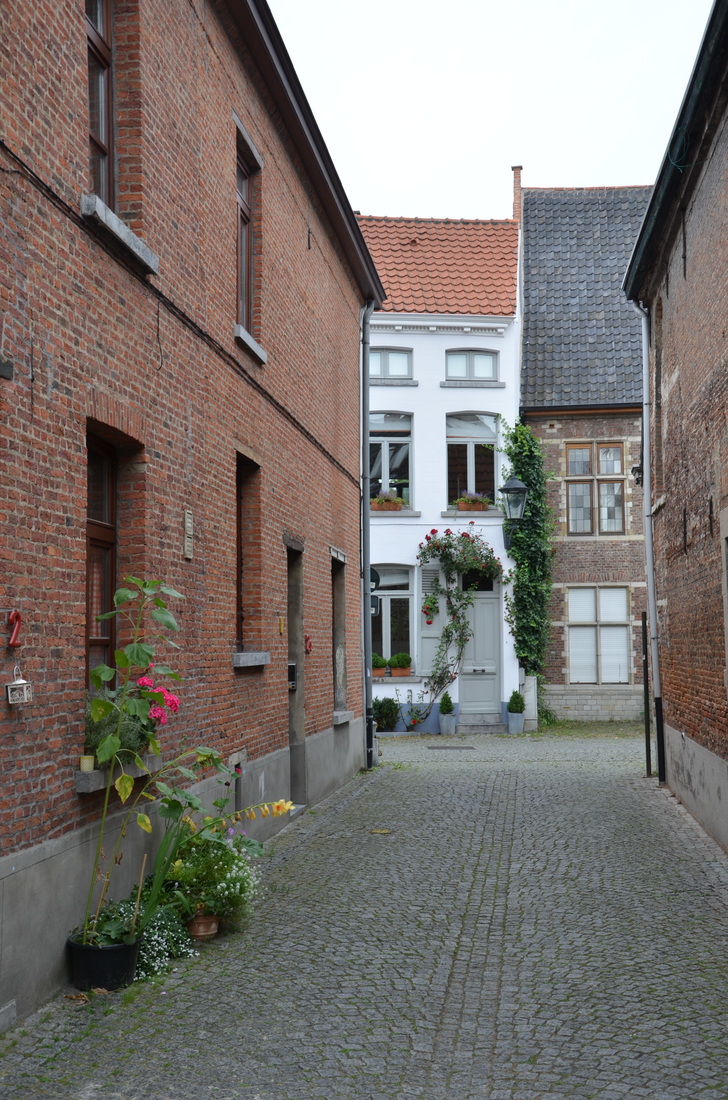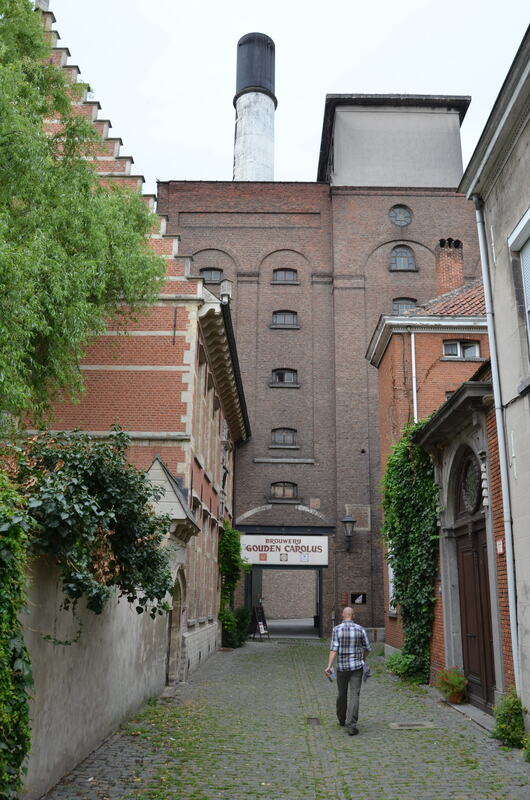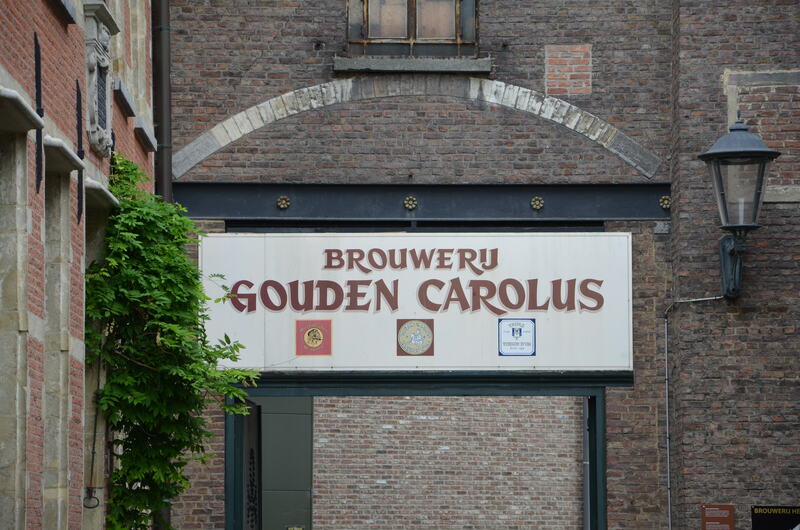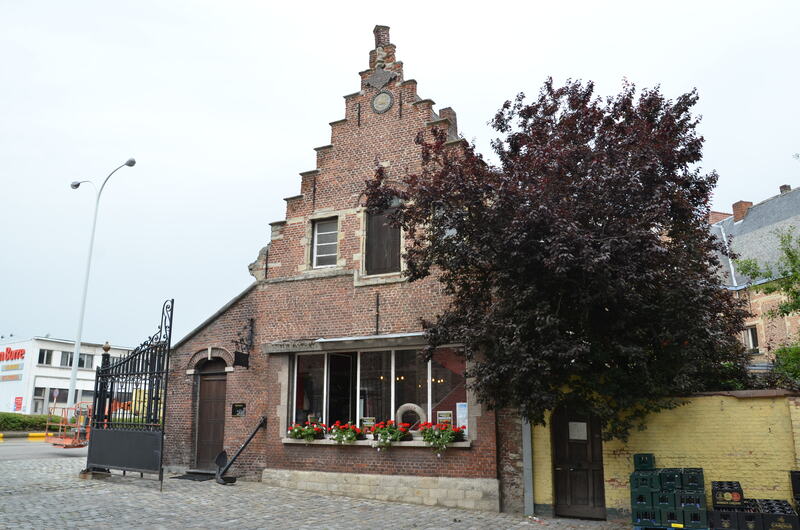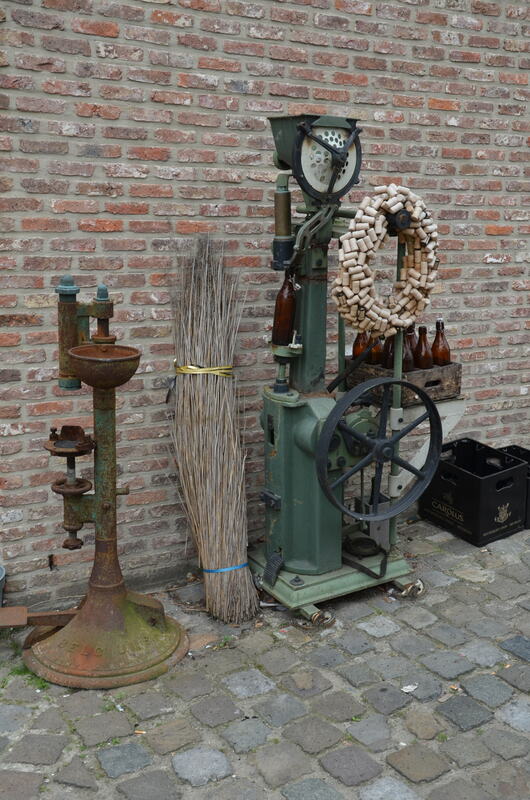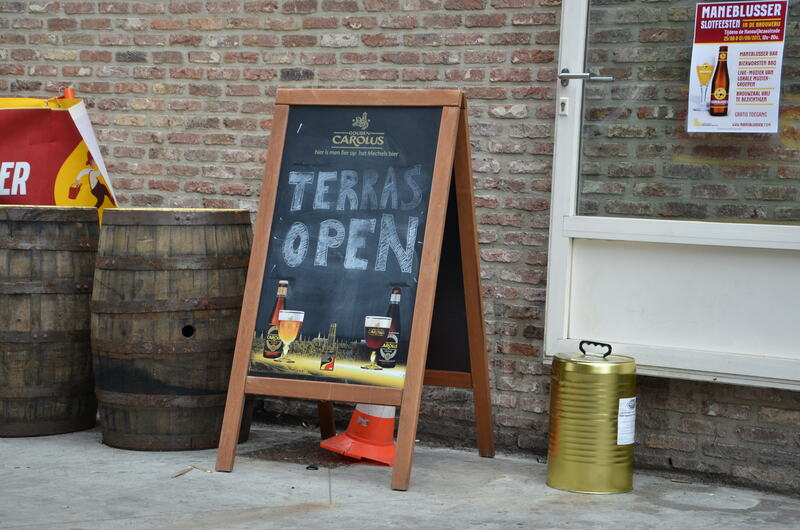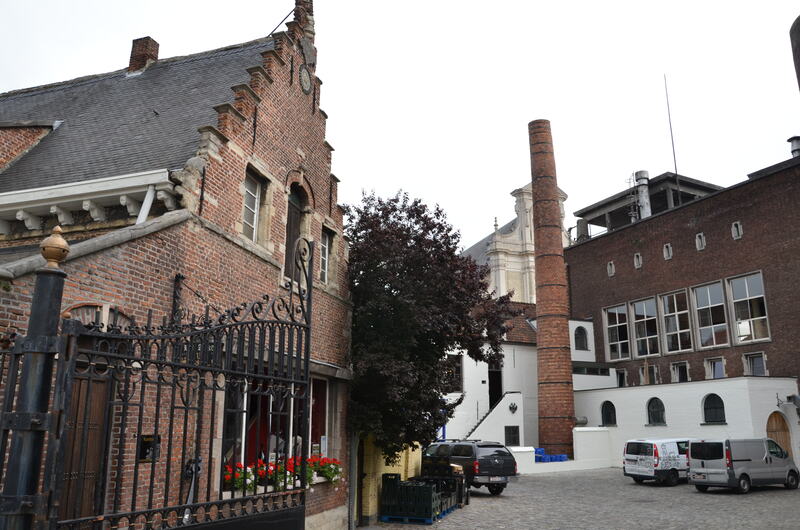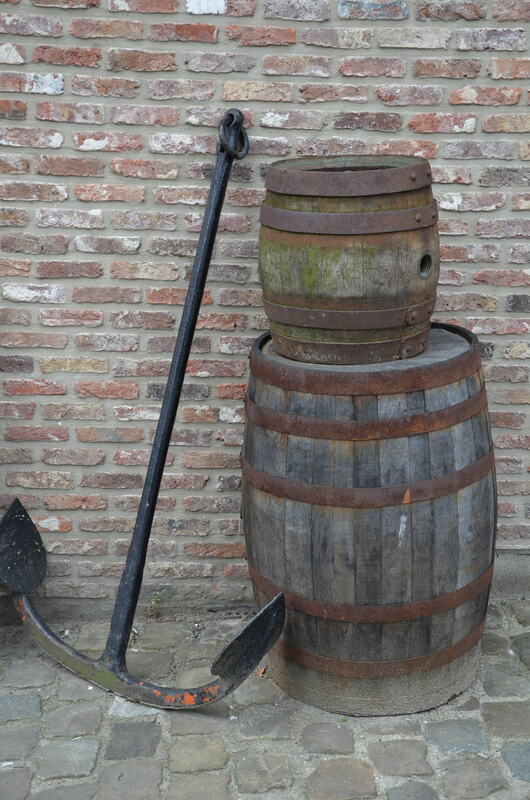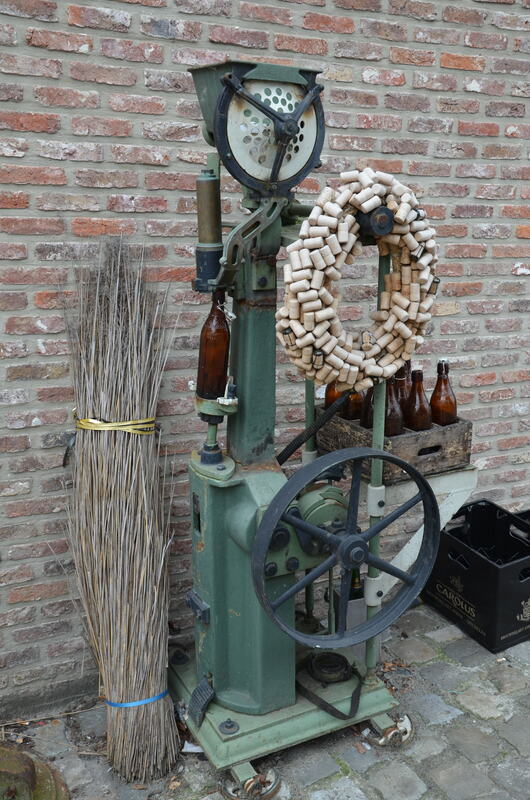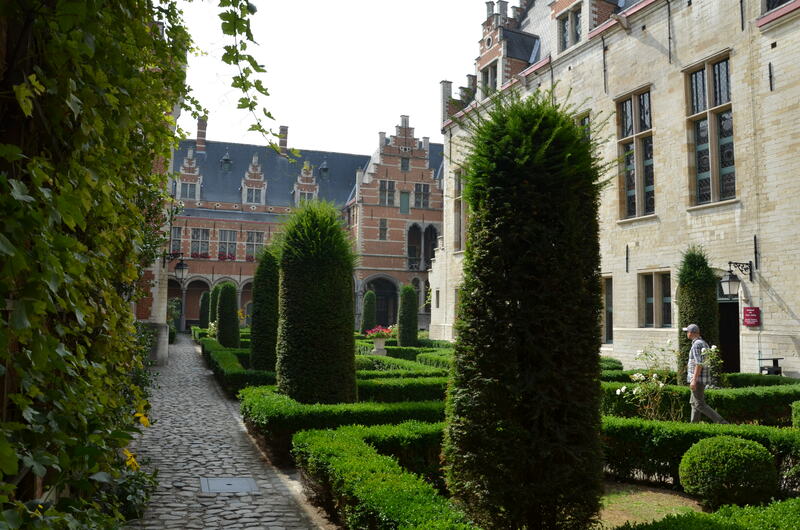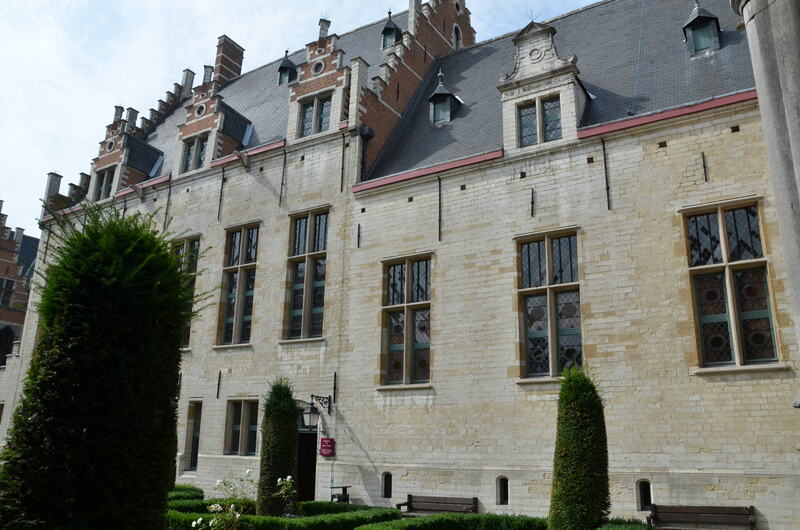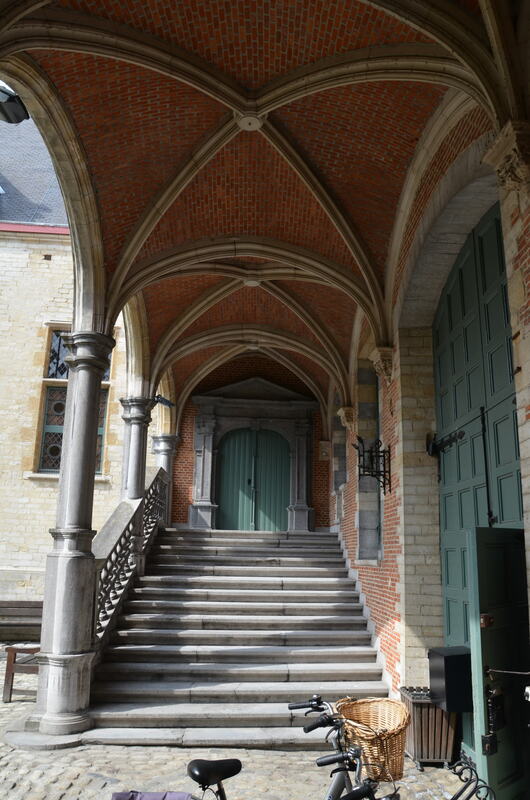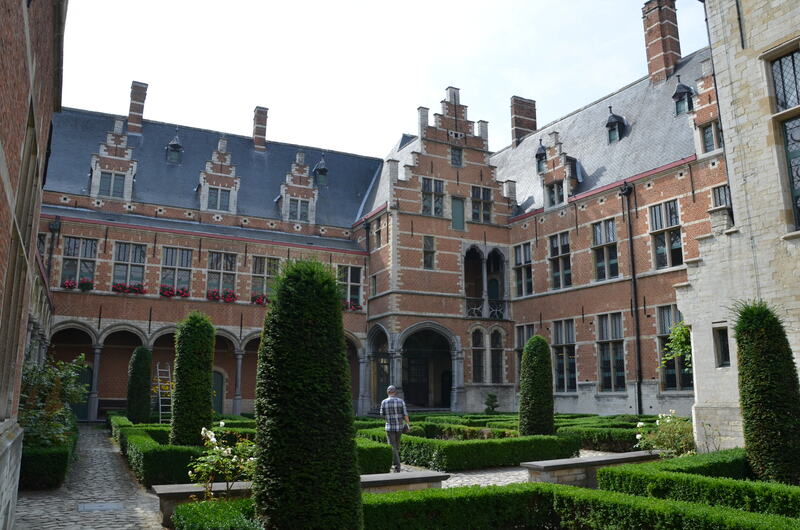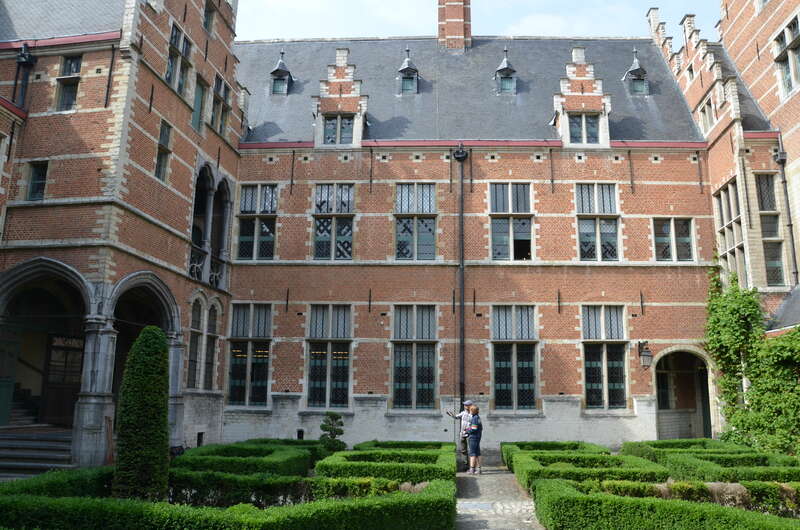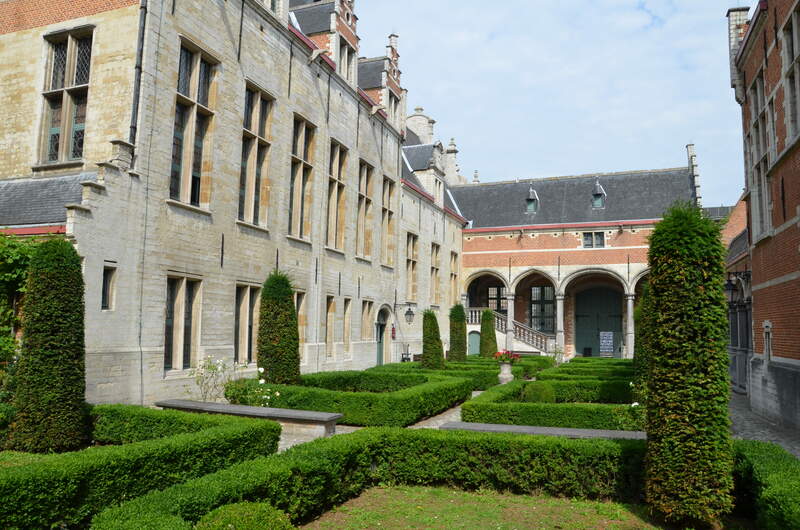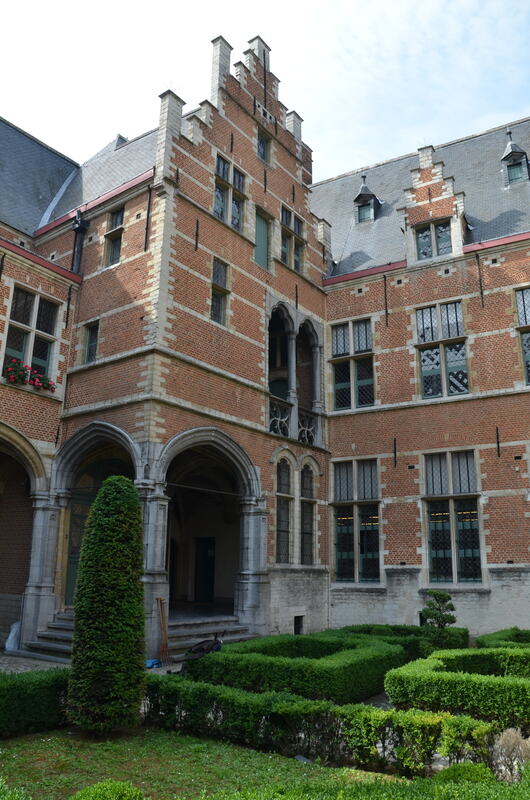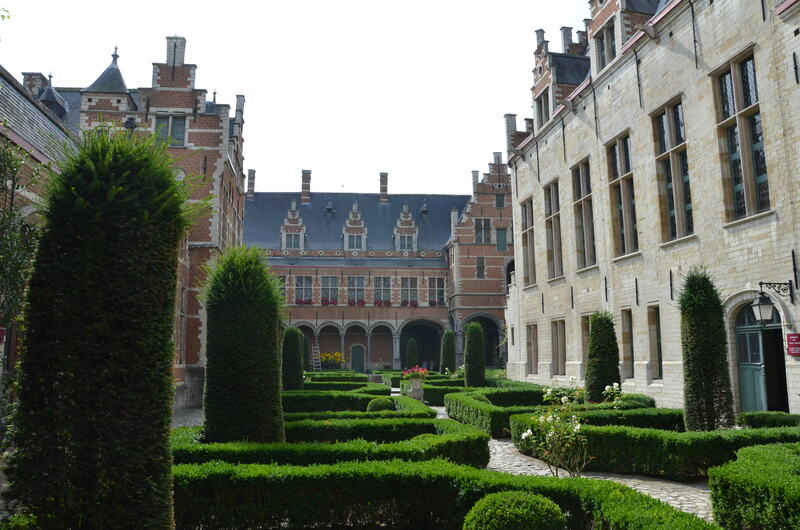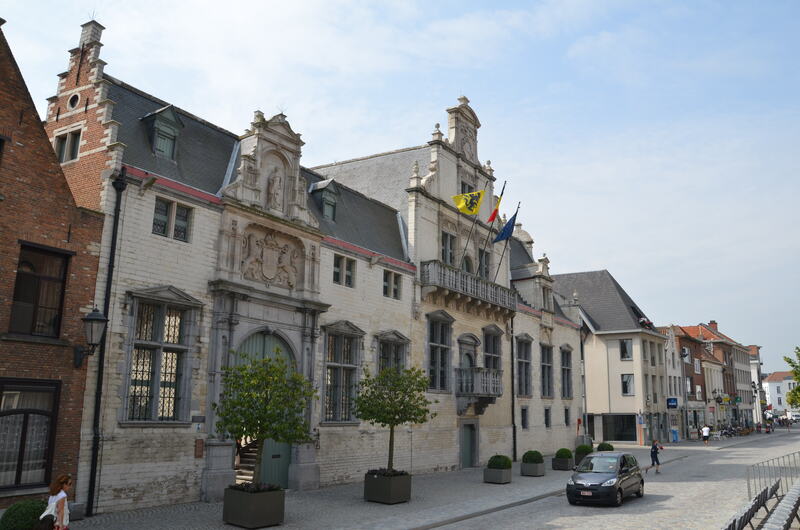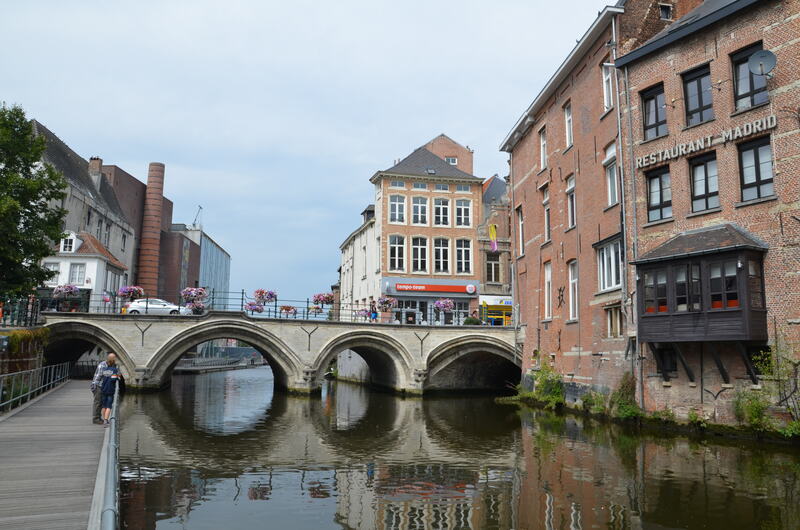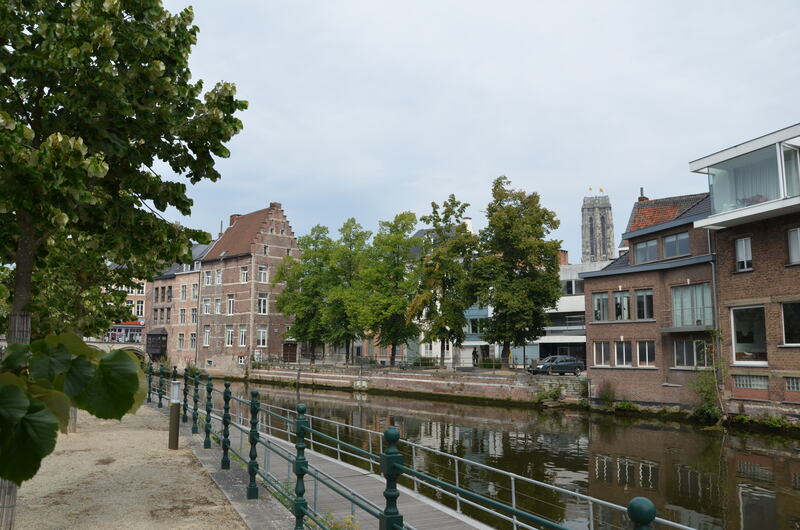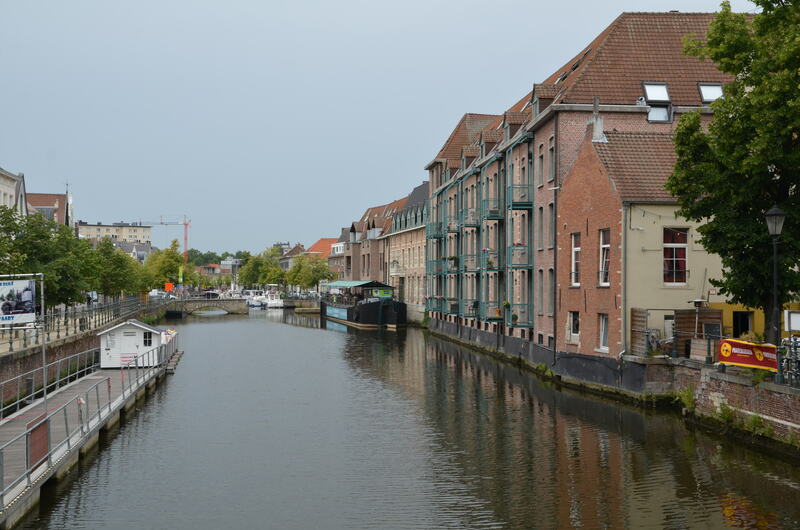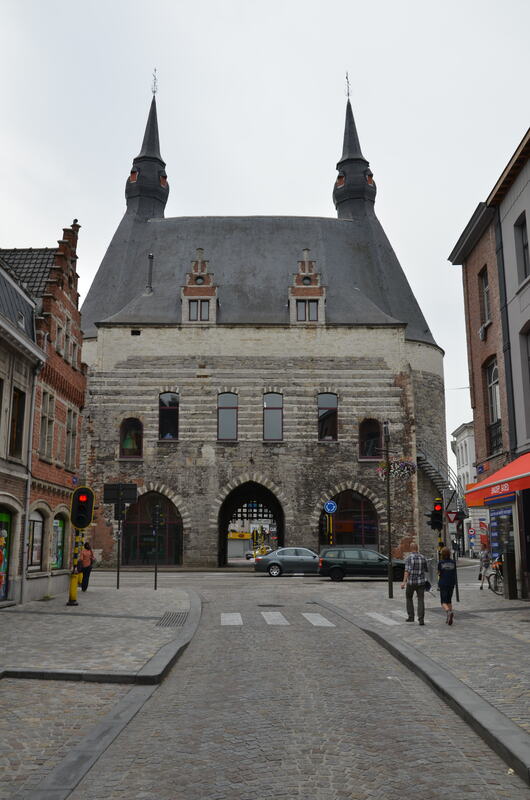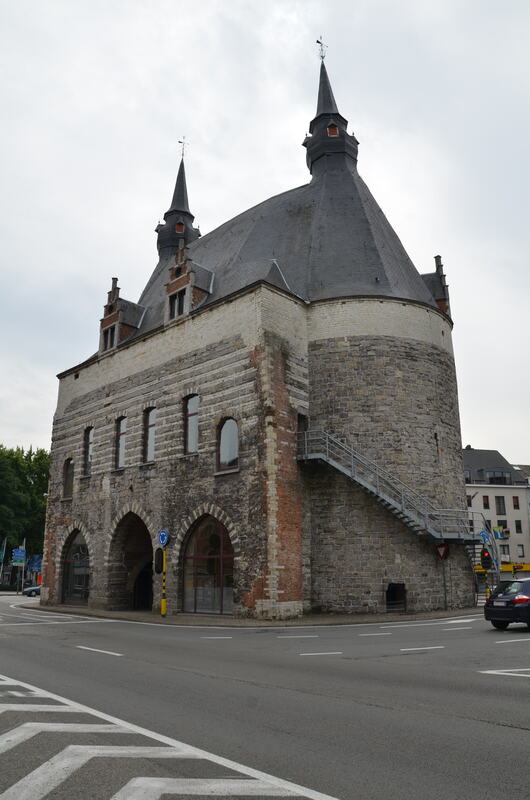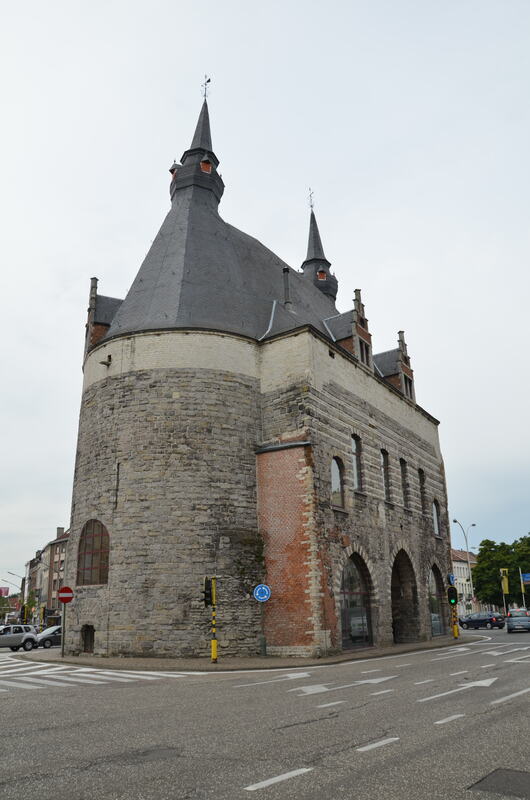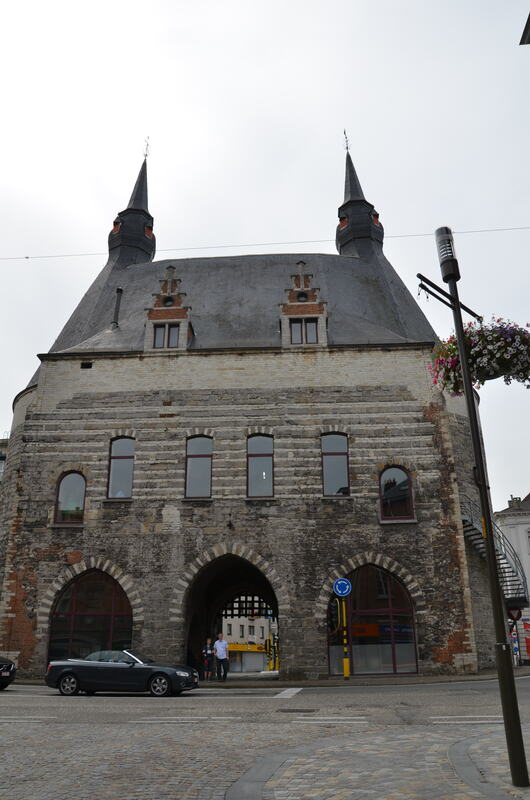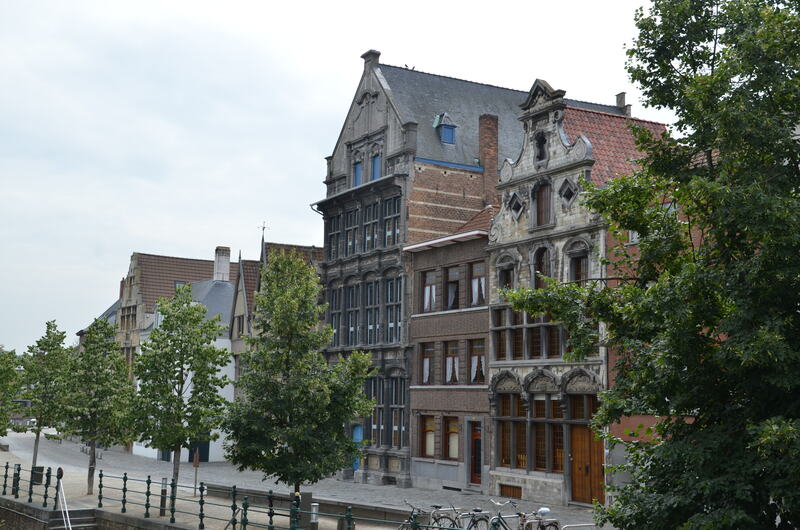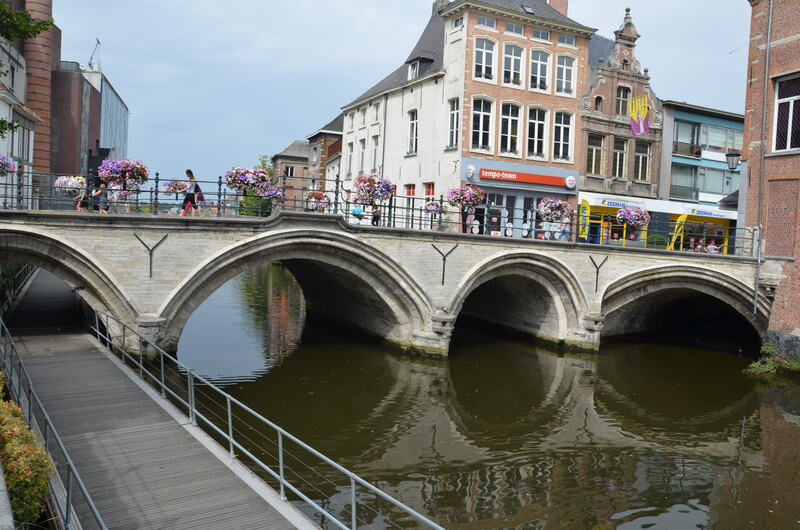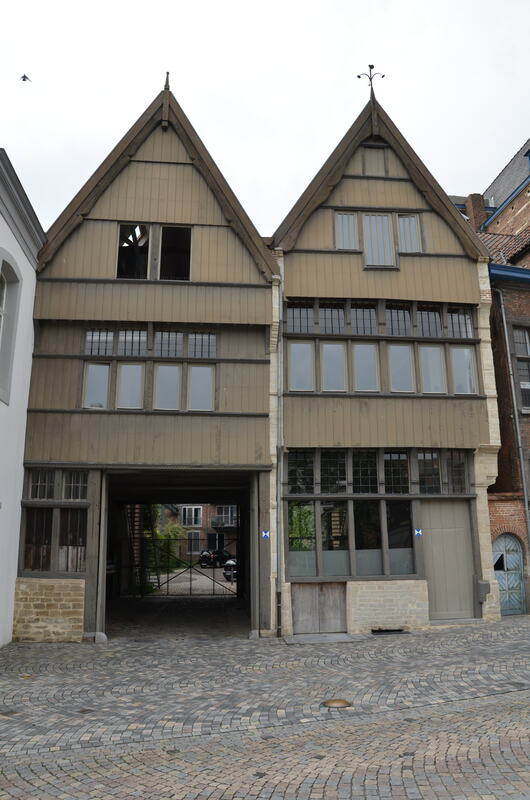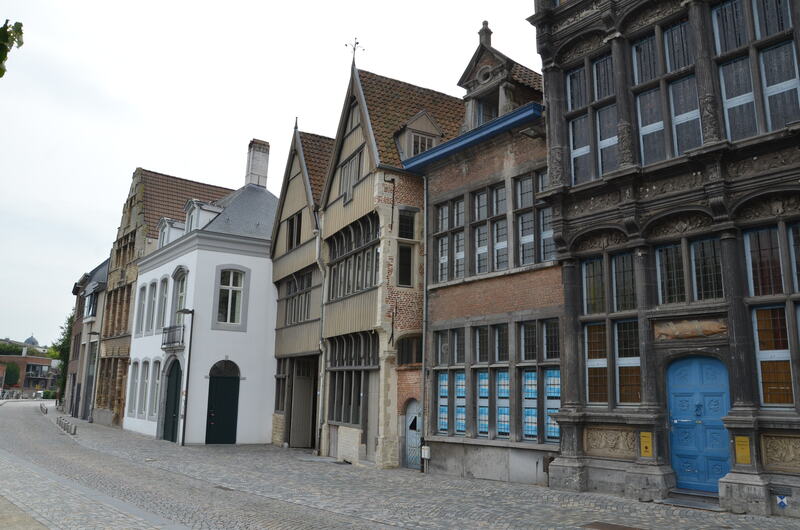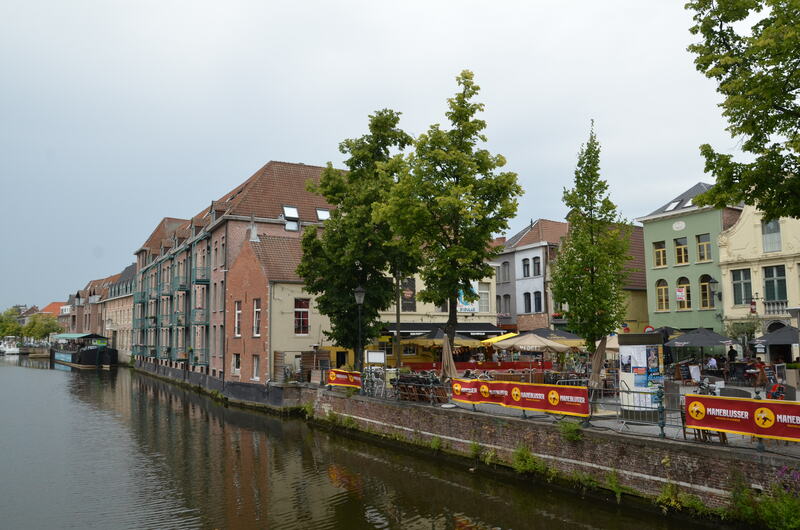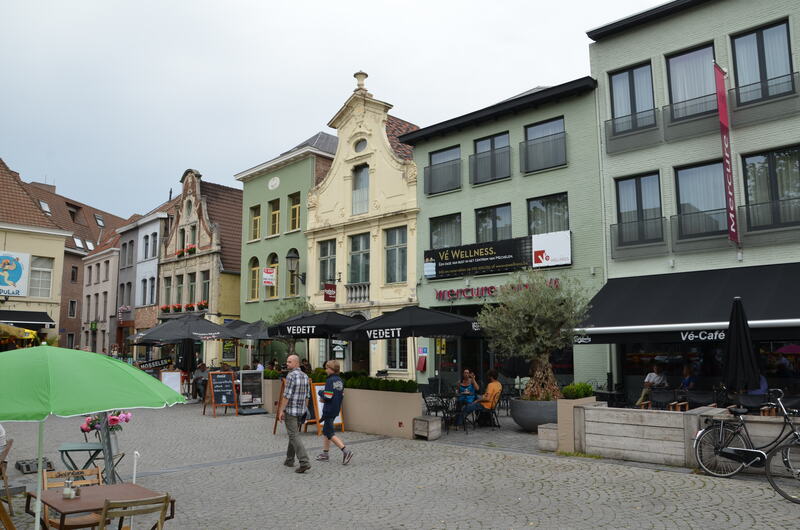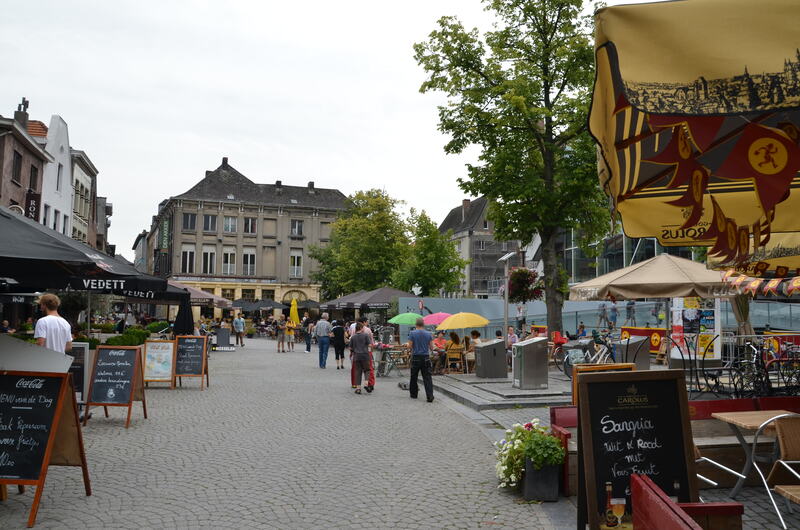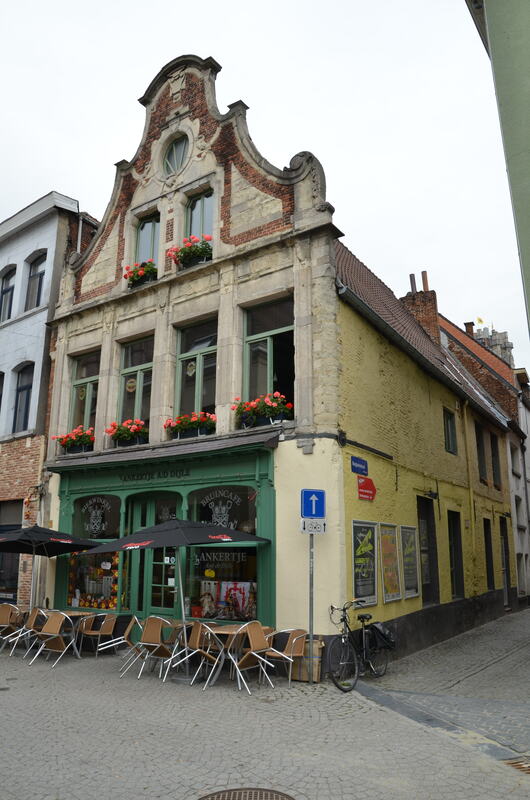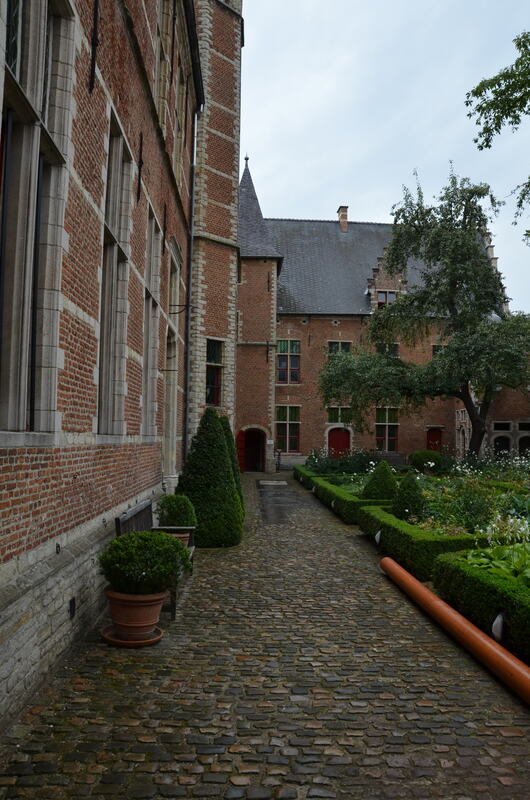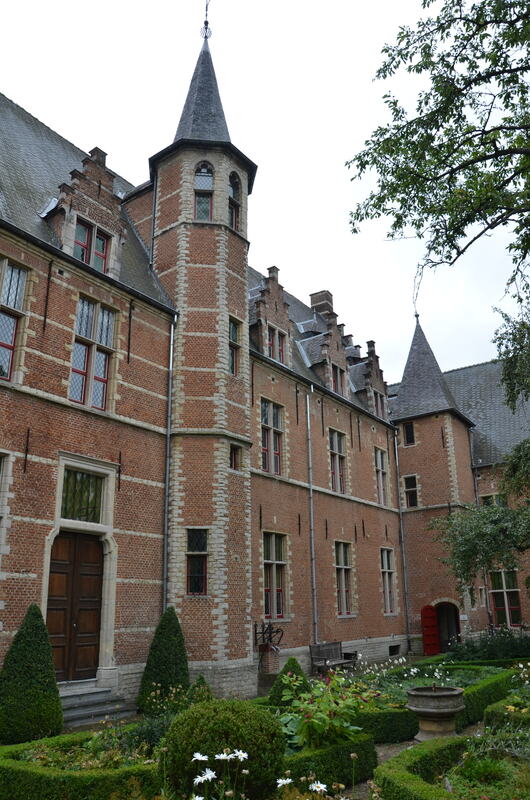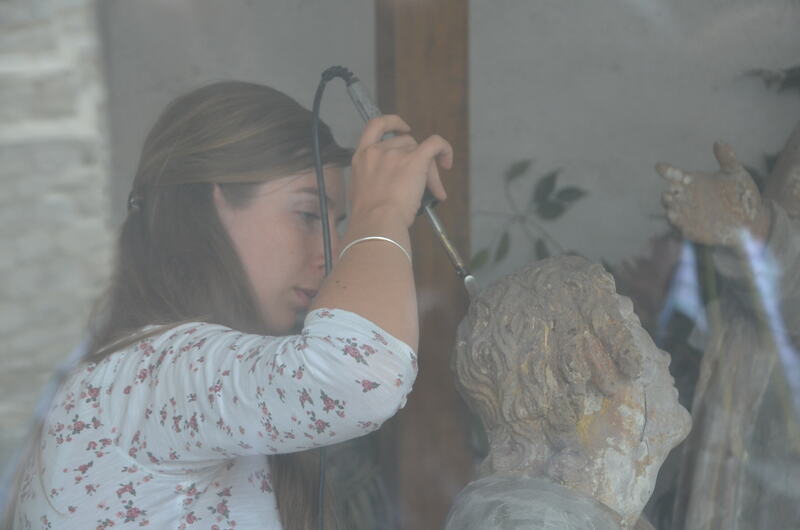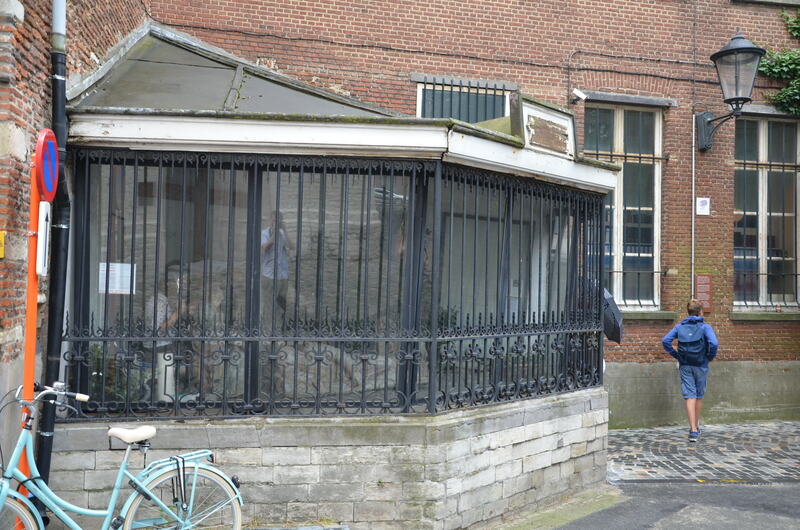Mechelen |
Vertical Divider
jest historycznie ważnym miastem, ulokowanym nad rzeką Dijle, w centrum Flandrii, w połowie drogi między Antwerpią i Brukselą. W Mechelen znajduje się siedziba prymasa Belgii. Głównym punktem orientacyjnym jest ogromna wieża katedry św. Rumbolda. Pomimo tego, że miasto bardzo ucierpiało podczas obu wojen światowych, zachowało się w nim wiele interesujących i pięknych budowli. Oprócz wymienionej wcześniej katedry św. Rumbolda na uwagę zasługują min: Pałac Małgorzaty Austriackiej, ratusz miejski, Pałac Małgorzaty z Yorku (obecnie teatr miejski), oraz wiele pięknych kamieniczek i kościołów.
|
Kościoły Mechelen
|
Katedra św. Rumbolda |
Vertical Divider
to największy skarb miasta. Ta majestatyczna gotycka budowla usytuowana jest po zachodniej stronie rynku, za budynkiem urzędu pocztowego. Jej początki datuje się na XIII wiek. Wtedy to, około 1217 roku, wykonano wschodnią część transeptu, zachodnie filary transeptu ukończono w 1230 roku. Budowę nawy z sześcioma łukami rozpoczęto w połowie XIII wieku. W XIV i XV wieku powstawało prezbiterium. Kościół św. Rumbolda został katedrą w 1559 roku.
|
W środku katedry, będącej jednym z najpiękniejszych kościołów w Belgii, znajdują się groby kardynałów. Jednym z nich był sławny kardynał Mercier. Najważniejszym skarbem katedry jest obraz Ukrzyżowanie Chrystusa, który namalował pochodzący z Antwerpii malarz Anton Van Dijck. Obraz stanowi fragment barokowego ołtarza, przeniesionego tu z innego kościoła, zrównanego z ziemią przez francuską armię republikańską. 18 maja 1985 roku Papież Jan Paweł II celebrował mszę w katedrze św. Rumbolda, w dniu swoich 65 urodzin.
Ogrom tej imponującej gotyckiej, trzynawowej katedry najłatwiej przedstawić liczbami:
|
|
|
Wnętrze katedry
Pomimo że wiele dzieł sztuki, stanowiących wyposażenie katedry, zostało skradzionych, podczas XVI-wiecznych wojen religijnych, oraz w wyniku grabieży dokonywanych przez Francuzów w 1792 i 1794 roku, nadal jest ona wypełniona arcydziełami. Na szczególną uwagę zasługują:
- Barokowa dębowa ambona, przedstawiająca nawrócenie św. Norberta, jest dowodem kunsztu ówczesnych snycerzy. Główna scena ukazuje św. Norberta po upadku z konia. Wypadek ten skłonił tego XII-wiecznego księcia do zrzeczenia się majątku i poświęcenia się kościołowi. Ambona przedstawia ziemski raj. Uważny obserwator zauważy misternie rzeźbione figury zwierząt: pelikana, wiewiórki, węży czy ślimaków. Autorem rzeźby jest Michiel Vervoort z Antwerpii (1667-1737). Szczegóły pulpitu wyrzeźbił Theodoor Vehagen (1701-1759). Ambona powstawała w latach (1721-1723). Oryginalnie stworzono ją dla kościoła sióstr norbertanek.
- W nawie bocznej prezbiterium znajdziemy 25 interesujących obrazów pochodzących z XV-XVI wieku, opisujących życie św. Rumbolda. Są to dzieła kilku nieznanych artystów, które powstały w latach 1480-1510.
- Na uwagę zasługują również rzeźby 12 apostołów i 4 ewangelistów, które dekorują filary nawy. Powstanie tych rzeźb datuje się na XVII wiek.
W prezbiterium znajduje się piękny marmurowy ołtarz główny, pochodzący z 1665 roku. Ołtarz zwieńczony jest posągiem przedstawiającym patrona katedry św. Rumbolda (statua ma 3,75 m wysokości). Ten majestatyczny, barokowy, dominujący nad chórem, ołtarz wykonany jest z białego marmuru oraz twardego czarnego kamienia. Jego twórcą jest Lucas Faydeherbe (1617-1697). Wykonał go według projektu, który stworzył Willem Hees lub Hesius (1601-1690).
Piękne ozdobne wrota głównego ołtarza, za którymi, w pozłacanym relikwiarzu, przechowywane są szczątki św. Rumbolda, wykonał A. Quellin Młodszy (1625-1700). Otwiera się je tylko w czasie najważniejszych świąt religijnych, kiedy relikwiarz obnoszony jest w procesji po centrum miasta. Relikwiarz wykonał, w 1825 roku, złotnik z Mechelen J. Fr. van Deuren.
Następnym dziełem w katedrze, stworzonym przez Lucasa Faydherbe, jest rzeźba na grobie arcybiskupa Andrew Cruesena, piątego arcybiskupa Mechelen, który umarł w Brukseli 8 listopada 1666 roku. Grobowiec znajduje się po lewej stronie ołtarza głównego. Został stworzony w latach, kiedy talent Lucasa Faydherbe osiągnął szczyty.
Następnym dziełem w katedrze, stworzonym przez Lucasa Faydherbe, jest rzeźba na grobie arcybiskupa Andrew Cruesena, piątego arcybiskupa Mechelen, który umarł w Brukseli 8 listopada 1666 roku. Grobowiec znajduje się po lewej stronie ołtarza głównego. Został stworzony w latach, kiedy talent Lucasa Faydherbe osiągnął szczyty.
Ten nagrobny monument składa się z kilku rzeźb. Po prawej stronie znajduje się rzeźba Chrystusa, piękny posąg, który stylem bezpośrednio nawiązuje do stylu Rubensa, mistrza i nauczyciela Lucasa Faydherbe. Po lewej stronie statua przedstawiająca Chronosa, w mitologii greckiej Boga czasu. Jest to swego rodzaju nawiązanie do śmierci, czegoś, co przeminęło.
W środku rzeźba arcybiskupa Andrew Creusena. Autor przedstawił go w pozycji klęczącej pomiędzy alegoryczną statuą zmartwychwstania, w postaci Chrystusa, która ma zwiastować nowe życie po śmierci, a Chronosem, Bogiem czasu. Czasu ziemskiego życia, które dla arcybiskupa już minęło.
W środku rzeźba arcybiskupa Andrew Creusena. Autor przedstawił go w pozycji klęczącej pomiędzy alegoryczną statuą zmartwychwstania, w postaci Chrystusa, która ma zwiastować nowe życie po śmierci, a Chronosem, Bogiem czasu. Czasu ziemskiego życia, które dla arcybiskupa już minęło.
Z racji tego, że katedra jest głównym budynkiem religijnym w Belgii, a Mechelen to siedziba arcybiskupstwa w kościele, oprócz wymienionego już arcybiskupa Creusena, znajdują się również groby innych arcybiskupów. Jednym z nich jest kardynał Joseph Mercier (1851-1926), który został mianowany arcybiskupem Mechelen w 1906 roku. Podczas Pierwszej Wojny Światowej mocno przeciwstawiał się niemieckiej okupacji, czym zyskał sobie szacunek Belgów. Zmarł w Brukseli w 1926 roku.
W południowym ramieniu transeptu znajduje się obraz Chrystus na krzyżu pędzla Antoona van Dycka (Anton van Dijck), również ucznia Piotra Pawła Rubensa. Jest to jedno z najwspanialszych dzieł znajdujących się w katedrze. Obraz jest częścią ciężkiego barokowego ołtarza, przeniesionego tutaj z kościoła zrównanego z ziemią przez francuską armię republikańską.
Warto również zwrócić uwagę na obraz Czarnej Madonny. Ma ona czarną twarz o europejskich rysach. Obraz Czarnej Madonny wiszący w katedrze jest również przedstawiony na pięknym witrażu.
Warto również zwrócić uwagę na obraz Czarnej Madonny. Ma ona czarną twarz o europejskich rysach. Obraz Czarnej Madonny wiszący w katedrze jest również przedstawiony na pięknym witrażu.
|
Adres:
Onder Den Toren 12 2800 Mechelen |
Godziny otwarcia:
poniedziałek-niedziela: 8.30-17.30 |
Cena biletu:
wstęp wolny |
|
Dzwonnica |
Vertical Divider
to kwadratowa gotycka budowla ze wspinającymi się w górę i przykrytymi sklepieniem pinaklami oraz niezwykłymi smukłymi oknami. W zamierzeniach twórców ta wspaniała budowla miała osiągnąć wysokość 167 metrów. Ostatecznie brak pieniędzy nie pozwolił na realizację planów i wieża, będąca chlubą Mechelen, stanęła na wysokości 97,28 metrów. Wyjście na szczyt wieży to nie lada wyzwanie. Jednak pokonanie 513 schodów pozwala na dotarcie do wspaniałego karylionu oraz na wejście na taras, z którego rozpościera się piękna panorama Mechelen.
|
Wspinając się na kolejne poziomy wieży, turyści mają okazję obejrzeć kościół z góry, przez szklaną szybę, poznać mechanizmy wprawiające w ruch wspaniały karylion, oraz usłyszeć wygrywaną przez niego melodię. Na ostatnim poziomie, dzięki wybudowanej szklanej platformie, można podziwiać wspaniałą panoramę miasta.
|
Adres:
Onder Den Toren 12 2800 Mechelen |
Godziny otwarcia:
poniedziałek-niedziela: 13.00-18.00 sobota: 10.00-18.00 |
Cena biletu:
8 Euro ostatnie wejście: 17.00 |
|
Kościół Our Lady across the Dyle |
Vertical Divider
to drugi największy kościół w Mechelen. Wielu bogatych mieszkańców fundowało tutaj swoje ołtarze. Niestety część wspaniałych skarbów wewnątrz kościoła zostało bezpowrotnie zniszczonych podczas bombardowań, które miały miejsce w czasie II Wojny Światowej.
|
W przeszłości kościół mógł rywalizować z katedrą św. Rumbolda nie tylko w wielkości, ale także w ilości wspaniałych skarbów wypełniających jego wnętrze. Współcześnie największym skarbem kościoła jest trzymetrowy tryptyk namalowany przez Piotra Pawła Rubensa, Cudowny połów ryb. Artysta namalował to dzieło, na zamówienie cechu rybaków, w 1620 roku.
Również XIV-wieczna rzeźba Matki Boskiej z krzywymi biodrami jest dumą kościoła. Rzeźba ta jest jedynym wolno stojącym posągiem z tego okresu w Mechelen, a jej nazwa wzięła się z charakterystycznej postawy Maryi na statule. Znacznie więcej znajduje się tutaj rzeźb i obrazów z XVII i XVIII wieku.
Również XIV-wieczna rzeźba Matki Boskiej z krzywymi biodrami jest dumą kościoła. Rzeźba ta jest jedynym wolno stojącym posągiem z tego okresu w Mechelen, a jej nazwa wzięła się z charakterystycznej postawy Maryi na statule. Znacznie więcej znajduje się tutaj rzeźb i obrazów z XVII i XVIII wieku.
Również kilka rzeźb Matki Boskiej przyciąga uwagę zwiedzających, zwłaszcza posąg Matki Boskiej od siedmiu boleści, który stworzył Antoon Faydherbe, w 1653 roku. Równie ciekawe są XVI-wieczne freski przedstawiające biblijną przypowieść o synu marnotrawnym, czy barokowa ambona, którą wykonał Willem Ignatius Kerrikx (1682-1745). Natomiast barokowy ołtarz główny to dzieło Antoon Pastorana (1640-1702). Zdobi go obraz Ostatnia wieczerza, który namalował Jan Erasmus Quellinus (1634-1715).
|
Adres:
Onze-Lieve-Vrouwestraat 87 2800 Mechelen |
Godziny otwarcia:
poniedziałek-niedziela: 13.00-17.00 środa: zamknięte |
Cena biletu:
wstęp wolny |
|
Kościół św. Jana
(sint Janskerk) |
Vertical Divider
powstał na terenach najbogatszej części Mechelen, w miejscu, gdzie zamieszkiwali członkowie Wielkiej Rady (Sądu Najwyższego w Niderlandach w XVI wieku). Znajduje to odzwierciedlenie w licznych dziełach wewnątrz kościoła.
|
Niewątpliwie największym skarbem w świątyni jest wspaniały, barokowy tryptyk Piotra Pawła Rubensa. Pięknie wykonany środkowy panel przedstawia Pokłon trzech mędrców. Za bocznymi panelami znajduje się mechanizm do obracania obrazów w regularnych odstępach czasu, tak że można oglądać wszystkie sceny.
Twarz kobiety na środkowym panelu to twarz pierwszej żony Rubensa, Izabelli Brant. Boczne panele w sposób bardzo obrazowy pokazują śmierć św. Jana Chrzciciela (poprzez ścięcie głowy) i św. Jana Ewangelisty (polewanie olejem). Obrazy po zewnętrznej stronie tryptyku ukazują Chrzest Chrystusa i św. Jana z Patmos.
Twarz kobiety na środkowym panelu to twarz pierwszej żony Rubensa, Izabelli Brant. Boczne panele w sposób bardzo obrazowy pokazują śmierć św. Jana Chrzciciela (poprzez ścięcie głowy) i św. Jana Ewangelisty (polewanie olejem). Obrazy po zewnętrznej stronie tryptyku ukazują Chrzest Chrystusa i św. Jana z Patmos.
W kościele znajdziemy również rzeźby wielu znaczących XVII, XVIII-wiecznych artystów z Mechelen:
Lucas Faydherbe (1617-1697) stworzył monument nagrobny na grobie Rombouta Huensa. Rzeźbę Madonna z Dzieciątkiem, będącą częścią konfesjonału, wykonał Nikolaas van der Veken (1637-1709). Theodoor Verhaegen (1701-1759) zaprojektował ołtarz, w który wkomponowano tryptyk Rubensa. Rzeźby do tego ołtarza wykonał Pieter Valckx (1734-1785). Ambona, obudowa organów, oraz kilka ławek to również jego dzieło.
Lucas Faydherbe (1617-1697) stworzył monument nagrobny na grobie Rombouta Huensa. Rzeźbę Madonna z Dzieciątkiem, będącą częścią konfesjonału, wykonał Nikolaas van der Veken (1637-1709). Theodoor Verhaegen (1701-1759) zaprojektował ołtarz, w który wkomponowano tryptyk Rubensa. Rzeźby do tego ołtarza wykonał Pieter Valckx (1734-1785). Ambona, obudowa organów, oraz kilka ławek to również jego dzieło.
|
Adres:
Sint-Janskerkhof 1 2800 Mechelen |
Godziny otwarcia:
poniedziałek-niedziela: 13.00-17.00 środa: zamknięte |
Cena biletu:
wstęp wolny |
Kościół św. Katarzyny (sint Katelijnekerk) zbudowano w XIV wieku na terenie uboższej części Mechelen, zamieszkiwanej przez biedotę, co odzwierciedla się w skali kościoła i dość skromnym wystroju wnętrza. Należy jednak zaznaczyć, że wykonane z drewna rzeźby i meble są godne uwagi. Ołtarz to dzieło Josepha Lucasa Faydherbe (1617-1697). Ambonę wykonał Verhaegen (1701-1759), rzeźby, którymi jest pokryta stworzył Pieter Valcx (1734-1785). Charakterystyczne dla tego regionu, wykonane w bardzo dekoracyjny sposób, stalle wyrzeźbił Nicolaas Van der Veken (1637-1704). Pochodzące z XIX wieku witraże przedstawiają sceny z życia św. Katarzyny.
W kościele znajduje się wiele odniesień do św. Katarzyny, mitycznej postaci z okresu rzymskiego. Legenda głosi, że odmówiła wyrzeczenia się wiary chrześcijańskiej, za co cesarz skazał ją na śmierć na kole. Jednak to nie św. Katarzyna została złamana, a samo koło. Ostatecznie władze stwierdziły, że św. Katarzyna powinna być ścięta. Znowu jednak wydarzyło się coś niezwykłego. Z rany na szyi Katarzyny popłynęło mleko, które zaczęło rozprzestrzeniać plagę w mieście. Inne odniesienia do św. Katarzyny można znaleźć w dwunastu rozetowych oknach w nawie, przypominających swym kształtem narzędzie, którym torturowano św. Katarzynę, oraz w pięknym rozetowym oknie w fasadzie.
|
Adres:
Sint-Katelijnestraat 78 2800 Mechelen |
Godziny otwarcia:
poniedziałek-niedziela: 13.00-17.00 środa: zamknięte |
Cena biletu:
wstęp wolny |
|
Kościół w beginażu (Begijnhofkerk) |
Vertical Divider
Budowę kościoła zapoczątkował architekt z Brukseli Jacques Franquart. Po jego śmierci prace, od 1640 roku, kontynuował Lucas Faydherbe. W 1674 roku kościół był gotowy. Na zewnątrz Faydherbe stworzył rzeźbę z marmuru, przedstawiającą postać św. Katarzyny, a powyżej postać Boga Ojca. Rzeźba św. Katarzyny wydatnie ucierpiała podczas rewolucji. Jej głowę całkowicie zniszczono. Została ona zastąpiona tą wyrzeźbioną przez Brocksteynsa, pupila Faydherbe.
|
Można stwierdzić, iż kościół ten, którego oficjalna nazwa brzmi Sint-Alexius-en-Catharinakerk, jest najbardziej sfeminizowanym kościołem w Mechelen. W przeciwieństwie do katedry św. Rumbolda, w którym dominują symbole męskie. Wielki barokowy ołtarz wykonany z czarno białego marmuru jest dziełem Jana Van der Steen. W ołtarzu występują naprzemiennie dwa obrazy. Pierwszy to obraz Małżeństwo św. Katarzyny, będący dziełem Boyermansa. Drugi obraz to dzieło Lucasa Francois pod tytułem Wniebowzięcie Najświętszej Marii Panny. Pierwszy z nich można oglądać w wielkim ołtarzu od świąt wielkanocnych aż po dzień wszystkich świętych, drugi od dnia wszystkich świętych do świąt wielkanocnych.
Ponad ołtarzem zwracają uwagę trzy obrazy, których autorem jest Jan Cossiers. W środku obraz przedstawiający Chrystusa na krzyżu a po bokach obrazy, na których uwieczniono wiszących na krzyżach złodziei. Wewnątrz kościoła znajduje się około 50 malowideł pochodzących z XVII wieku. Kolory zdobiące wnętrze kościoła pochodzą z 1910 roku. Kościół wraz z całym beginażem został wpisany na Listę Światowego Dziedzictwa UNESCO.
|
Adres:
Nonnenstraat 28 2800 Mechelen |
Godziny otwarcia:
poniedziałek-niedziela: 13.00-16.00 środa: zamknięte |
Cena biletu:
wstęp wolny |
Kościół św. Piotra i Pawła (sint Pieter en Paulkerk) - ten piękny, harmonijny barokowy kościół został poświęcony przez jezuitów. Jego patronami byli św. Ignacy i św. Franciszek Ksawery. Po likwidacji zakonu jezuitów na tym terenie parafia św. Piotra i Pawła poprosiła o przekazanie jej tego kościoła, ponieważ ich własna świątynia była w złym stanie. Od tego czasu kościół nosi nazwę św. Piotra i Pawła.
Wnętrze kościoła jest bogato zdobione. Wspaniała ambona przypomina dzieło misyjne św. Franciszka Ksawerego, prowadzone w czterech zakątkach świata. W owym czasie (XVI wiek) nie było jeszcze wiedzy o istnieniu Oceanii, piątego kontynentu. Czternaście konfesjonałów wbudowanych w ściany kościoła są dobrym przykładem umiejętności rzeźbiarzy z Mechelen. Jak głosi legenda, tak duża liczba konfesjonałów wynika z bliskości placu targowego (plac, na którym sprzedawano bydło), a tam aż roiło się od oszustów. Prawda jest jednak zupełnie inna. Kościół św. Piotra i Pawła pierwotnie był kościołem pielgrzymkowym, zawierającym liczne relikwie. Mogli ich dotykać jedynie ludzie wolni od grzechu. Stąd duża liczba konfesjonałów.
Wnętrze kościoła jest bogato zdobione. Wspaniała ambona przypomina dzieło misyjne św. Franciszka Ksawerego, prowadzone w czterech zakątkach świata. W owym czasie (XVI wiek) nie było jeszcze wiedzy o istnieniu Oceanii, piątego kontynentu. Czternaście konfesjonałów wbudowanych w ściany kościoła są dobrym przykładem umiejętności rzeźbiarzy z Mechelen. Jak głosi legenda, tak duża liczba konfesjonałów wynika z bliskości placu targowego (plac, na którym sprzedawano bydło), a tam aż roiło się od oszustów. Prawda jest jednak zupełnie inna. Kościół św. Piotra i Pawła pierwotnie był kościołem pielgrzymkowym, zawierającym liczne relikwie. Mogli ich dotykać jedynie ludzie wolni od grzechu. Stąd duża liczba konfesjonałów.
|
Adres:
Keizerstraat 1 2800 Mechelen |
Godziny otwarcia:
poniedziałek-niedziala: 13.00-17.00 środa: zamknięte |
Cena biletu:
za darmo |
Kościół Matki Boskiej z Hanswijk (Onze Lieve Vrouw van Hanswijkbasiliek)
|
XVII-wieczna bazylika łączy potrójną nawę z jedną z pierwszych w Niderlandach kopuł. Kościół zaprojektował Lucas Faydherbe, niestety fundamenty były zbyt słabe, aby unieść dużo wyższą kopułę, która była w jego zamierzeniach. Rotunda ma średnicę 15,50 m, a kopuła wznosi się na 34 metry.
Wewnątrz kościoła, pod kopułą znajdują się dwie ogromne płaskorzeźby. To dzieło Lucasa Faydherbe. Jak wierzono, miały one być wykonane z piaskowca. Kiedy płaskorzeźby zostały uszkodzone w wyniku bombardowania podczas II Wojny Światowej, na jaw wyszło, iż do ich stworzenia Faydherbe nie użył zbyt ciężkiego, jego zdaniem, piaskowca, ale lekkiego gipsu. W przedniej części kościoła znajduje się cudowna rzeźba Matki Boskiej z Hanswijk, która jest noszona ulicami miasta w corocznej procesji. W 1985 roku Papież Jan Paweł II modlił się w tym kościele. Dwa lata później został on podniesiony do rangi bazyliki mniejszej. Wewnątrz kościoła na uwagę zasługują również barokowa ambona, którą stworzył Theodoor Verhaegen, oraz barokowe konfesjonały wykonane przez Jana Franciszka Boeckstuynsa. |
|
Adres:
Hanswijkstraat 67 2800 Mechelen |
Godziny otwarcia:
poniedziałek-niedziela: 9.00-17.00 |
Cena biletu:
wstęp wolny |
|
Kościół Matki Boskiej z Leliendaal
(Onze Lieve Vrouw van Leliëndaalkerk) XVII-wieczny barokowy kościół, który był częścią klasztoru norbertanek. Był to pierwszy poważny indywidualny projekt architektoniczny Lucasa Faydherbe. Podczas Rewolucji Francuskiej i wojen napoleońskich kościół został pozbawiony większości swoich ozdób. Piękna oryginalna ambona została przeniesiona do katedry św. Rumbolda, gdzie można ją podziwiać do dnia dzisiejszego. Od 1900 roku kościół służy zakonowi jezuitów. Stąd ikonografia jezuitów dominuje w tym byłym kościele sióstr norbertanek. Postać św. Ignacego Loyoli na fasadzie, obraz w ołtarzu głównym, oraz wszechobecna Maryja są przykładami wpływu jezuitów. Na szczególną uwagę w kościele zasługuje ołtarz Lucasa Faydherbe oraz niektóre płaskorzeźby. |
|
Adres:
Bruul 53 2800 Mechelen |
Godziny otwarcia:
poniedziałek-sobota: 9.00-17.00 niedziela: 12.30-17.00 |
Cena biletu:
za darmo |
|
Beginaże |
Vertical Divider
W 1245 roku pojawiła się pierwsza wzmianka o beginkach w Mechelen. Mieszkały one w beginażach, miały wiele wspólnego z siostrami. Podobnie jak one zamieszkiwały w zamkniętej społeczności, ślubowały posłuszeństwo, czystość, ale nie ubóstwo.
W średniowieczu Beginki były niezamężnymi kobietami, które poświęcały swe życie Bogu, bez składania ślubów zakonnych. W XIII wieku zakładały zamknięte wspólnoty (beginaże), odpowiadające ich potrzebom duchowym i materialnym. |
Domy beginek we Flandrii tworzą zespoły architektoniczne złożone z domów mieszkalnych, kościołów, budynków gospodarczych oraz terenów zielonych, zgodnie z koncepcją przestrzenną miasta lub wsi na terenie, której się znajdują. Zbudowane są w stylu typowym dla flamandzkiego regionu kulturowego i stanowią cenne świadectwo tradycji beginek, która rozwinęła się w średniowieczu, w Europie Północno-Zachodniej.
Beginaże powstawały w okresie krucjat, kiedy to wielu mężczyzn nie wracało z wypraw. Były to swego rodzaju miasta w mieście. Posiadały własną piekarnię, browar, dom pielęgniarek czy kościół. Beginażem zarządzała tzw. Grand Mistress, która organizował codzienne życie beginek.
Beginaże powstawały w okresie krucjat, kiedy to wielu mężczyzn nie wracało z wypraw. Były to swego rodzaju miasta w mieście. Posiadały własną piekarnię, browar, dom pielęgniarek czy kościół. Beginażem zarządzała tzw. Grand Mistress, która organizował codzienne życie beginek.
Bogate oraz pochodzące z arystokratycznych rodzin beginki mogły wybudować własny dom w beginażu lub go kupić. Biedniejsze beginki wynajmowały w takich domach pokoje i często stawały się w nich służbą. Mogły także zamieszkać w tzw. konwentach, wybudowanych za pieniądze bogatych sponsorów. Beginki tu mieszkające miały w zamian modlić się za darczyńcę lub jego rodzinę. Biedniejsze beginki, aby się utrzymać, musiały pracować. Dlatego rozwinęło się tutaj wyrabianie koronek. Beginki włożyły wielki wkład w rozwój koronkarstwa w Mechelen.
Od 1286 roku w Mechelen były dwa beginaże. Duży beginaż został zbudowany na zewnątrz murów miejskich (na zewnątrz Gatherine Gate-Katelijnepoort), ale pod koniec XVI wieku beginki przeniosły się wewnątrz murów miejskich. Natomiast mały beginaż zawsze znajdował się wewnątrz murów, w sąsiedztwie kościoła św. Katarzyny.
Od 1286 roku w Mechelen były dwa beginaże. Duży beginaż został zbudowany na zewnątrz murów miejskich (na zewnątrz Gatherine Gate-Katelijnepoort), ale pod koniec XVI wieku beginki przeniosły się wewnątrz murów miejskich. Natomiast mały beginaż zawsze znajdował się wewnątrz murów, w sąsiedztwie kościoła św. Katarzyny.
|
|
Kościół w beginażu
|
|
W późniejszym czasie w pobliżu Mechelen rozpoczęto budowę kościoła, który wkrótce został ukończony. Naokoło świątyni zaczęły powstawać domy. Ich liczba przyrastała w bardzo dużym tempie tak, że w krótkim czasie utworzyło się tu małe miasto zamieszkiwane przez kilka tysięcy Beginek i całe otoczone murem. W 1572 roku heretycy podłożyli ogień pod beginaż. Jednak wyrządził on tylko nieznaczne szkody. Niestety, kilka lat później, splądrowali oni Beginaż, niszcząc go prawie całkowicie. Cywilne wojny obróciły Beginaż w ruinę, dlatego Beginki w 1595 roku zakupiły część gruntów wewnątrz murów miejskich i zapoczątkowały budowę kościoła. Prowadził ją Jacques Franquart, architekt z Brukseli, który jednak zmarł przed dokończeniem budowy. W 1640 roku Lucas Faydherbe zobowiązał się kontynuować budowę kościoła i ukończył ją w 1674 roku.
W czasach świetności w beginażach Mechelen żyło nawet 2000 beginek. Ostatnia beginka zamieszkująca beginaż zmarła pod koniec XX wieku. Z pierwszego dużego beginażu poza murami miasta, który został zniszczony, nic nie pozostało. Natomiast ten z XVI wieku jest dobrze zachowany. Różni się on znacznie od beginaży z Antwerpii, Brugii czy Leuven. Istniejące budynki z cegły i piaskowca pochodzą z okresu od XVI do XVIII wieku. Zamknięty charakter beginażu, jak to jest w innych miastach, może być tutaj wyczuwalny tylko dzięki wąskim uliczkom. Bramy oraz mury oddzielające beginaż od świata zewnętrznego zostały zniszczone w XVIII wieku. Wtedy też w beginażu zaczęli zamieszkiwać świeccy mieszkańcy Mechelen.
Spacer wąskimi uliczkami dużego beginażu sprawia naprawdę wielką przyjemność. Cisza i odosobnienie pozwalają na odpoczynek od wielkomiejskiego zgiełku. Dla wielbicieli piwa ukoronowaniem tego spaceru będzie zapewne wizyta w istniejącym na terenie beginażu browarze Het Anker.
Spacer wąskimi uliczkami dużego beginażu sprawia naprawdę wielką przyjemność. Cisza i odosobnienie pozwalają na odpoczynek od wielkomiejskiego zgiełku. Dla wielbicieli piwa ukoronowaniem tego spaceru będzie zapewne wizyta w istniejącym na terenie beginażu browarze Het Anker.
|
Adres: Nonnenstraat 28 2800 Mechelen |
Godziny otwarcia: poniedziałek-niedziela: 13.00-16.00 środa: zamknięte |
Cena biletu: wstęp wolny |
|
Browar Het Anker
|
Vertical Divider
Spacerując uroczymi uliczkami, wpisanego na listę Światowego Dziedzictwa UNESCO, dużego beginażu warto odwiedzić browar Het Anker. Można tutaj skosztować wszystkich warzonych w browarze trunków. Na terenie browaru znajduje się również sklep firmowy.
Przez lata browar Het Anker zdobył wiele międzynarodowych nagród, włącznie ze zdobyciem trzy razy nagrody World Beer Award, ostatnio w 2012 roku. Aktualnie piwa z tego browaru eksportowane są do 30 krajów na całym świecie. |
Historia browaru:
Założony w roku 1369 browar Het Anker jest jednym z najstarszych browarów w Belgii. Część budynków na terenie browaru pochodzi z XV i XVI wieku. W 1471 roku ówczesny władca Karol Śmiały (the Bold) zdecydował, że beginki nie będą musiały płacić podatków za piwo warzone dla pobliskiego szpitala.
W roku 1872 browar został kupiony przez rodzinę Van Breedam i zmodernizowany. Stare wysłużone kotły (kadzie) zastąpiono nowymi parowymi. W 1990 roku rodzina Van Breedam ponownie przejęła browar i dokonała jego modernizacji.
W roku 1872 browar został kupiony przez rodzinę Van Breedam i zmodernizowany. Stare wysłużone kotły (kadzie) zastąpiono nowymi parowymi. W 1990 roku rodzina Van Breedam ponownie przejęła browar i dokonała jego modernizacji.
|
Adres:
Brouwerij Het Anker, Guido Gezellelaan 49, 2800 |
Godziny otwarcia:
wtorek-czwartek: 11.00-12.30 piątek: 11.00-14.30 sobota-niedziela: 11.00-16.30 |
Cena biletu:
9 Euro |
|
Małgorzata Austriacka (1480-1530) |
Vertical Divider
Pałac, z którego przez lata zarządzała Niderlandami, mieści się przy ulicy Keizerstraat. Wybudowano go w gotyckim stylu z wczesno-renesansowymi cechami. W latach 1616-1795 miał tutaj swoją siedzibę Sąd Najwyższy. Od XVII wieku urzęduje tutaj sąd miejski.
|
Po śmierci Małgorzaty z Yorku w Mechelen nastały czasy Małgorzaty Austriackiej. Kiedy 7 lipca 1506 roku, po mianowaniu regentką Niderlandów, Małgorzata Austriacka obejmowała rządy w Mechelen, przywiozła z sobą piękną i bogatą kolekcję arrasów. Wiele z nich było darami, które otrzymała podczas swojego wieloletniego pobytu we Francji. Być może ich posiadanie rozwinęło w Małgorzacie miłość do sztuki i do kolekcjonerstwa.
Pałac, który stworzyła w Mechelen (the Hof van Savoge) pełnił nie tylko kluczową rolę polityczną w imperium Habsburgów, ale także był centrum spotkań wybitnych artystów epoki, takich jak Erazm z Rotterdamu. W czasach panowania Małgorzaty Austriackiej w Mechelen osiadały bogate i sławne rody, budując tu swoje rezydencje. Jedną z najlepiej zachowanych jest the Hof van Busleyden, gdzie teraz mieści się muzeum miejskie.
Pałac, który stworzyła w Mechelen (the Hof van Savoge) pełnił nie tylko kluczową rolę polityczną w imperium Habsburgów, ale także był centrum spotkań wybitnych artystów epoki, takich jak Erazm z Rotterdamu. W czasach panowania Małgorzaty Austriackiej w Mechelen osiadały bogate i sławne rody, budując tu swoje rezydencje. Jedną z najlepiej zachowanych jest the Hof van Busleyden, gdzie teraz mieści się muzeum miejskie.
Małgorzata była aktywną patronką artystów. Posiadała piękne zbiory biżuterii, obrazów takich mistrzów malarstwa jak Jan Van Eyck, rzeźb, pięknych i drogich arrasów, mebli i medali. Przez lata na dworze zatrudniała wielu artystów, rzeźbiarzy, architektów, takich jak: Conrad Meit czy Loys Van Boghem. Małgorzata równie aktywnie wspierała rozwój literatury i muzyki. To zainteresowanie odzwierciedlało się w jej przebogatych zbiorach książek, mszałów i iluminowanych manuskryptów, do których zalicza się uznawany za jeden z najpiękniejszych francuskich, gotyckich manuskryptów Tres Riches Heures. Zbiory te przetrzymywała w bogato dekorowanej bibliotece.
Wspaniały ogród wewnątrz rezydencji Małgorzaty Austriackiej można podziwiać od poniedziałku do piątku w godzinach od 7.30 do 18. W sobotę i niedzielę od 9 do 20.
Wspaniały ogród wewnątrz rezydencji Małgorzaty Austriackiej można podziwiać od poniedziałku do piątku w godzinach od 7.30 do 18. W sobotę i niedzielę od 9 do 20.
SPACER ULICAMI MECHELEN
Warto wybrać się na spacer wzdłuż pięknych kanałów oplatających Mechelen, zwłaszcza że miasto przygotowało ścieżki w naprawdę profesjonalny sposób. Można spacerować godzinami, podziwiając zabytkową architekturę i piękne widoki, a zmęczeni długą wędrówką zapewne zaglądną do jednej z wielu restauracji czy knajpek, których na tym szlaku nie brakuje.
Jednym z obowiązkowych punktów turystycznych jest ostatnia istniejąca brama miejska, zwana bramą brukselską. Jest ona zachowana w doskonałym stanie, niestety nie jest otwarta dla zwiedzających, Warto jednak oddalić się troszkę od ścisłego centrum Mechelen, żeby ją zobaczyć.
Zmierzając w kierunku bramy brukselskiej, przechodzimy przez Wielki Most, zwany czasami Dużym Mostem lub Wysokim Mostem. Łączy on Ijzerenleen z Korenmarkt. Ten uroczy most zbudowano z piaskowca w XIII wieku. Jest to najstarszy kamienny most we Flandrii. W przeszłości był tutaj punkt poboru opłat. W okolicy mostu znajduje się wiele uroczych XVI-wiecznych kamieniczek.
Podczas spaceru promenadą wzdłuż kanałów warto dotrzeć do placu rybnego (Vismarkt). Pierwszy raz rozpoczęto handel rybami na tym placu w roku 1531, kiedy to przeniesiono kupców handlującymi rybami z ulicy Ijzerenleen, z powodu skarg mieszkańców na zapach sprzedawanych ryb. Po dziś dzień na placu znajdziemy kilka sklepów rybnych. Zarówno plac rybny, jak i przylegająca do niego ulica Nauwstraat są bardzo aktywne we wczesnych godzinach. Znajdziemy tu wiele kawiarni, stylowych barów czy miłych restauracji. Może to być bardzo miły przystanek podczas spaceru ulicami Mechelen.
Podczas zwiedzania Mechelen warto czasem zboczyć z utartego szlaku, skręcić w nieznane miejsca. Można wtedy dotrzeć do pięknych zakątków, ze wspaniałymi ogrodami, jak te w XVI-wiecznych domach uchodźców, lub trafić na miejsca takie jak to w pobliżu kościoła św. Jana gdzie można przyglądać się pracy restauratorów zabytków.
|
Koszary Dossin |
Vertical Divider
Koszary Dossin to bardzo szczególne miejsce w historii Belgii. W czasie II Wojny Światowej 25.000 Żydów i Cyganów oczekiwało w tym obozie na swoją ostatnią podróż do komór gazowych Auschwitz. W miejscu obozu wybudowano muzeum, które ma przypominać o okropieństwach wojny. Muzeum zaprojektował czołowy architekt belgijski, Bob van Reeth.
|
|
Adres:
Goswin de Stassartstraat 153
2800 Mechelen https://www.kazernedossin.eu |
|
